
Magic of Morocco
February 27 - March 8, 2022
Mike and Judy Henderson
I'm going to leave the trip map at the beginning of each page so you can see where we are.

+++++++++++++++++++++++++++++++++++++++++++++++++++++++++++
3/5/2022 (Saturday) This morning, we drove to the Kutubiyya Mosque, whose minaret is often called the symbol of Marrakesh. The minaret is 77 meters in height and is highly decorated. Nourdine is leading us toward the minaret and the mosque.
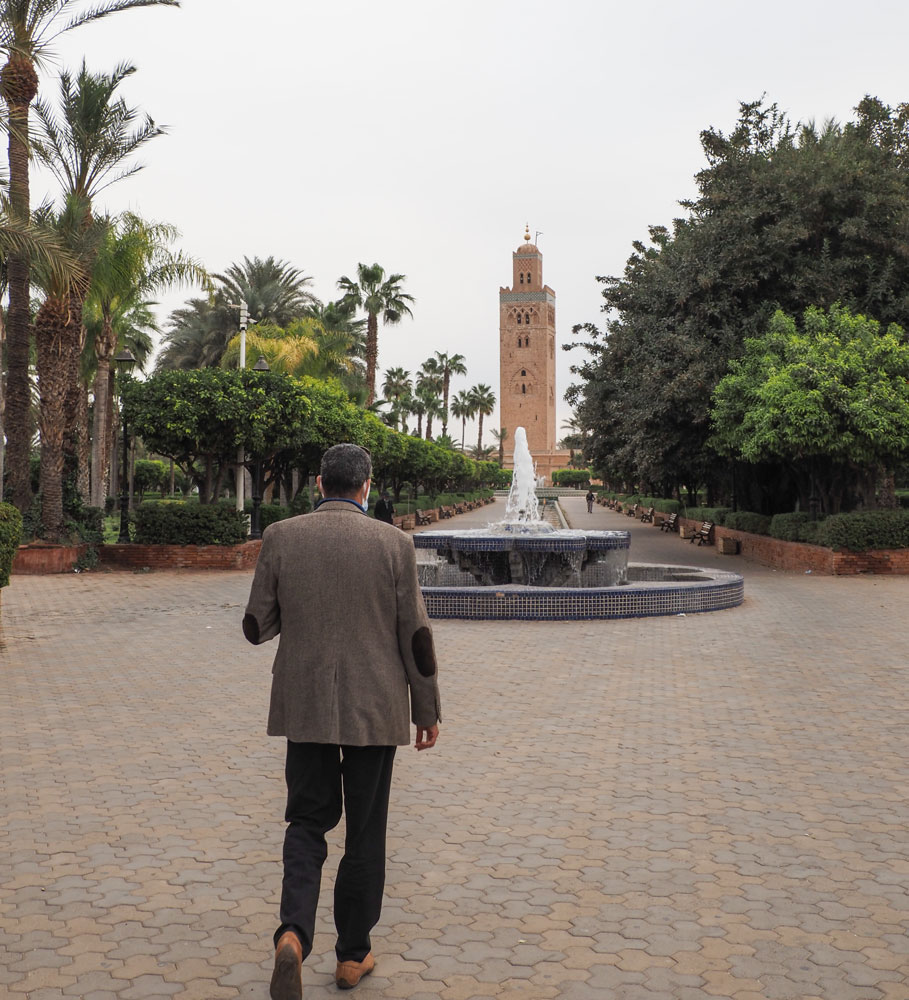
A closer view of the minaret.
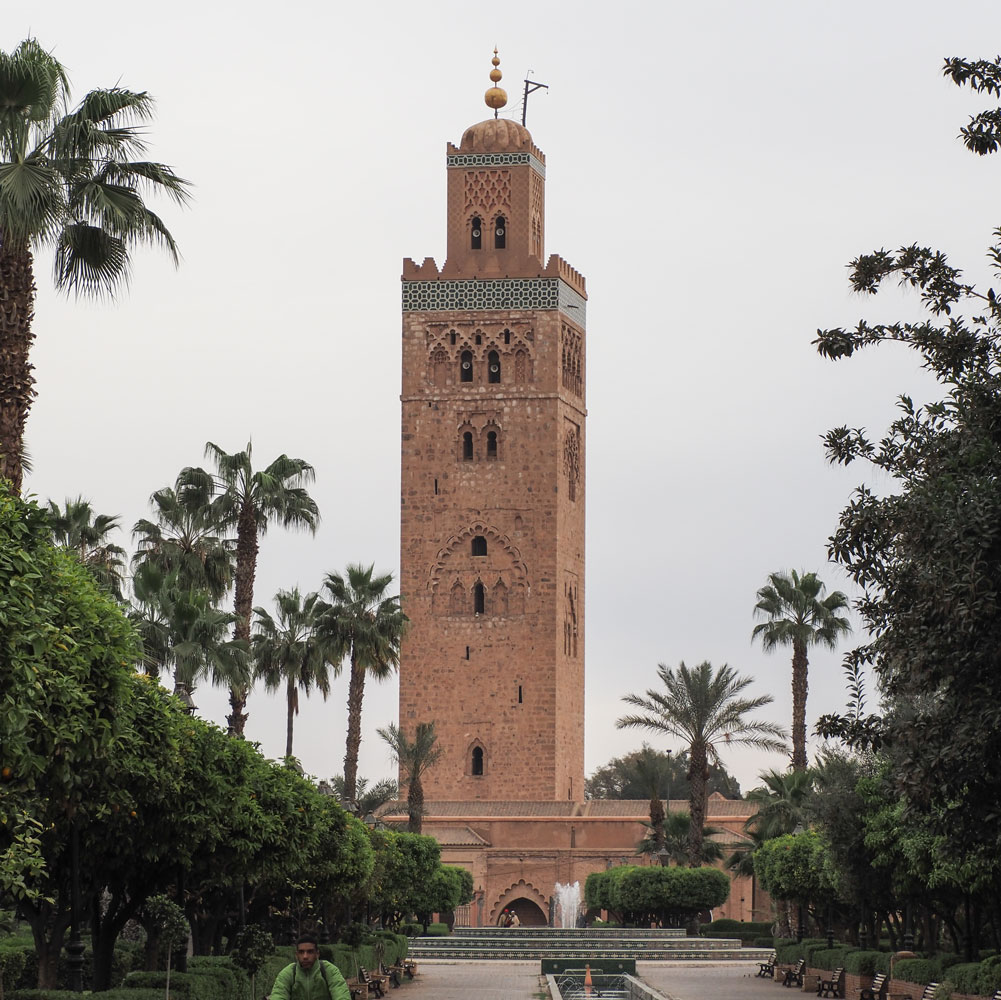
Here's a better picture of the mosque and minaret, taken from the web.
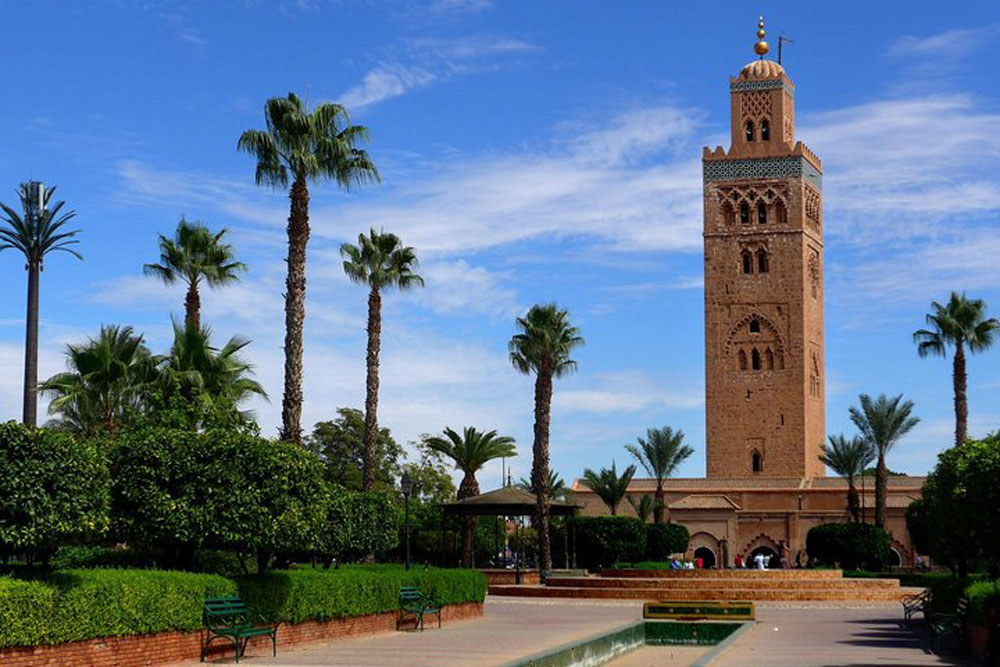
When we got to the fountain in front of the minaret we found a waterman. The waterman used to sell water to individuals. His water cups are around his neck, and he has a bell to ring to alert potential customers that he's coming. Water was carried in the goatskin bag on his left, and in the bag by his right side he has coins that he received from customers. I expect his hat is just to alert people as to who he is.
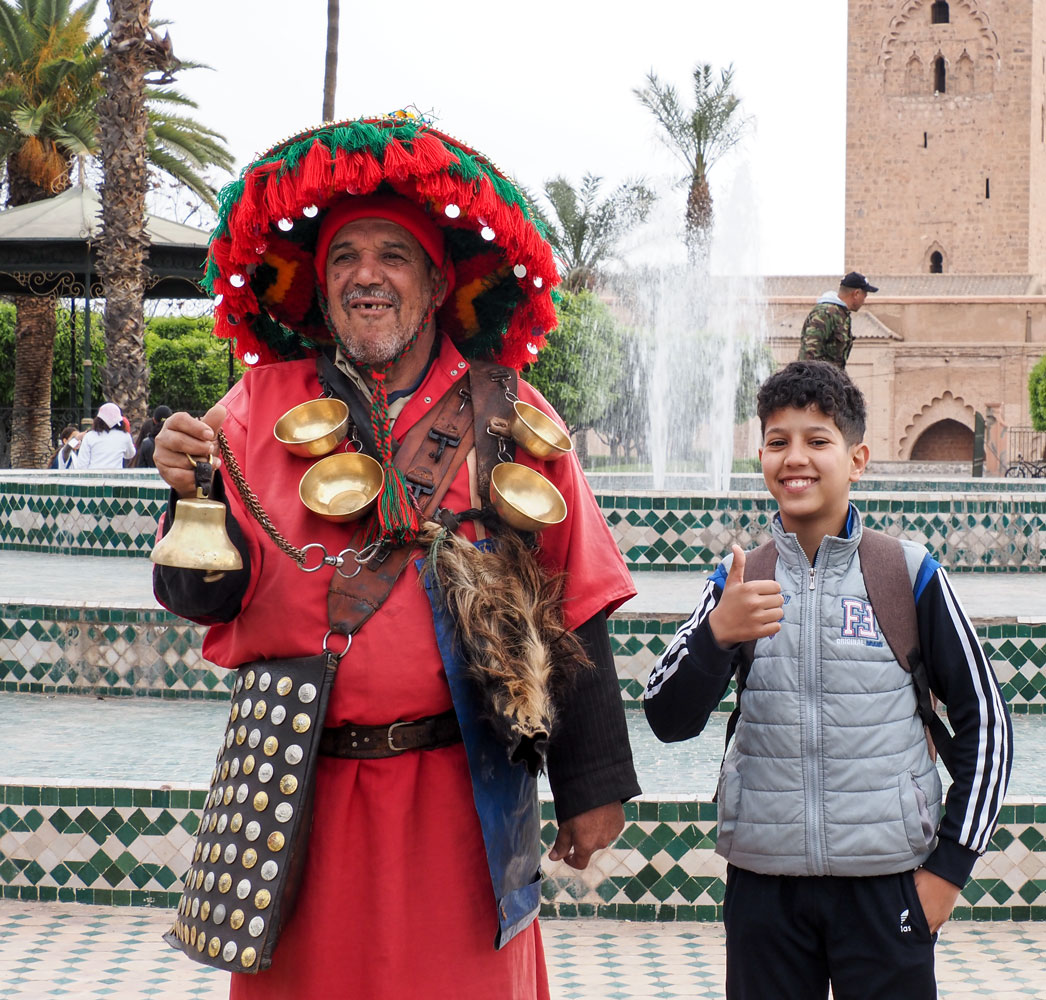
Judy had her picture taken with the waterman.
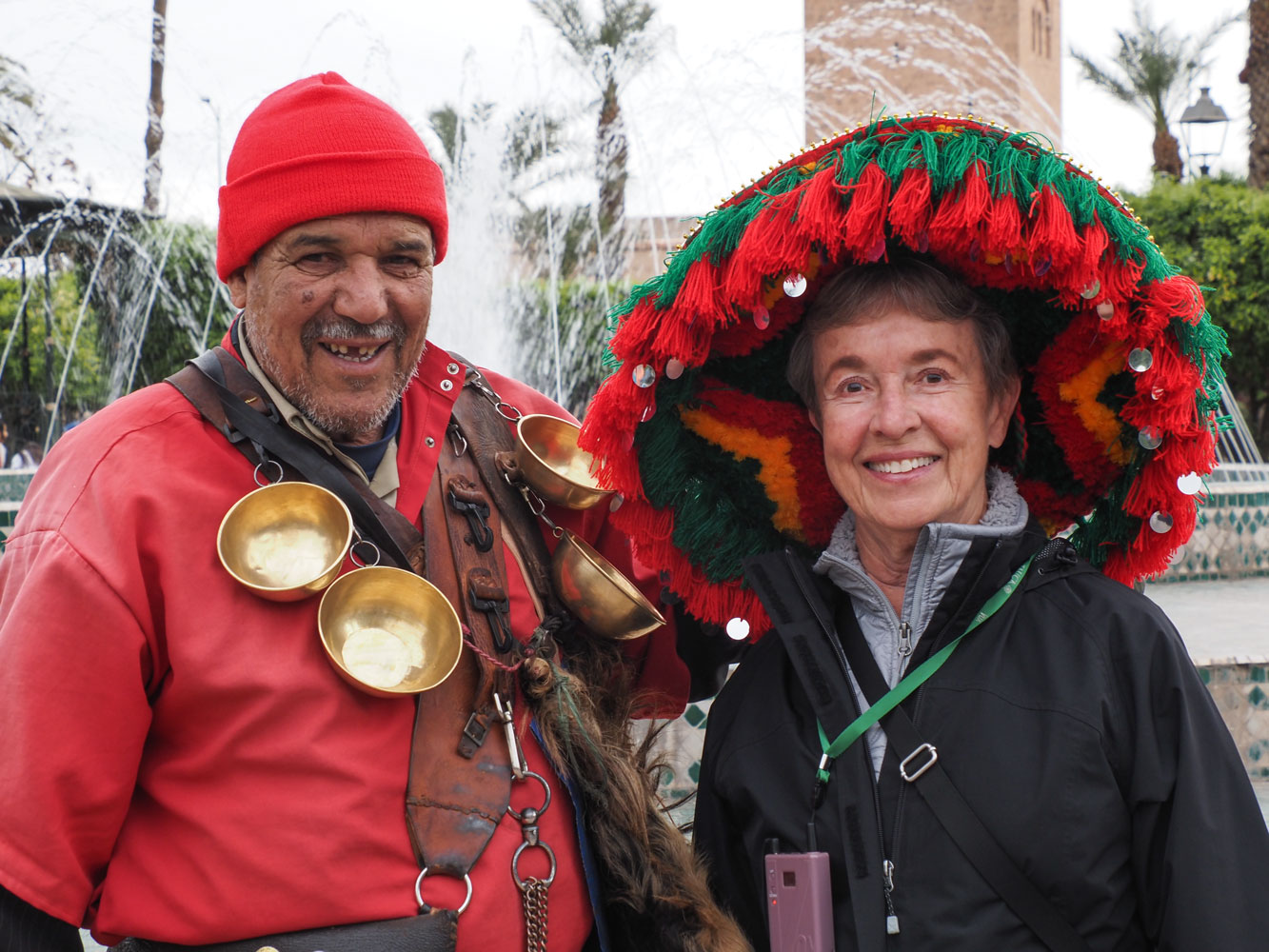
As did Janet.
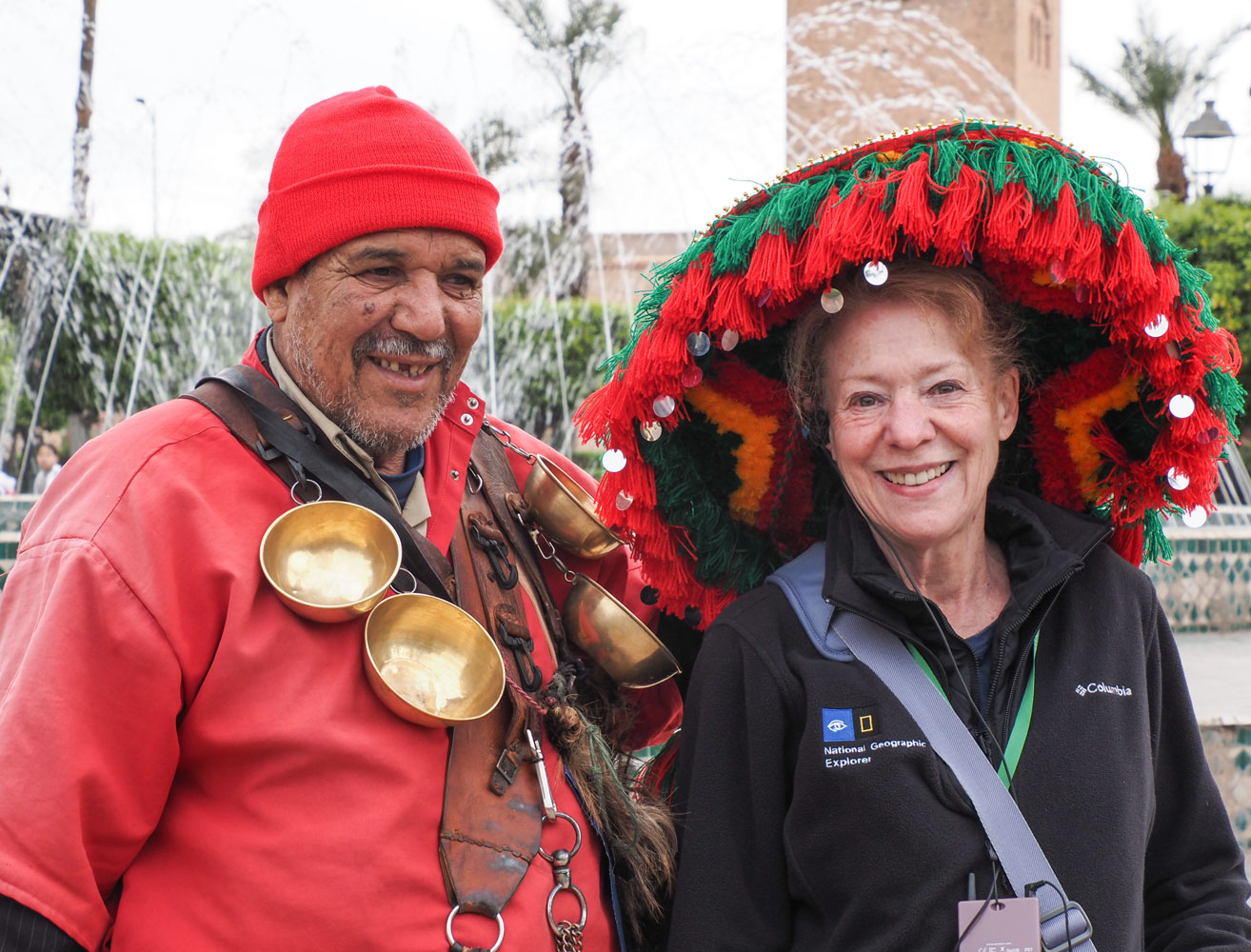
Here's a view of the destroyed part of the mosque. The story behind this destruction is a bit complex. The city of Marrakesh was founded in 1070 by the Almoravid dynasty to be their capital, and they constructed a mosque here. However, they were defeated and the city was captured in 1147 by the Almohads who also used the city as their capital. The Almohads systematically removed all traces of the Almoravids, including the mosque. But what they did was to build their mosque next to where the Almoravid mosque was.
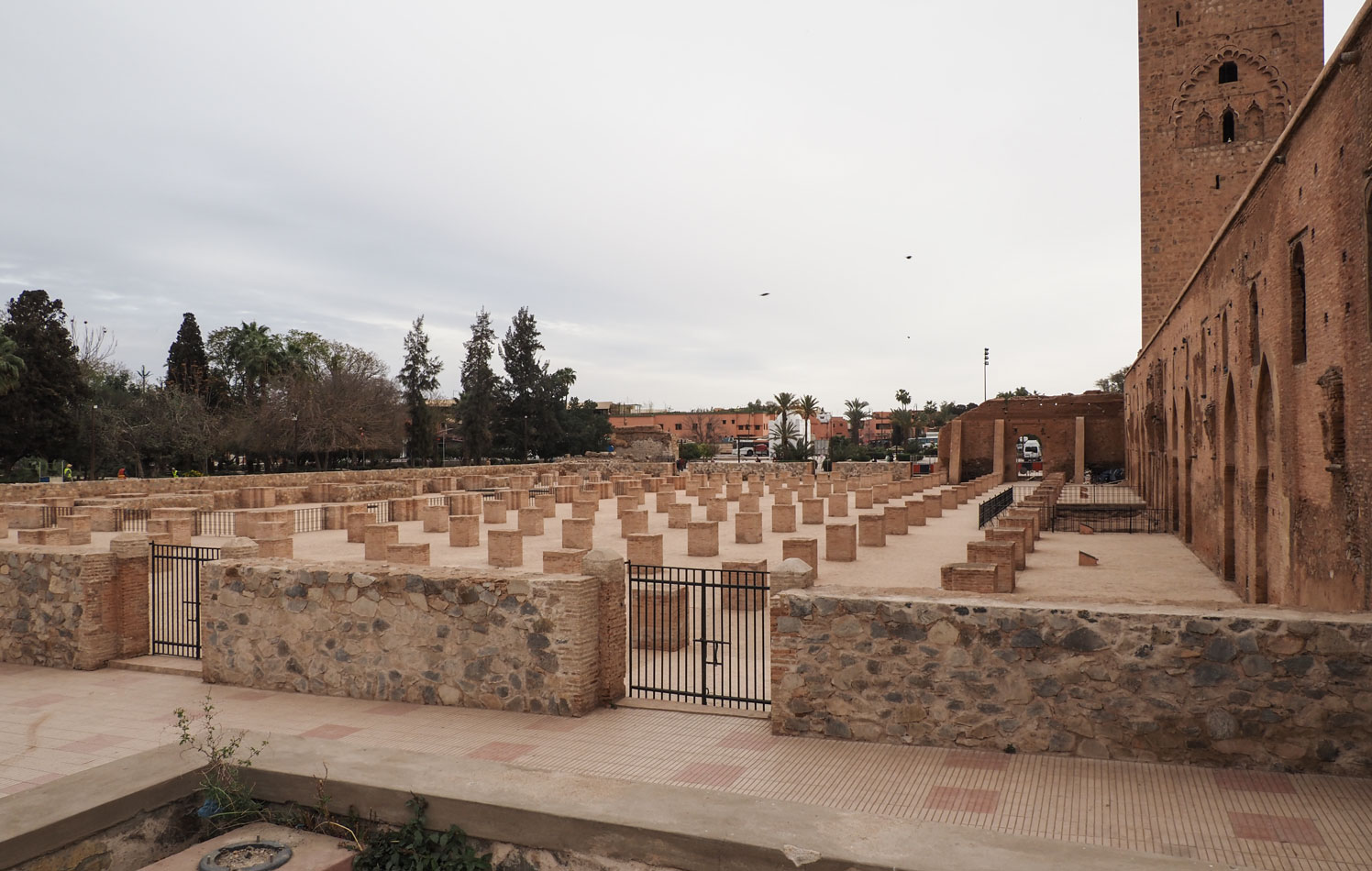
We took a group picture at the mosque. From the left: Chris, Nourdine, Judy, me, Marta, Wally, Janet, Peg, Dennis, Betty, Dan, Joan, Desiree, Anita, Richard and Gail.
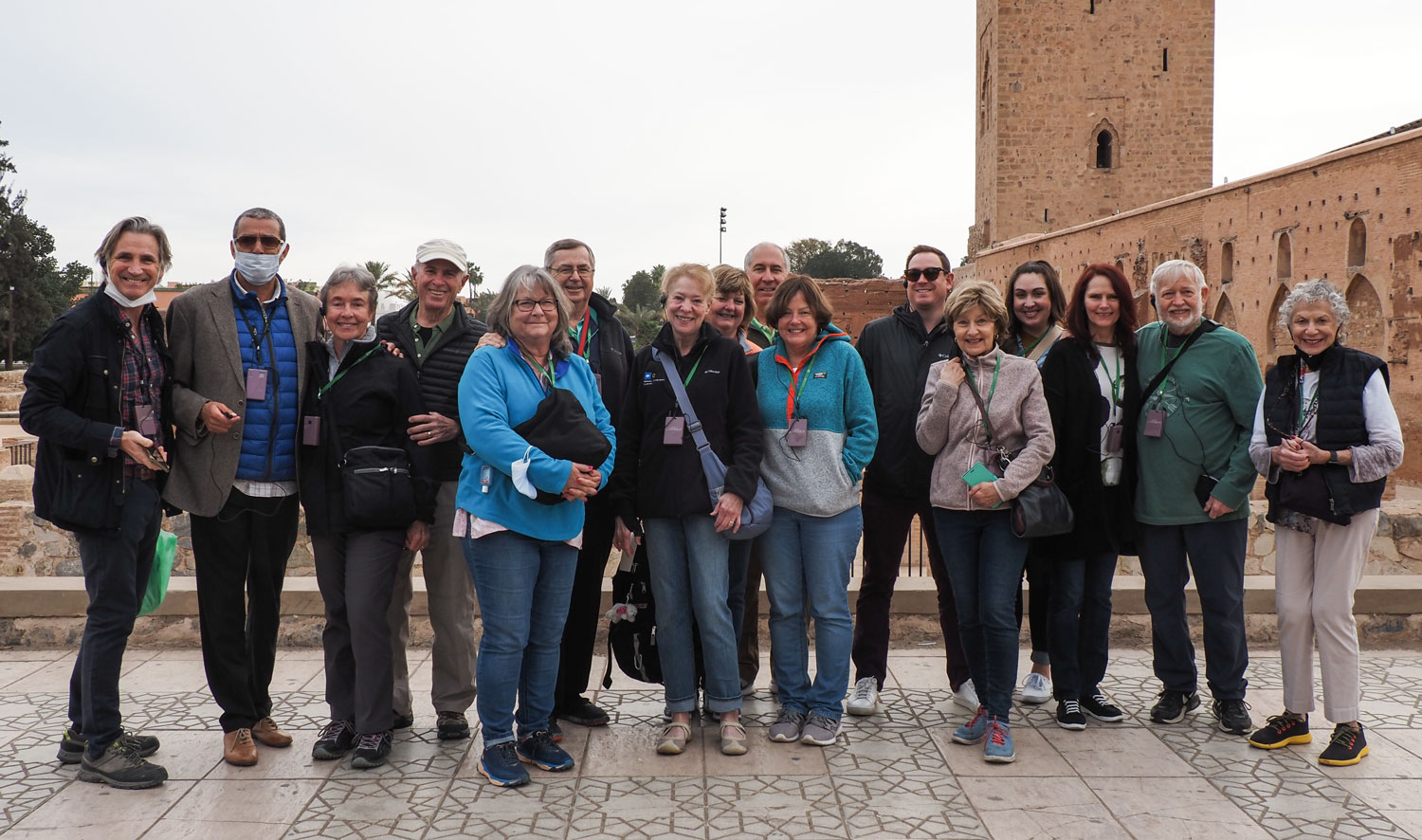
From here, we went to the Jewish quarter of the city, known as the Mellah of Marrakesh. We walked through the quarter while Nourdine reviewed its history. One image that struck me was this vehicle parked between two trucks. I don't have any idea how he's going to get out of that parking space.
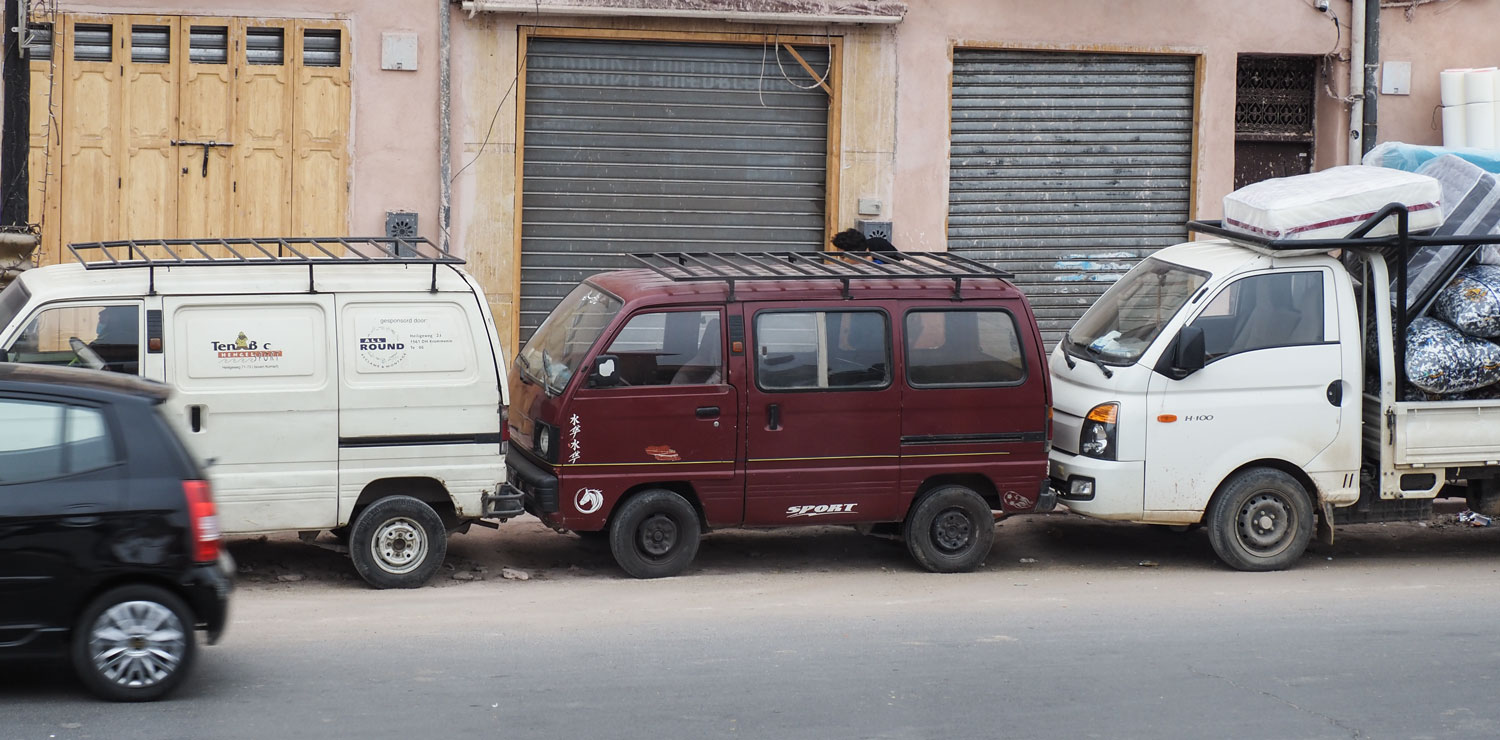
The Slat al-Azama Synagogue (also know as the Lazama Synagogue) is located in the mellah, but we did not visit it.
After we left the mellah we headed to the Bahia Palace. It was constructed in the late 19th Century, so it's fairly new. It was begun by sultan Muhammad ibn Abd al-Rahman in 1859 and then continued and expanded by his son Ahmad bin Musa between 1894-1900. Ba Ahmad, as he was known, effectively ruled between 1894 and his death in 1900, but was not an effective ruler of Morocco
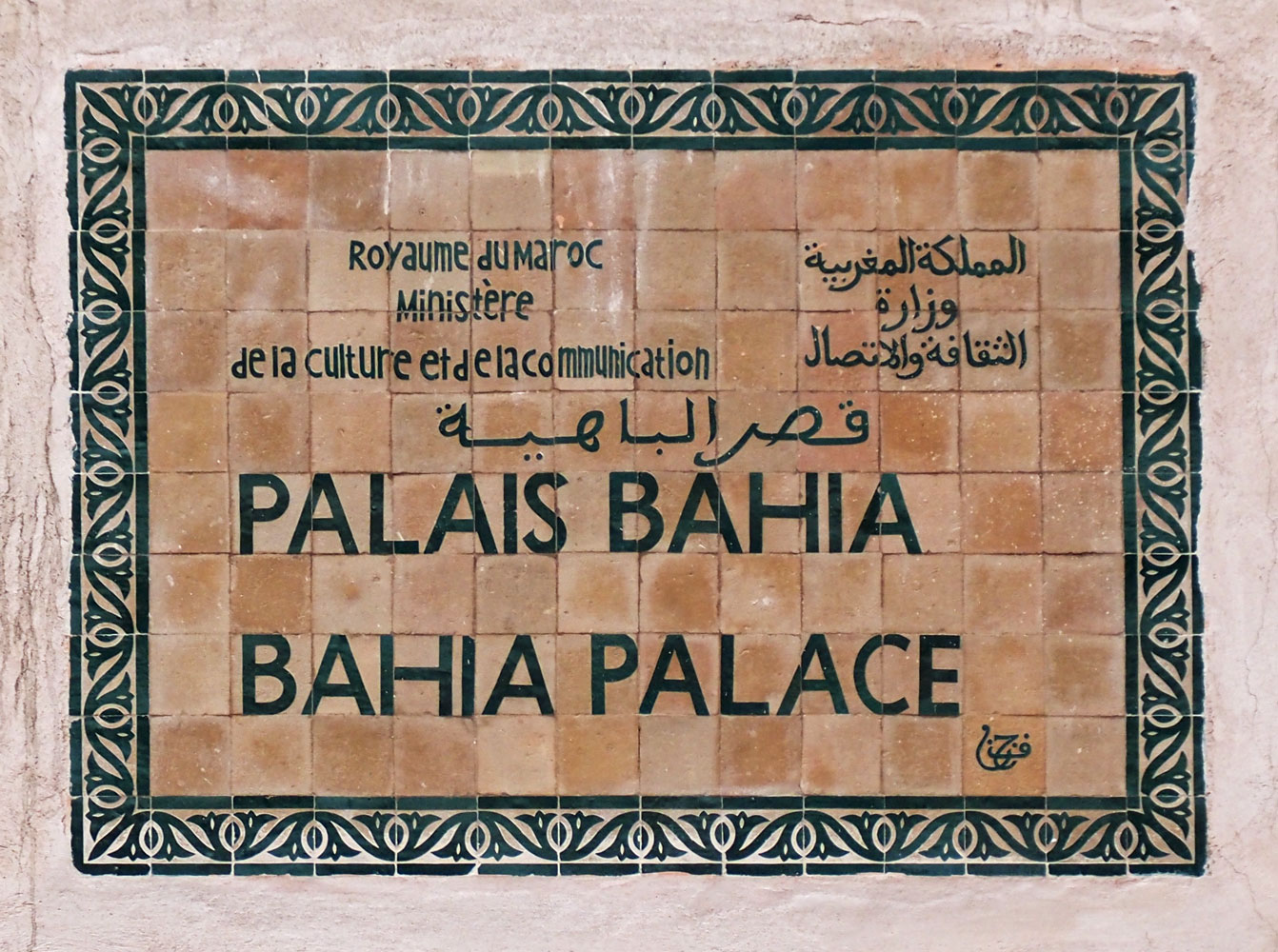
Here's the entry.
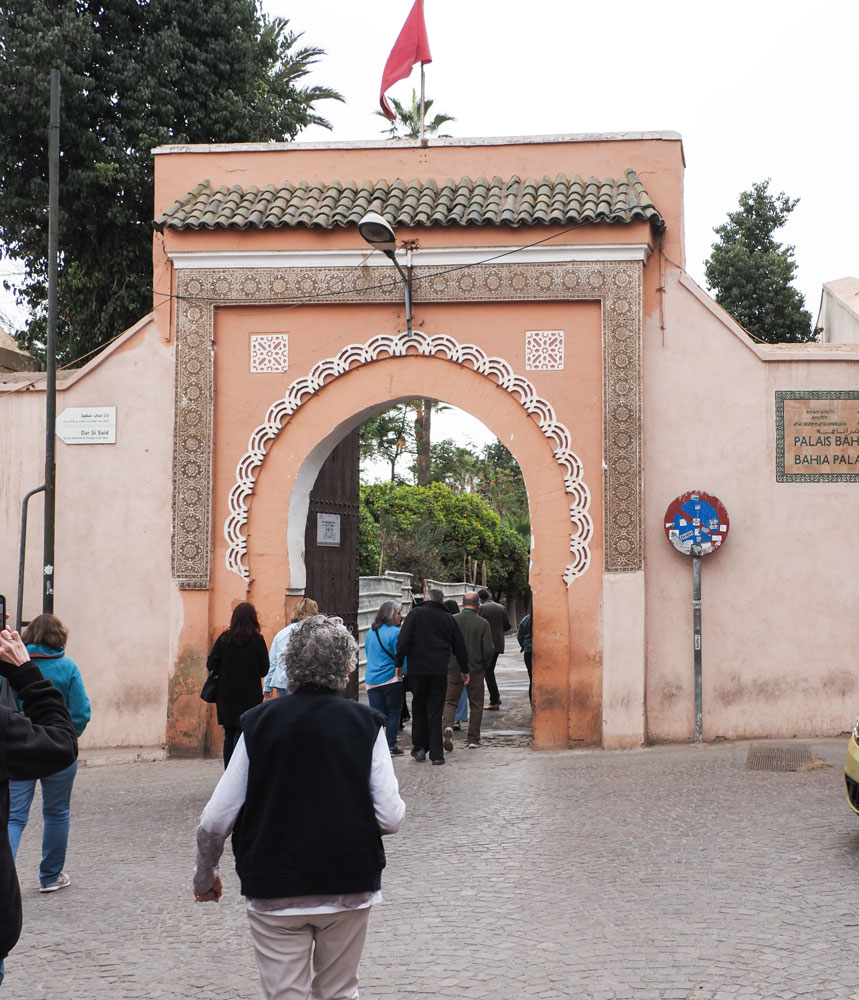
The palace has a number of courtyard gardens, called Riads. Nourdine explained that a traditional riad is always divided in quarters and must have a fountain. Note that there are four "gardens" here. The presence of a fountain is a basic tenet of Islam.

The walls are highly decorated in Islamic style.
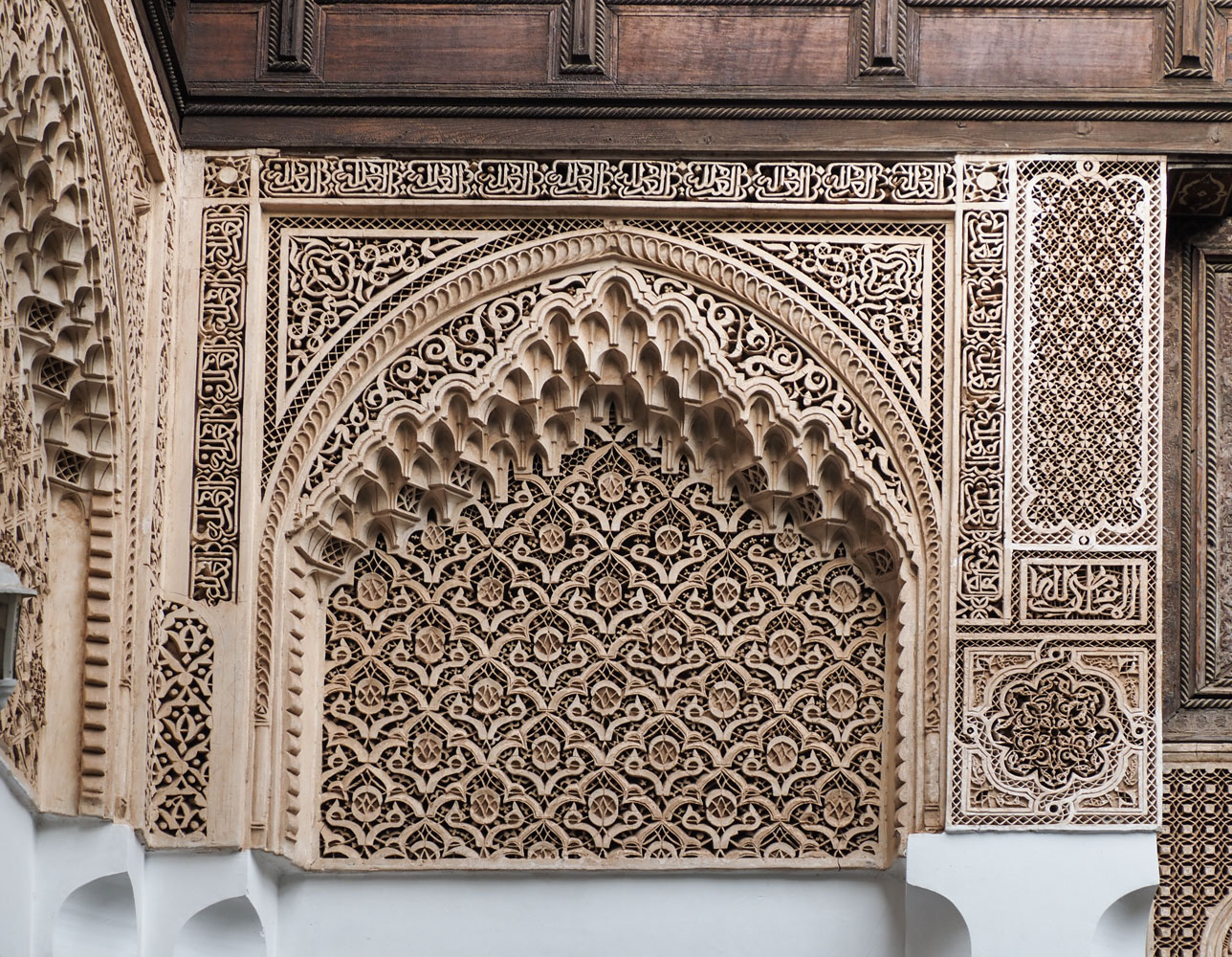
A view of the central courtyard, where the women gathered.
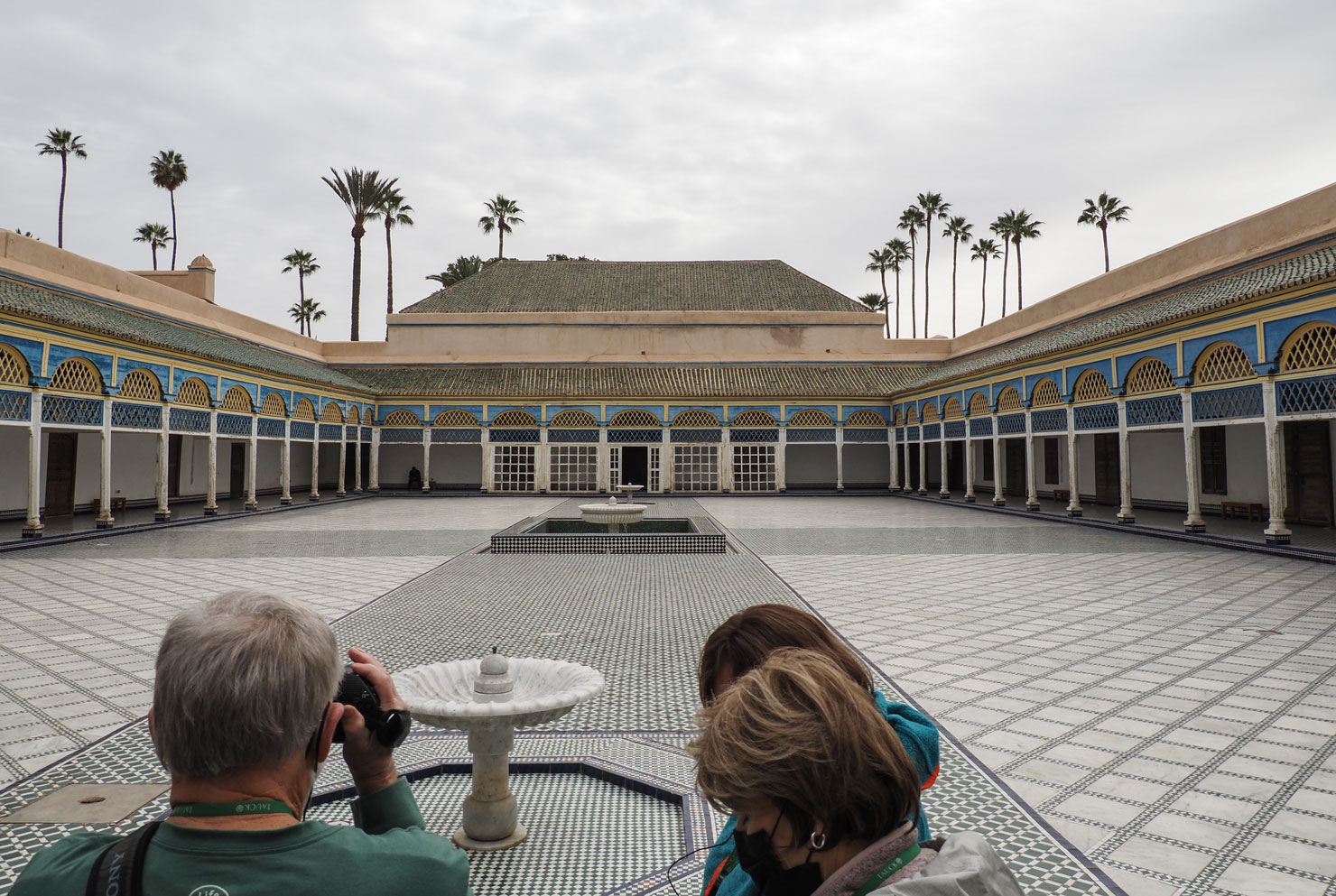
A highly decorated ceiling.
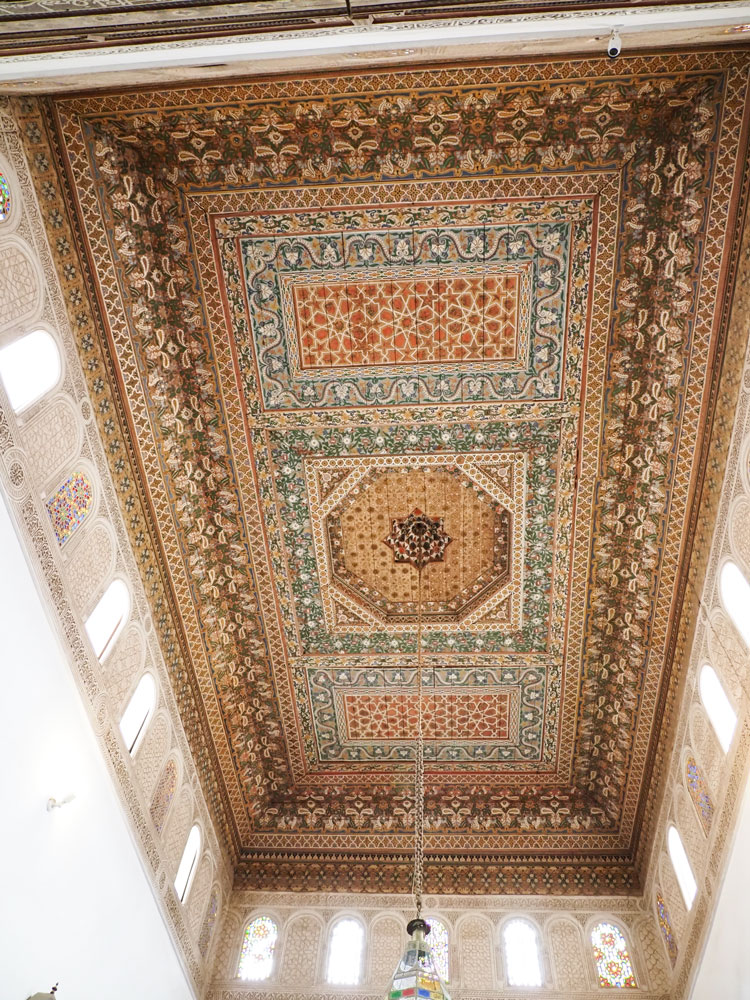
I took advantage of one of the mirrors to take a self portrait.
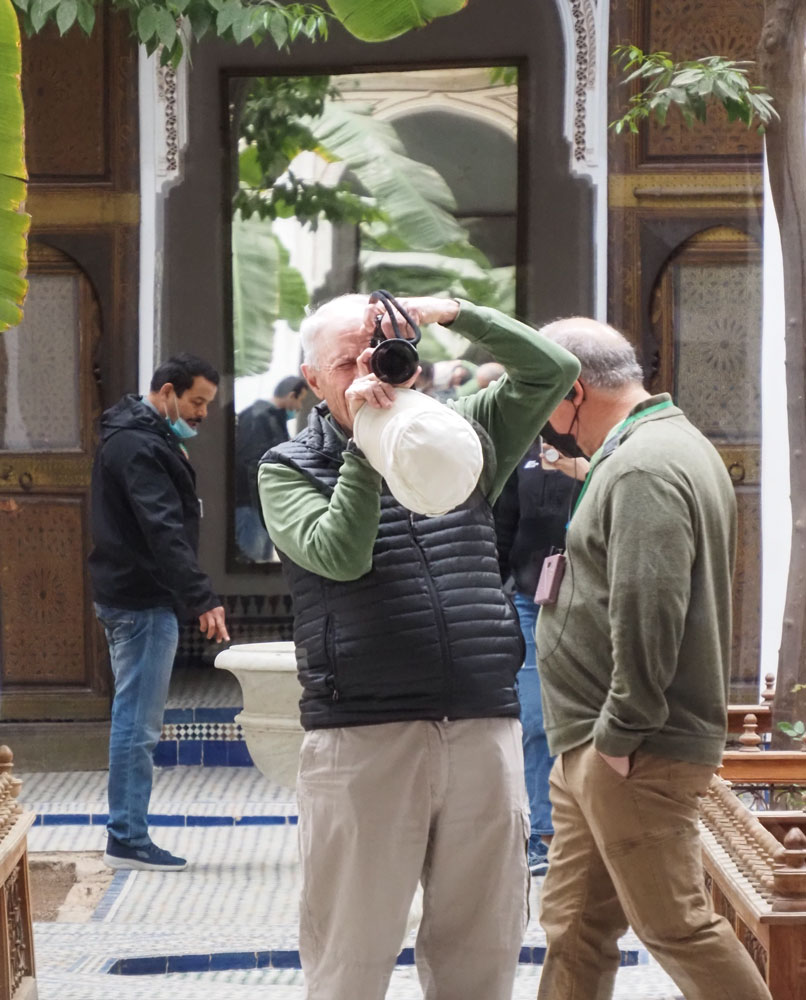
After leaving the Bahia Palace, we walked through the medina on our way to the shop of a herbalist.

He had a "presentation" room with seats for all of us. These herbalists are all highly trained in the field of preparation and use of these products, and the shop is known for the quality of its goods.
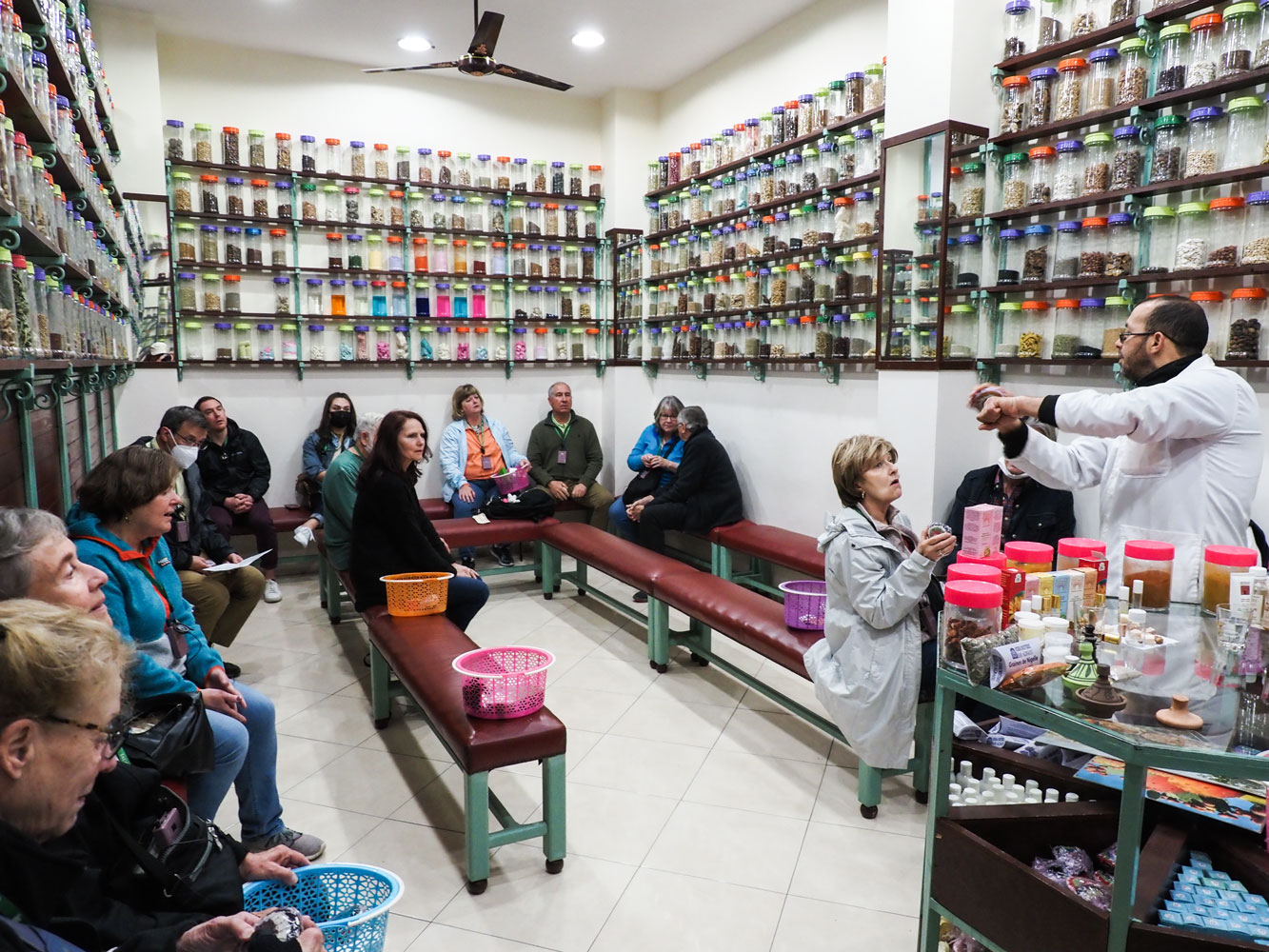
Here are Janet and Judy waiting to hear the pitch.
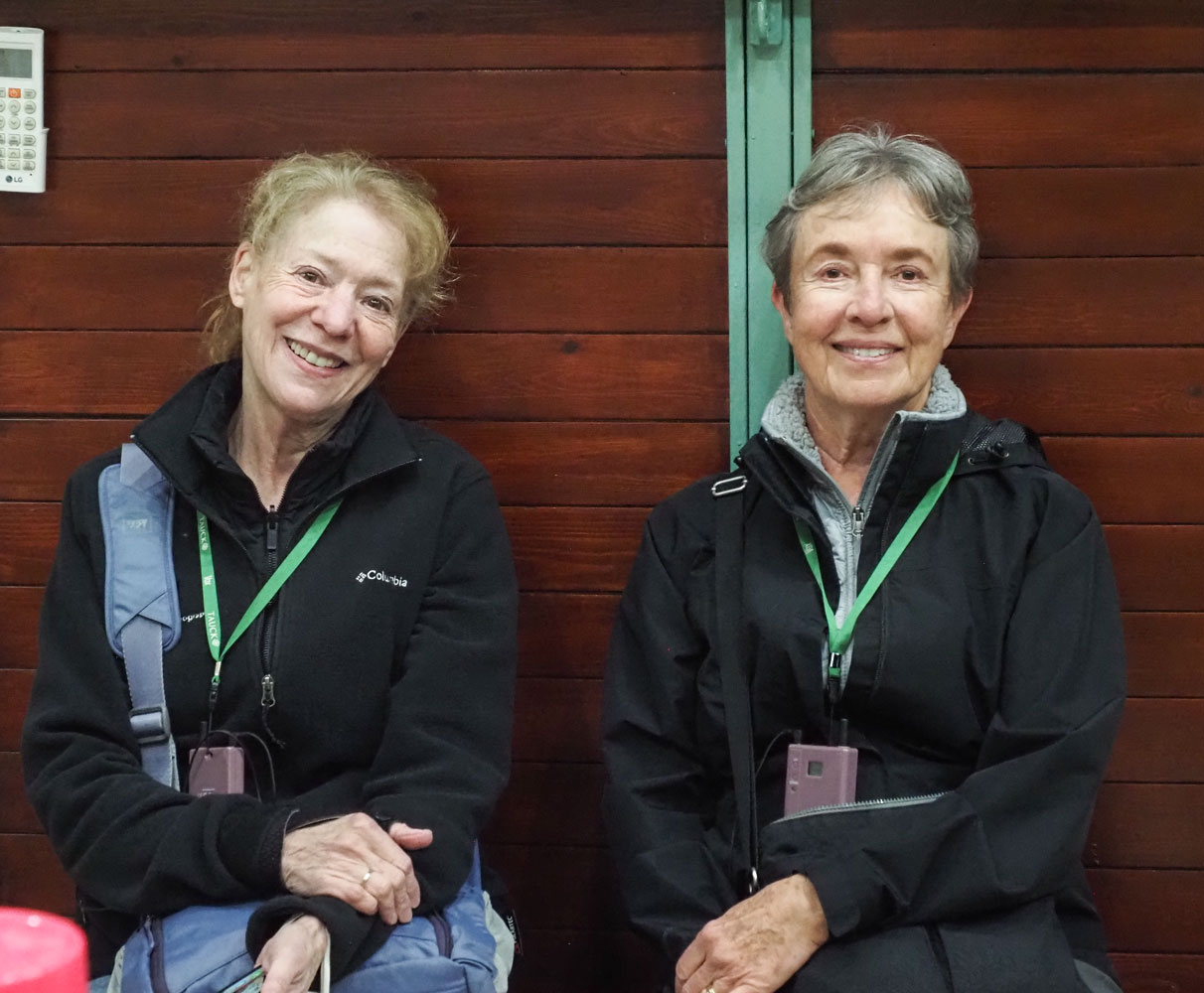
He was a good salesman. He explained his products and claimed various results from using them.

Janet and Judy each bought a few things, as did the rest of our group.
After we left the herbalist we went to lunch at a rooftop restaurant, "My Kechmara". We had selected our lunch orders earlier on a form that Chris passed out, so the service was quick. One choice was a hamburger and we were impressed with the size of it when it was served. But the people who ordered it reported that it was not fully cooked and had to be sent back. I had a chicken kebob dish and it was fine.
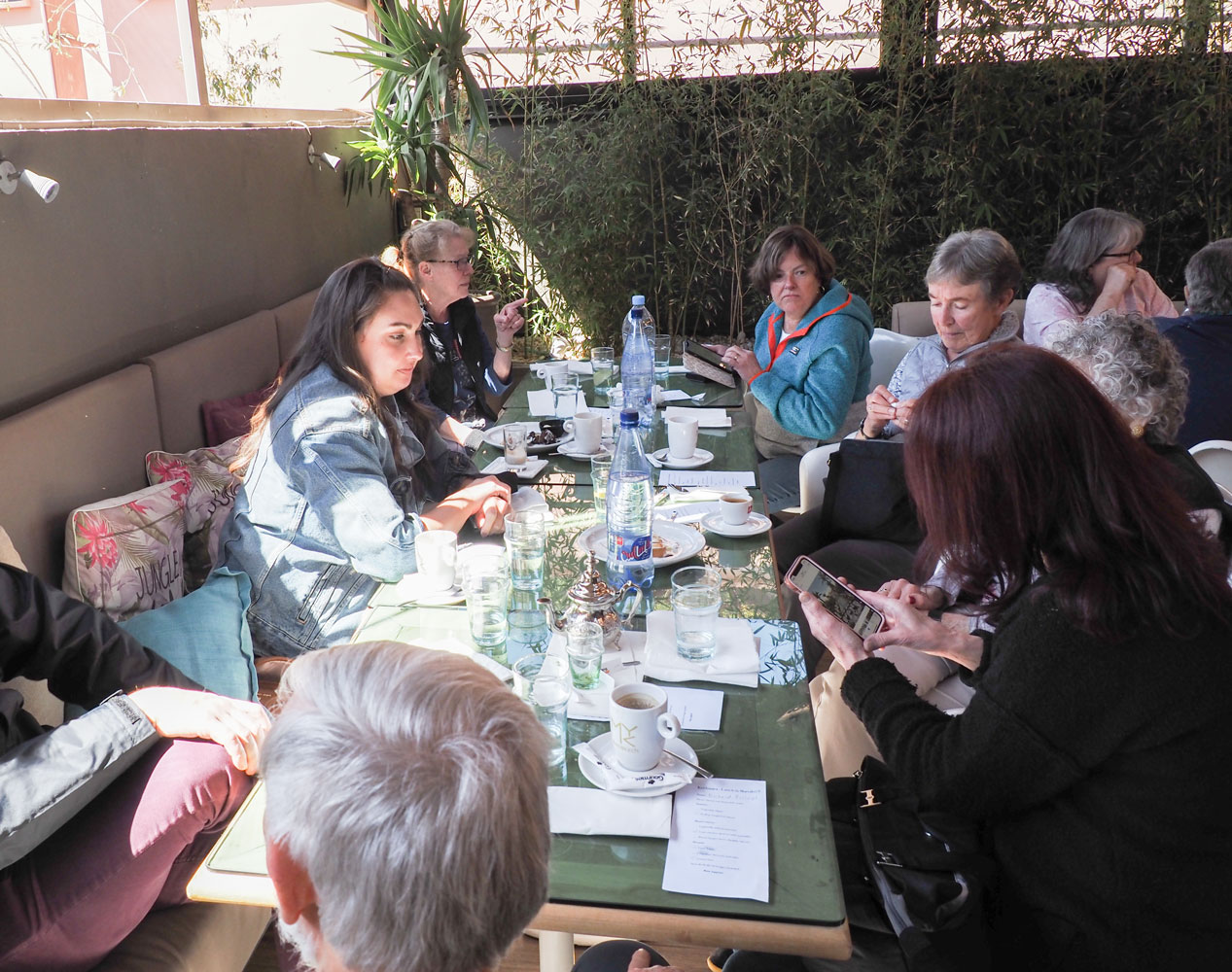
Here are the two guys who waited on us. We could see how people in many of our venues treasured having us there, as the country had only recently opened again to tourists after a Covid-19 shutdown. And beyond that, Moroccans have a strong tradition of hospitality.
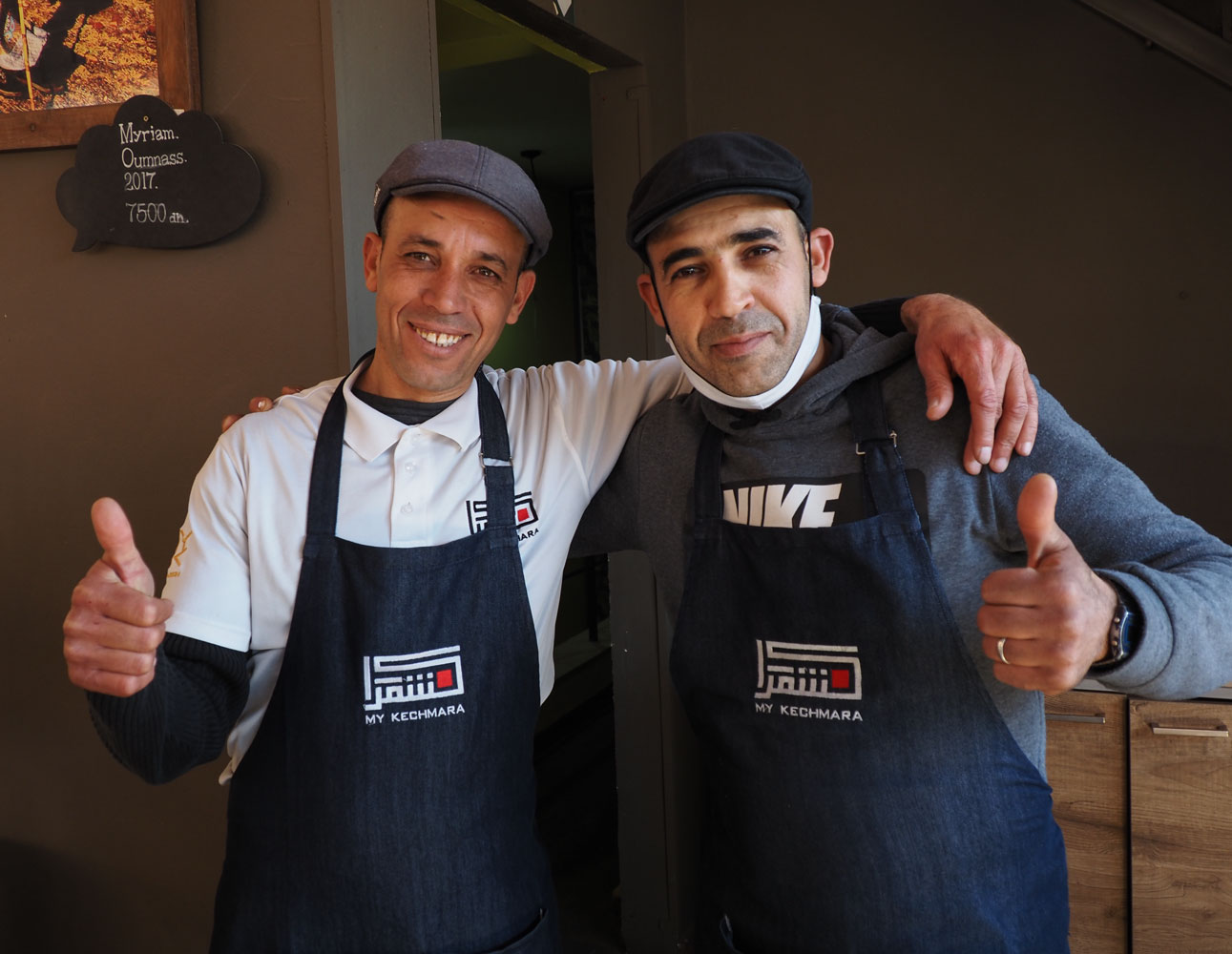
After lunch we walked through the medina and came to a caftan shop that had been pre-arranged as a shopping stop. Here's the shop owner showing one of the items. Most of the clothing was for women.

And a picture of the group shopping. I didn't see anyone purchase anything. The style of clothing is so different that it probably would not work in the United States.
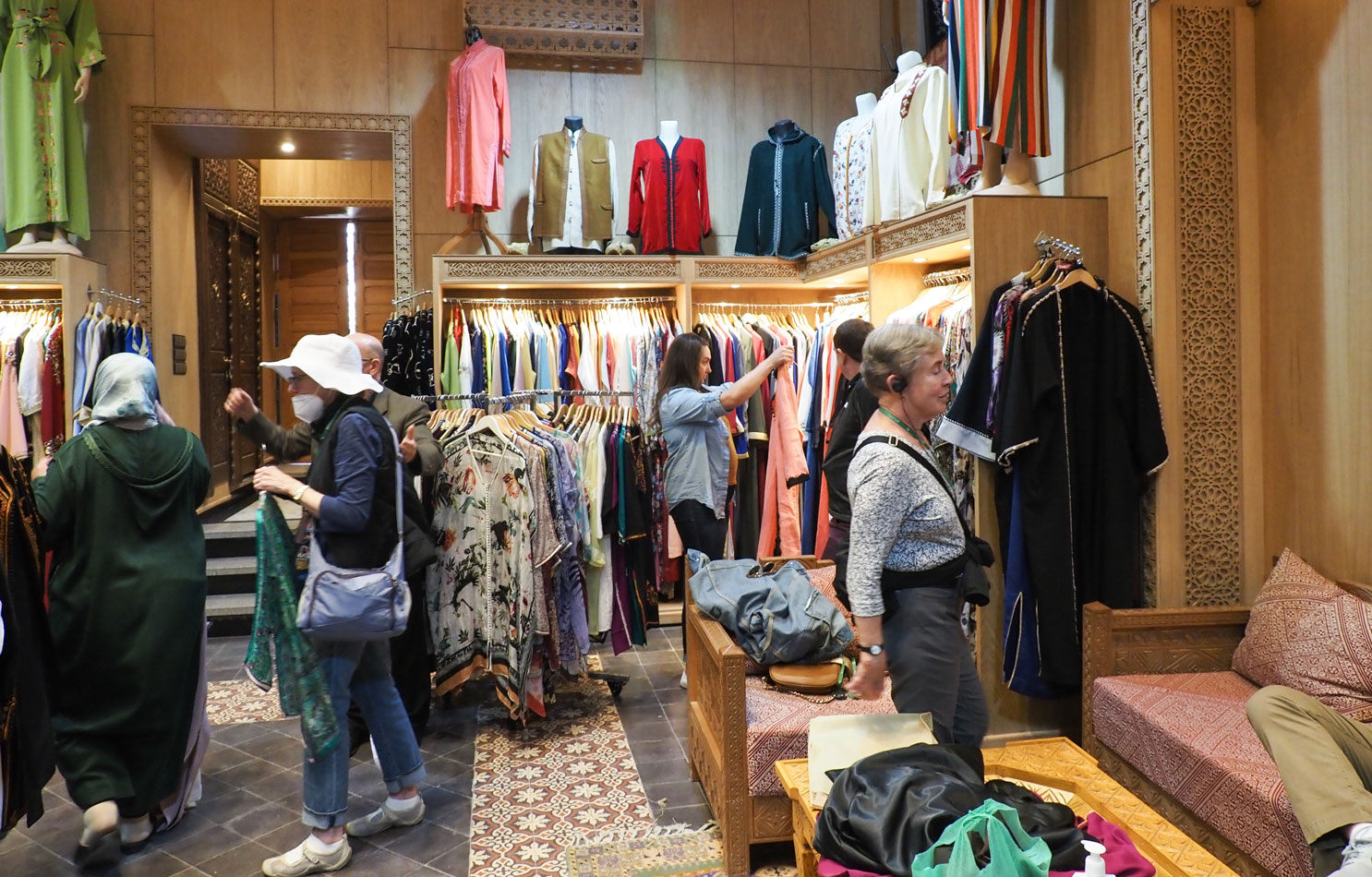
I was a bit disappointed in the shopping situation. There were things I wanted to shop for but the group was moving on through the medina. I had to dash into a store, grab an item, get a price (not easy because they want to negotiate) and pay. I did manage to buy what I wanted but it was not a pleasant experience. It would have been nice if there was shopping available other than at these pre-arranged places. Certainly, for the men in the group, a shopping stop at a women's clothing store is pretty boring.
After leaving the store, we walked through the medina until we exited onto the Jemaa el-Fnaa, the main square of the Marrakesh medina. It's hard to convey what the square is like because there's so much to it, and it's so big. Another problem is that many of the people want to be paid if you take a picture of them. I had to be circumspect in taking pictures.
Here's an overview panoramic picture of the square, taken from the web.
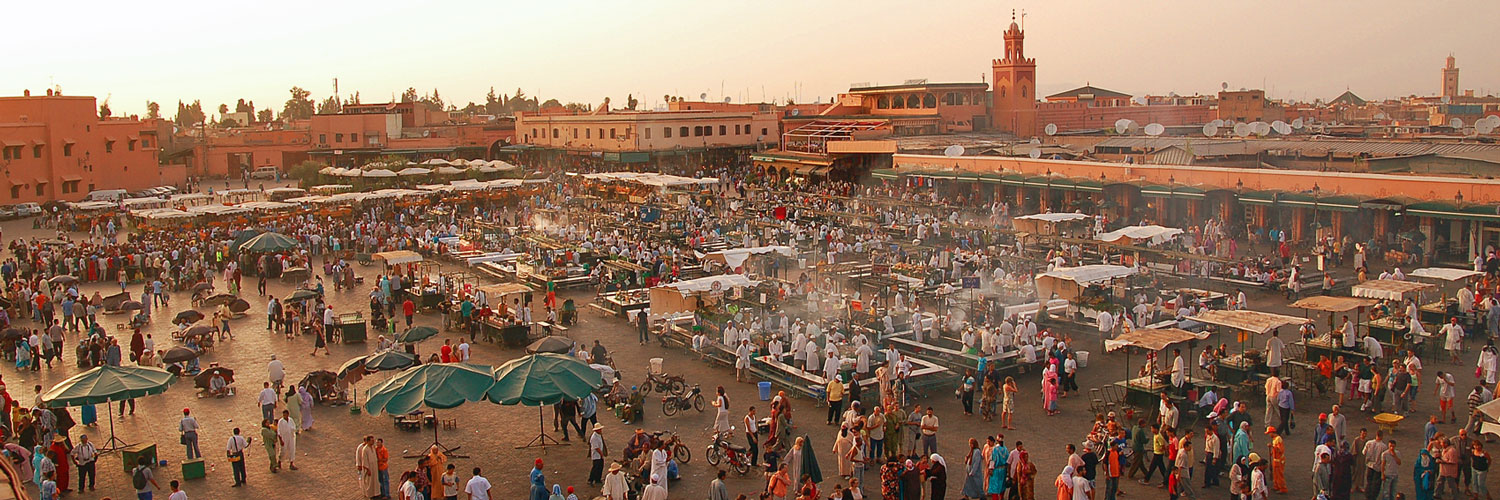
Some fruit stalls, mostly oranges.
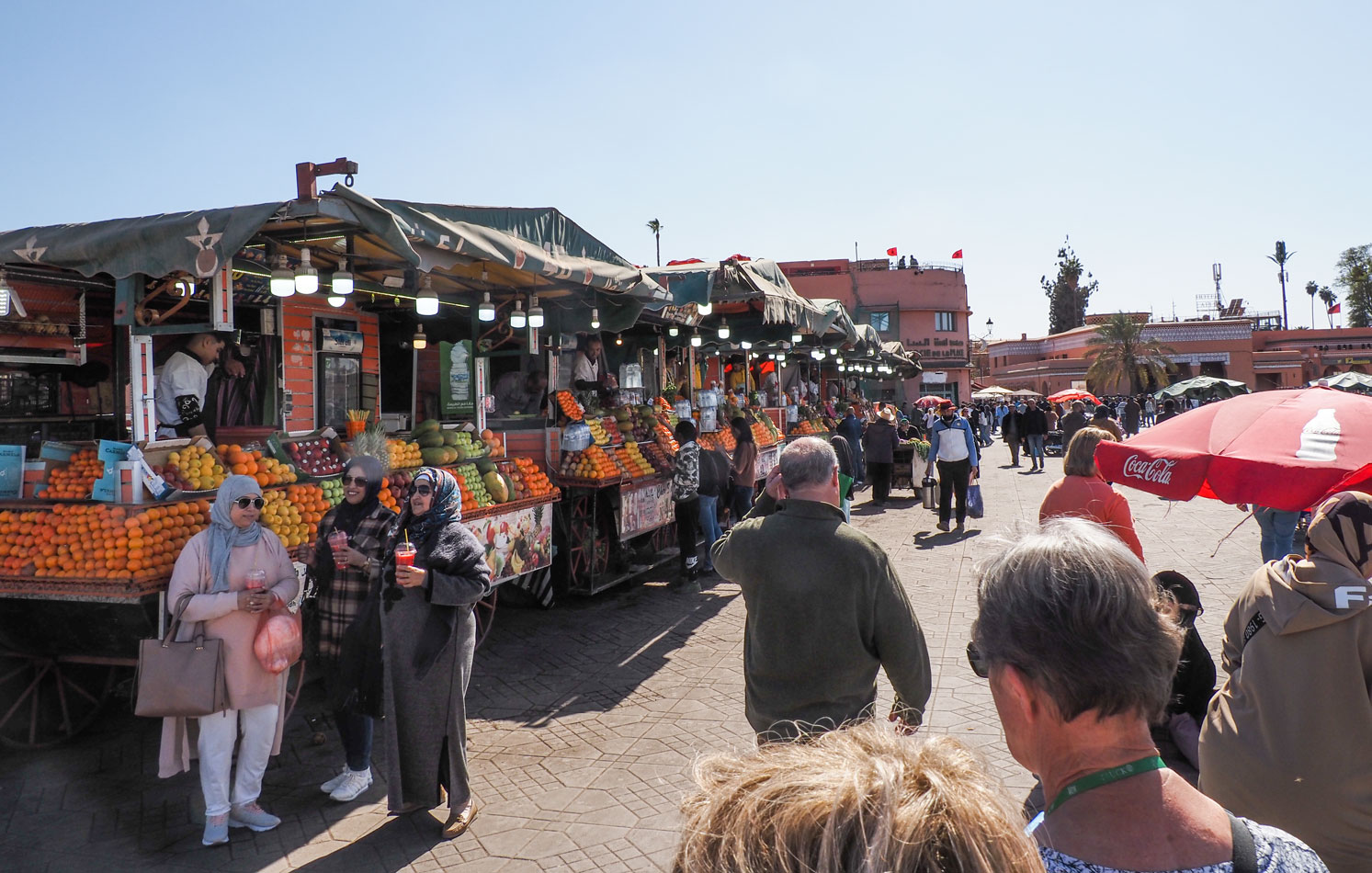
Here's a group of snake charmers.
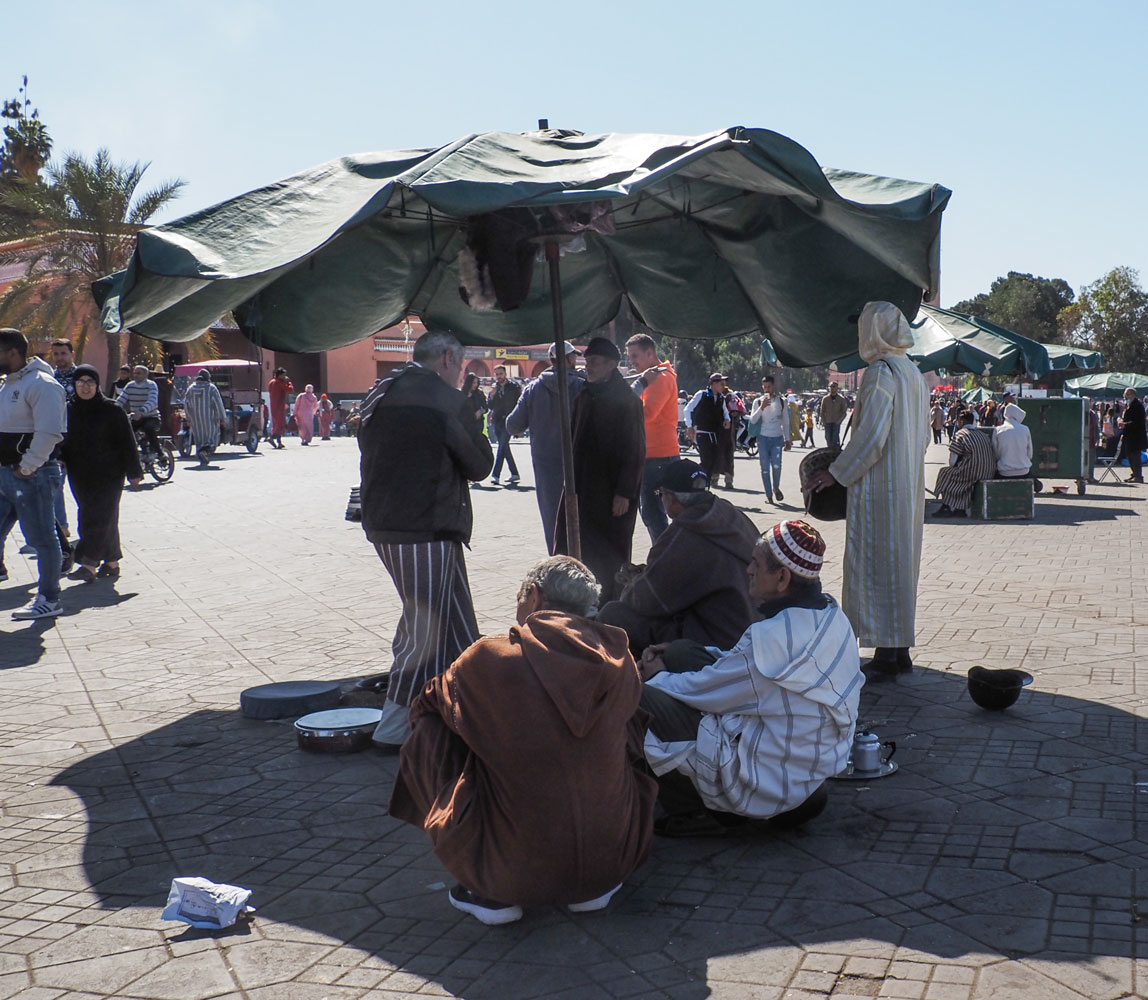
And the snakes. As soon as I took this picture, they were all over me to get payment for the picture. But that's what they do, and why they bring the snakes to the square - to get payment from tourists for pictures.
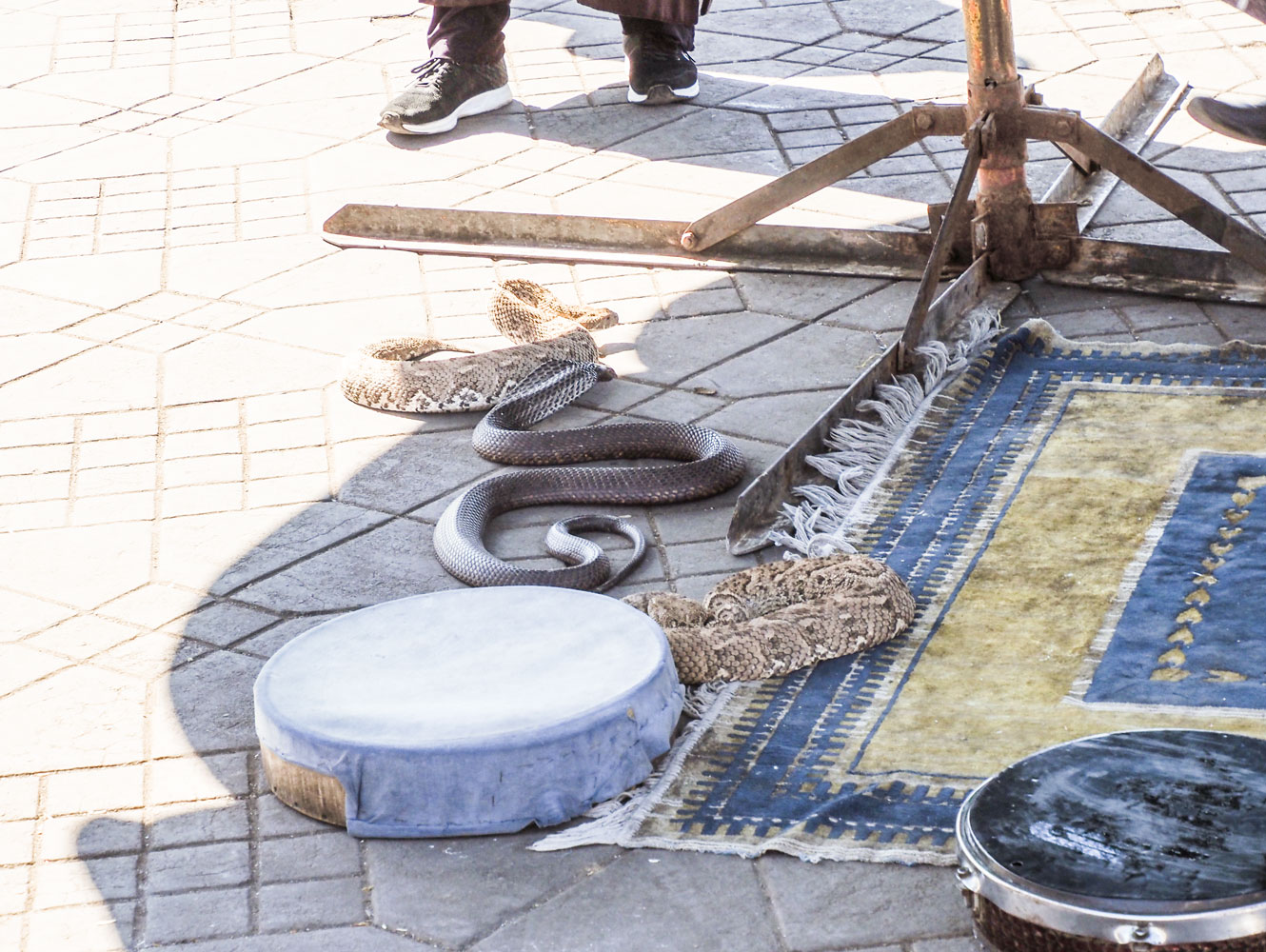
This guy made dentures "while you wait". Those are teeth on the left side of his table.
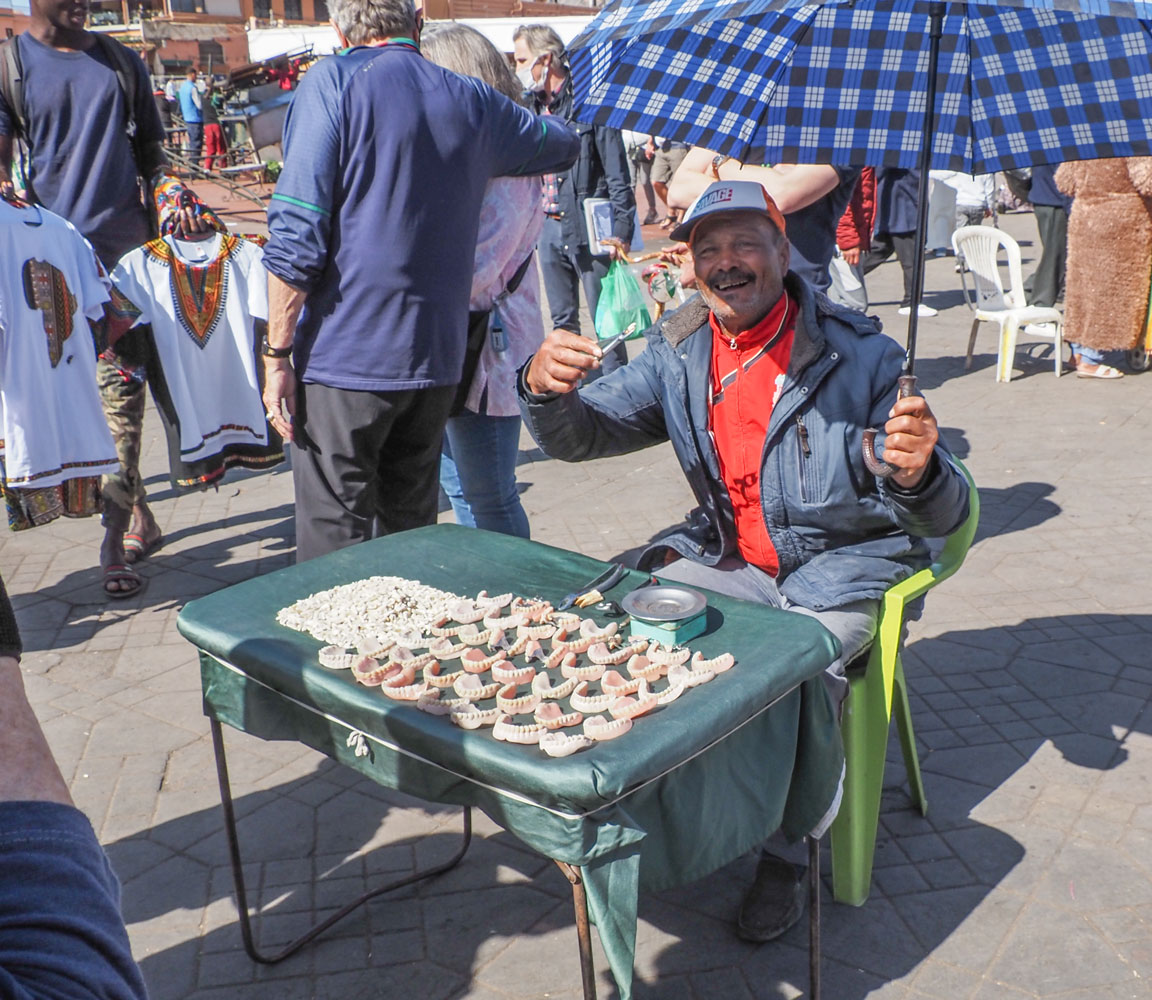
Another snake charmer.

There were a few watermen in costume but they wanted money if you took their picture. All-in-all, an interesting place to visit. Its like being in another world.
After we exited the square, we returned to the hotel and had the rest of the day to ourselves.
++++++++++++++++++++++++++++++++++++++++++++++++++
3/6/2022 (Sunday) The weather was wet this morning, with intermittent rain. Early in the morning, I took this picture of the area behind the hotel. The building in the picture is used for meetings and banquets. This is the building where our farewell dinner will be held, beginning with a reception on the top floor, which has a beautiful view of the city. You can see that things are wet from the rain.
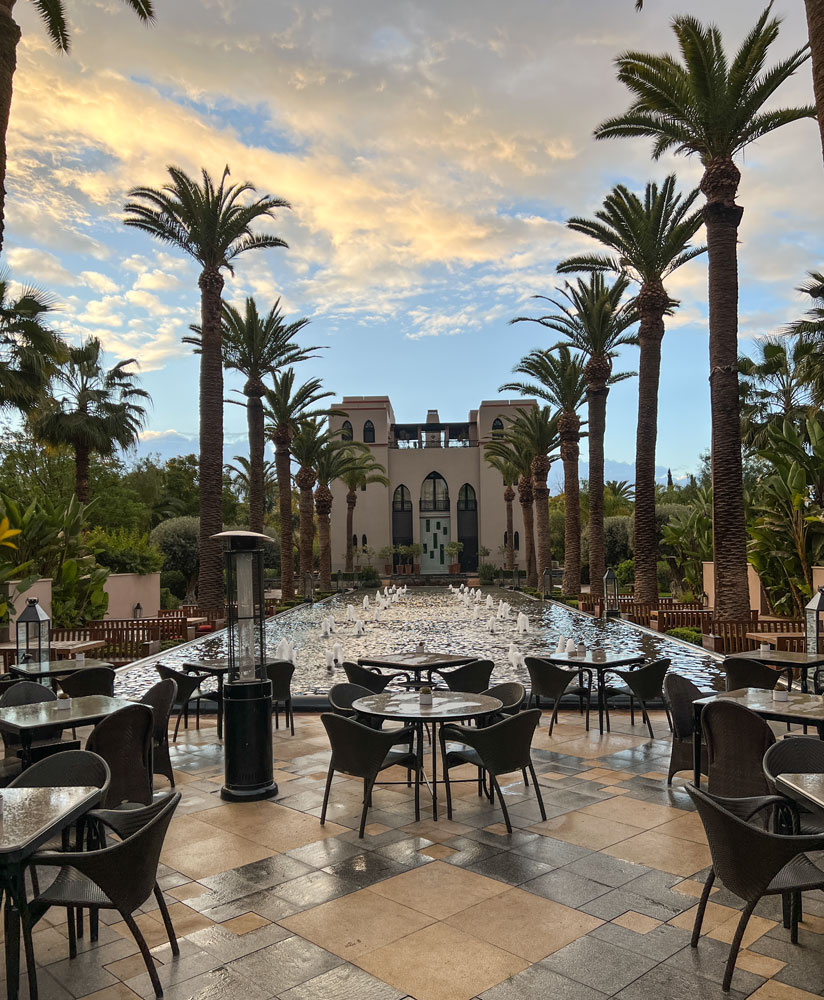
Tauck had arranged for horse-drawn carriages for us this morning, instead of the bus. As we walked out to the carriages, there was a lull in the rain.
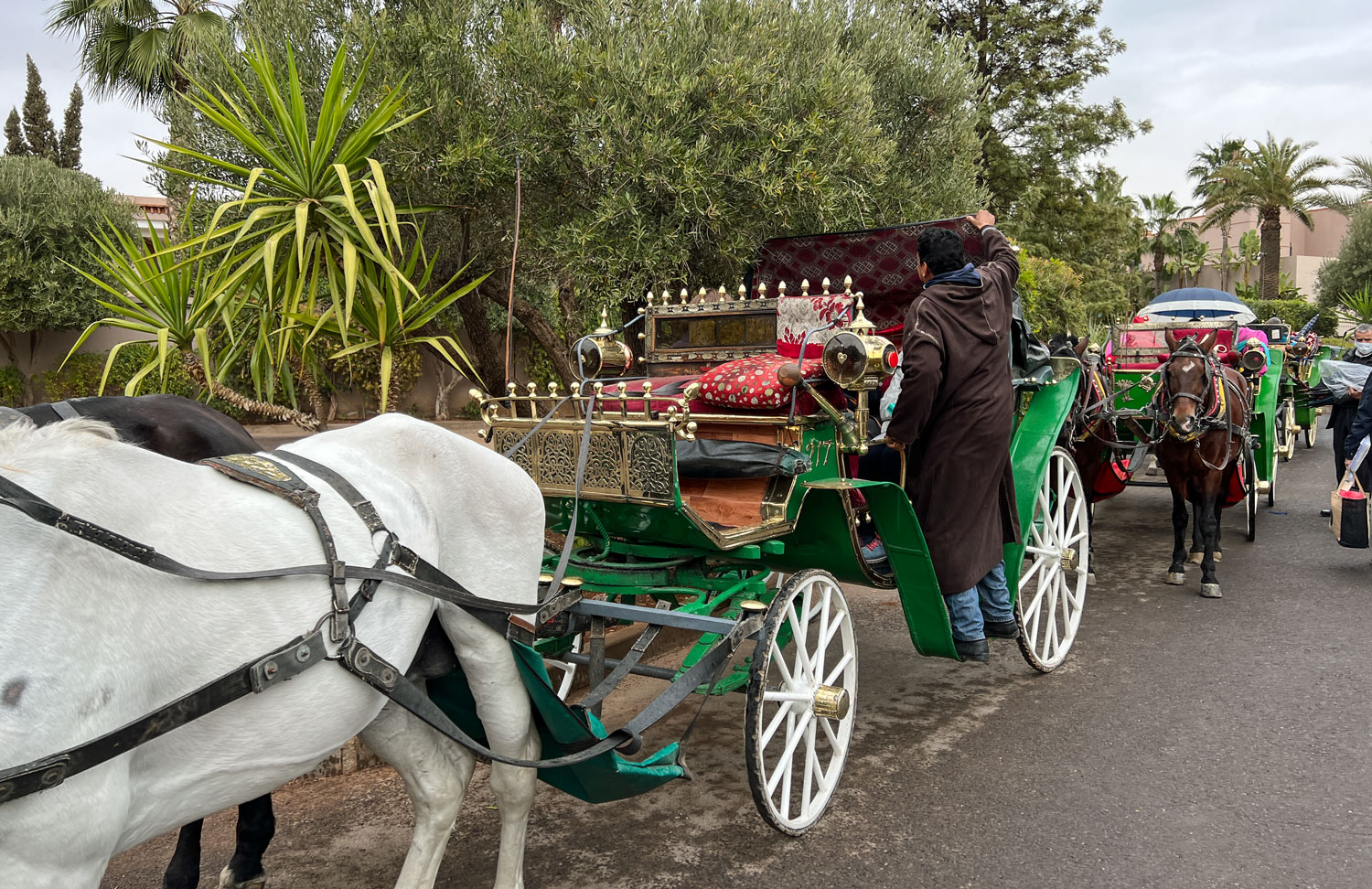
Here's Judy in one of the carriages.
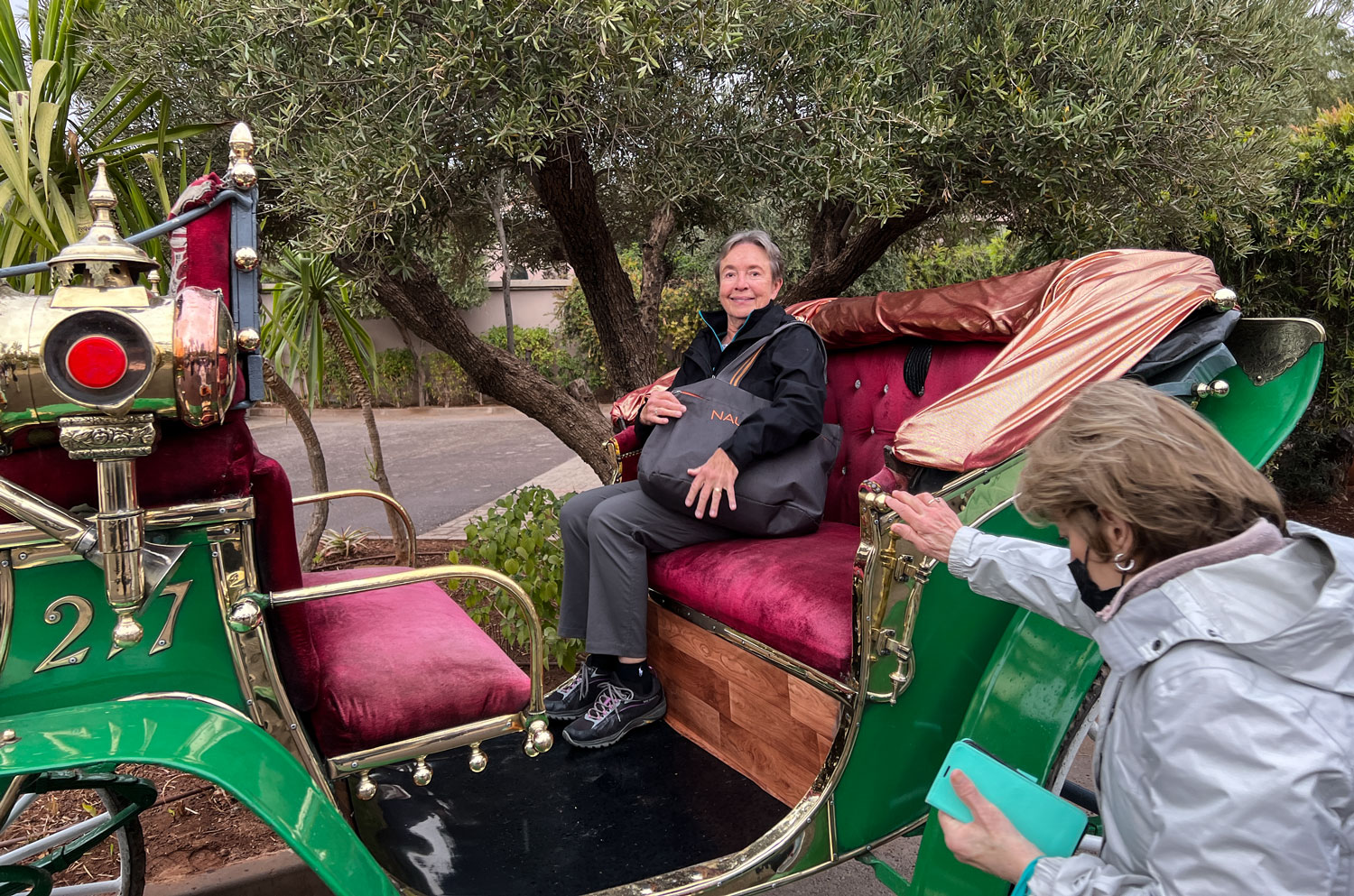
But then the rain showers started again and the drivers pulled the covers over the carriages, making it a very cozy and comfortable ride.
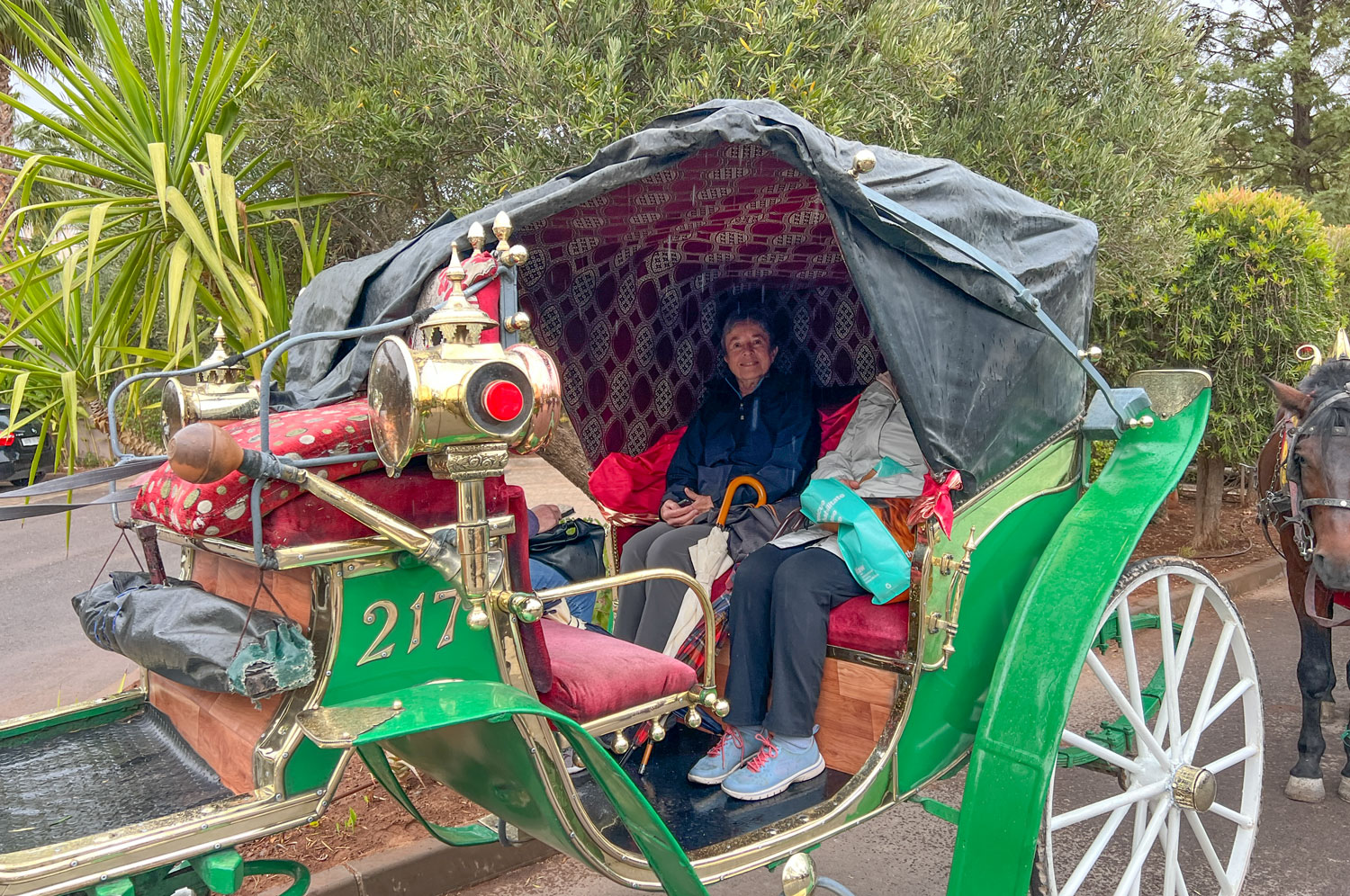
The drivers all had their rain gear on.
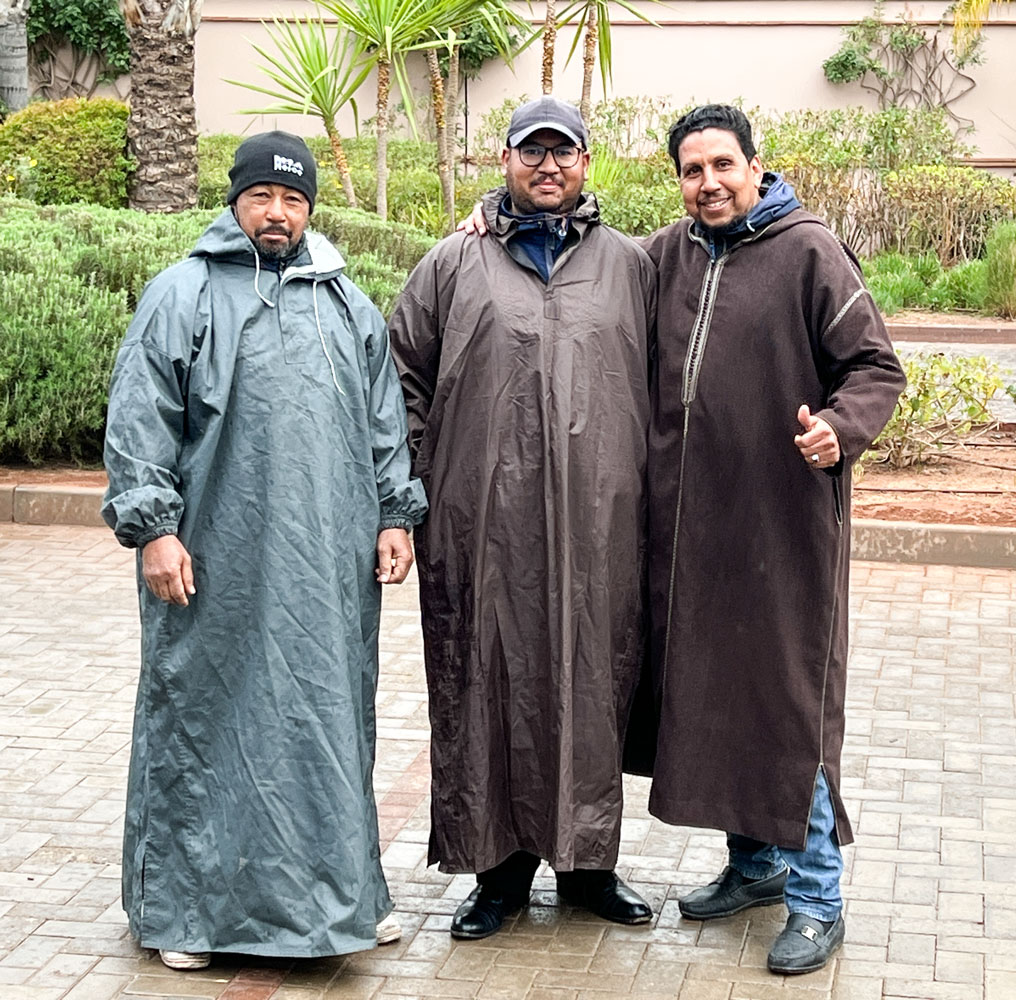
Soon we were off.
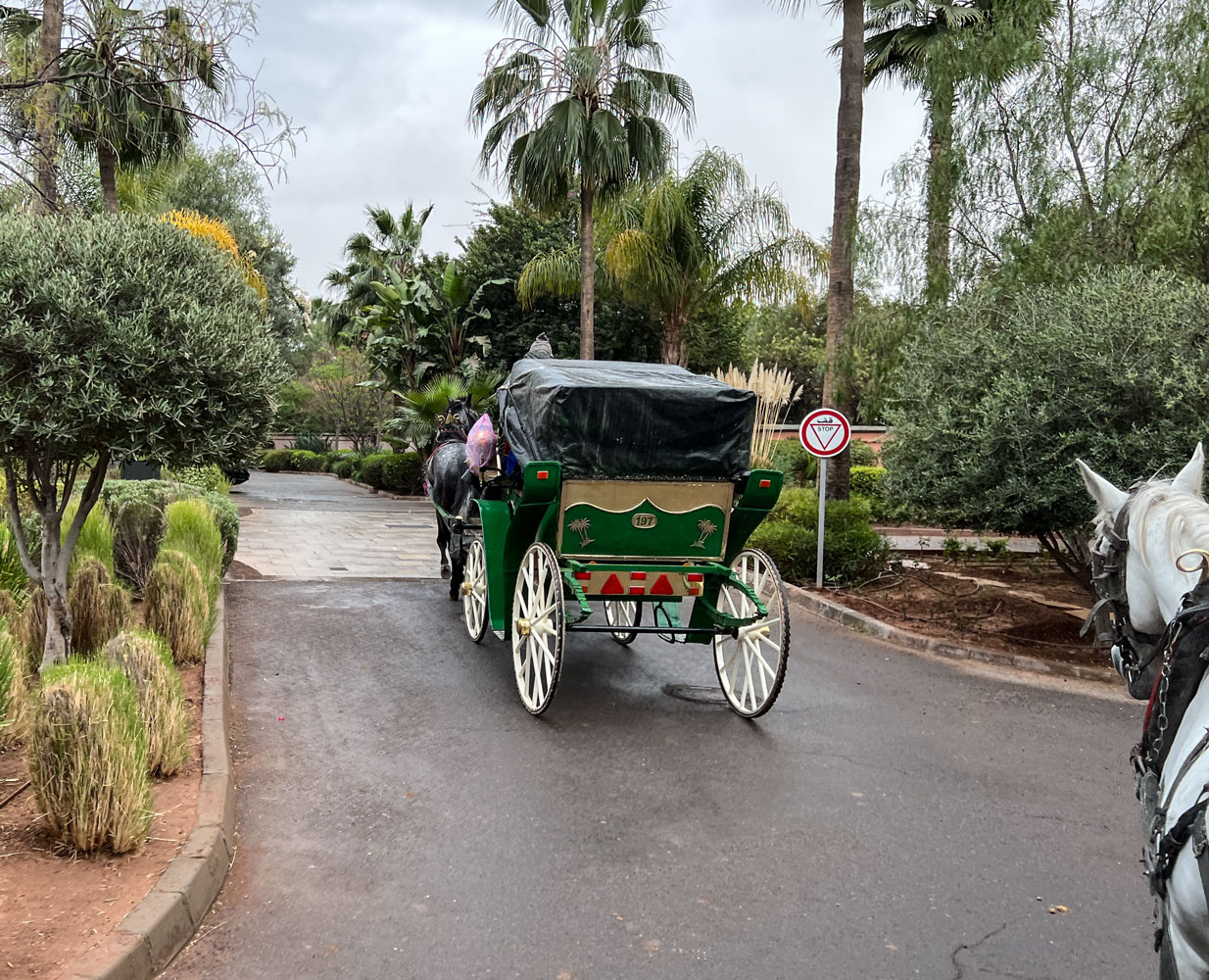
As the procession went around a turn, I could get a picture of the carriages following us. While it was cozy and dry in the covered cabin, the sides were open, so we could watch the view as we passed. These two horses are in perfect step.
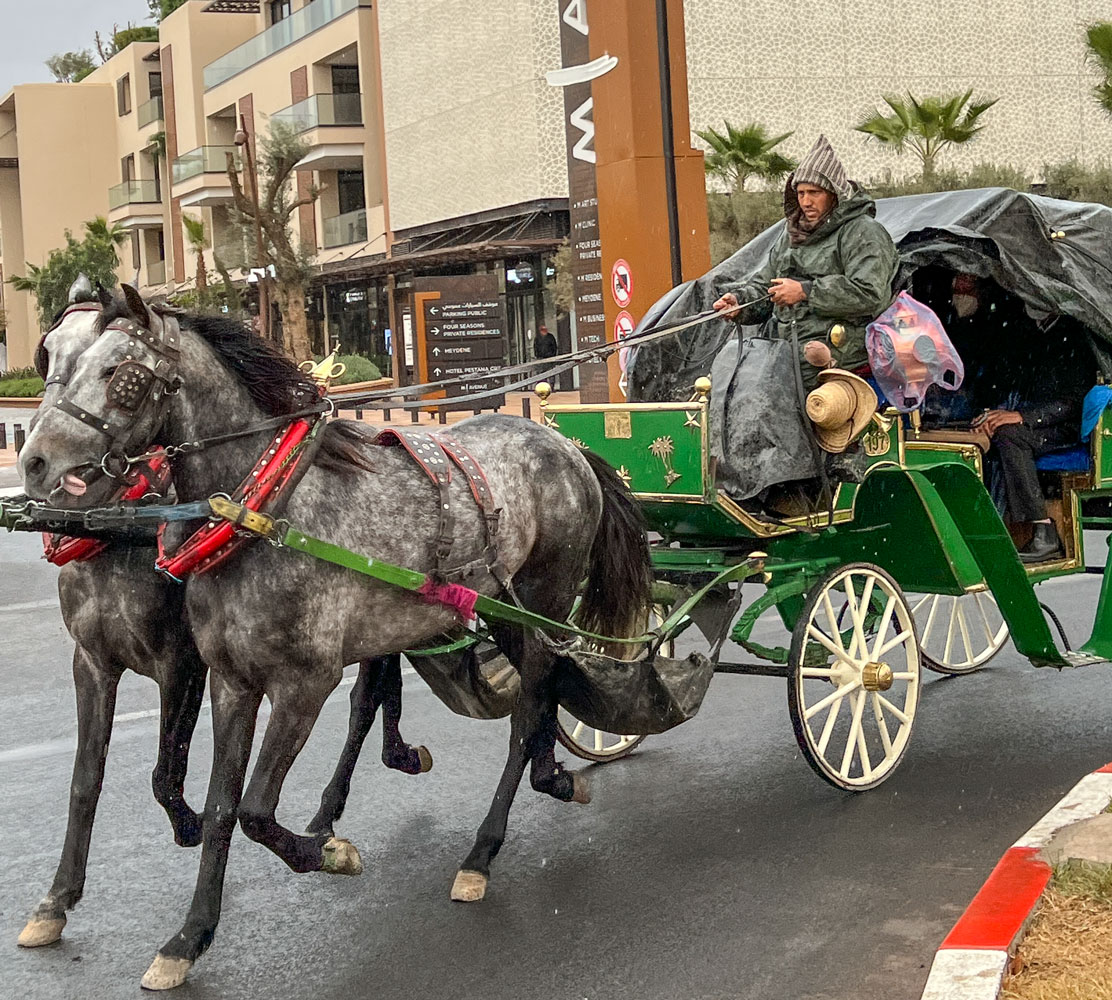
It began to rain harder as we went along.
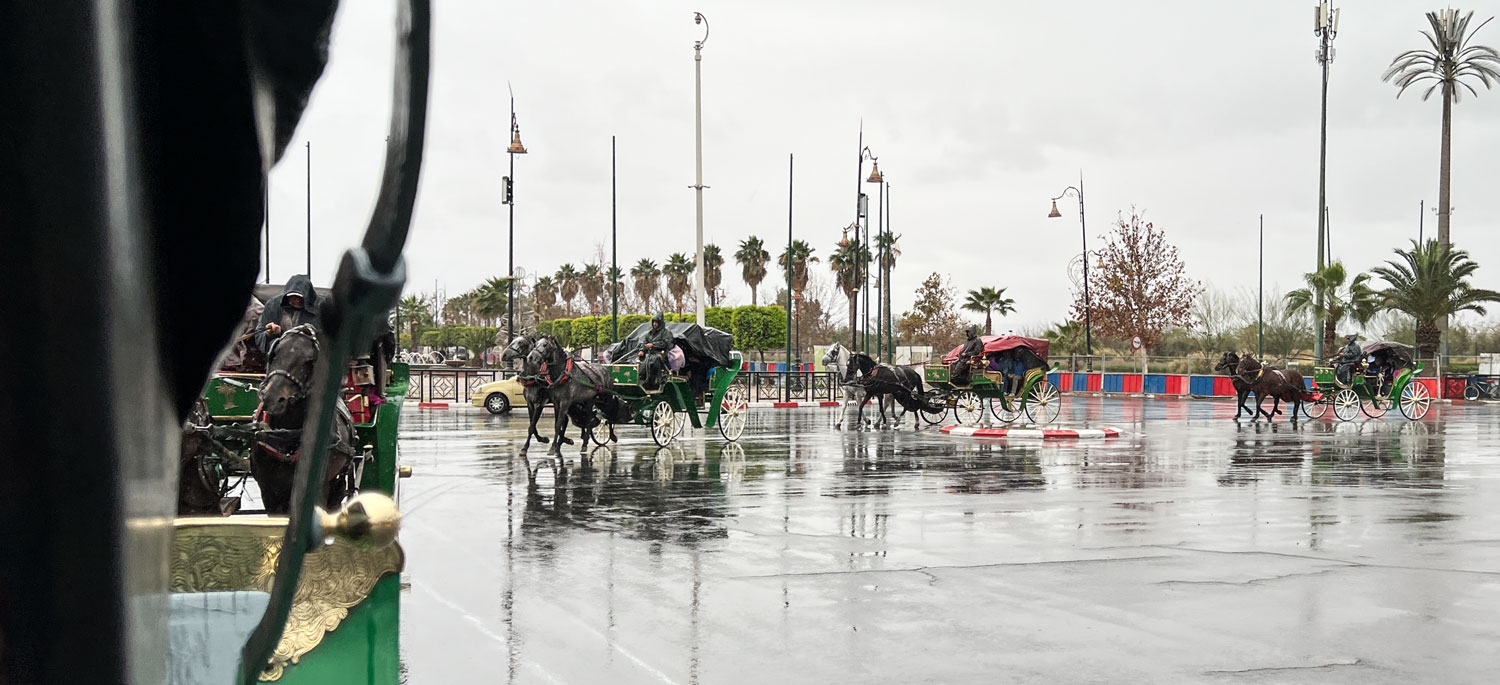
We were going to the Jardin Majorelle at the Yves Saint Laurent Museum, a distance of almost 5km (about 3 miles), through traffic. However, the other drivers seemed to give way to the carriages.
Our arrival at the garden. Note that Judy is holding an umbrella. The hotel provided each of us with an umbrella.
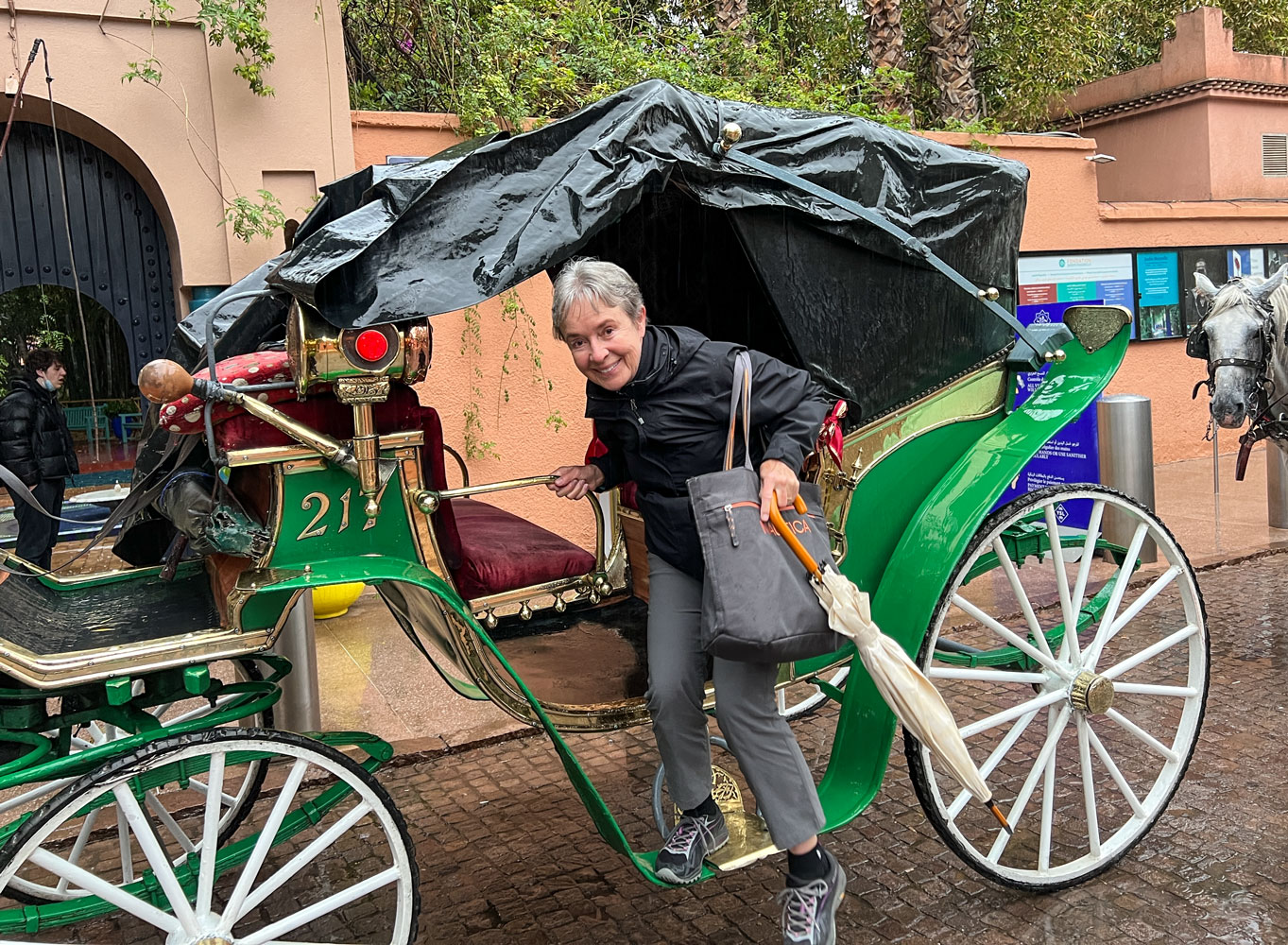
By the time we entered the garden, it was raining fairly hard. Here are Judy and Janet with their umbrellas. The water droplets show up as short white streaks.

Judy and I at the garden.
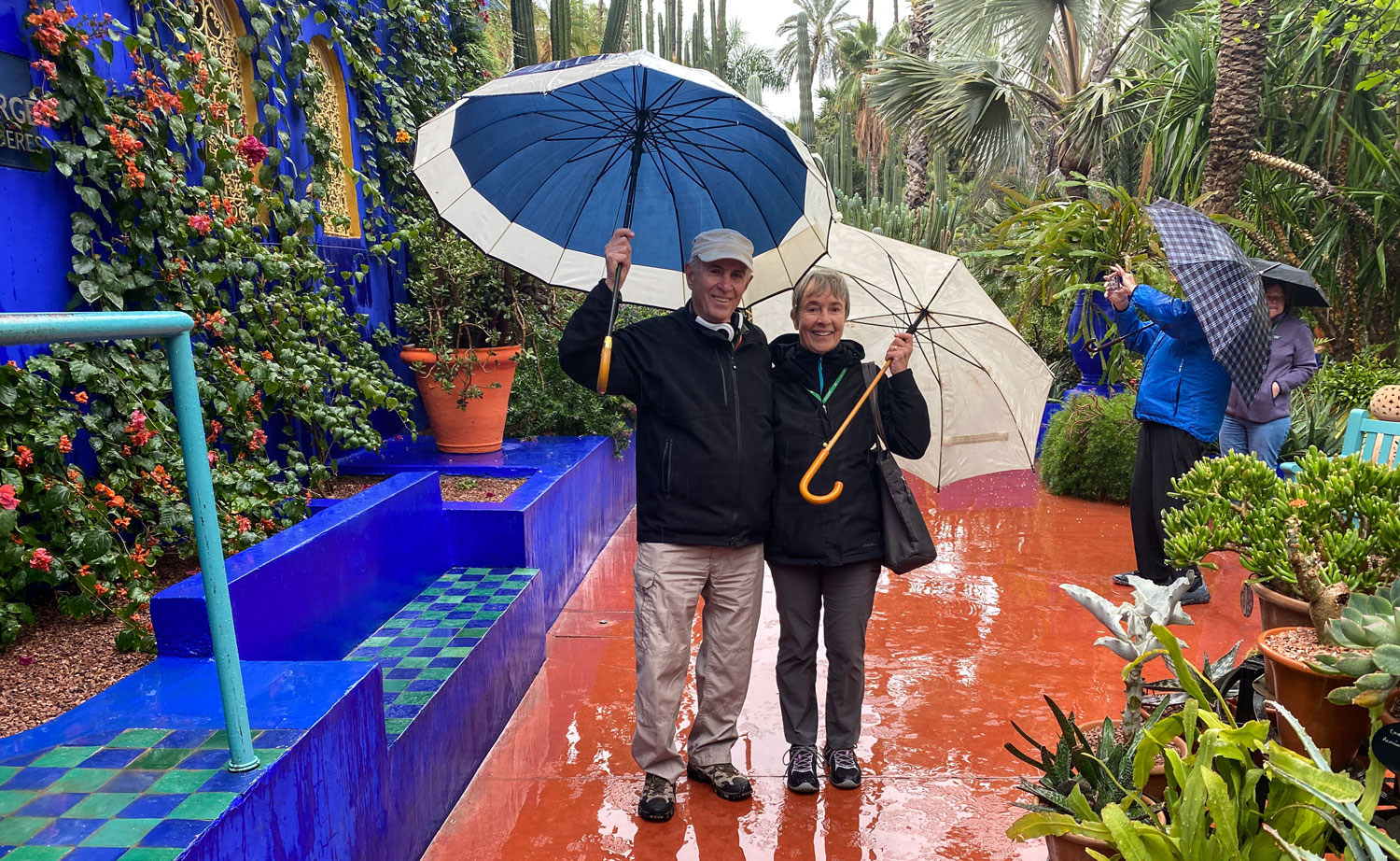
Nourdine is explaining about the garden. It was created by Jacques Majorelle, over forty years, starting in 1923. It was later purchased by Yves Saint Laurent and Pierre Bergé in the 1980's and restored by them. Yves felt a special bond with Morocco, and many of his designs were influenced by the styles and colors of this country.
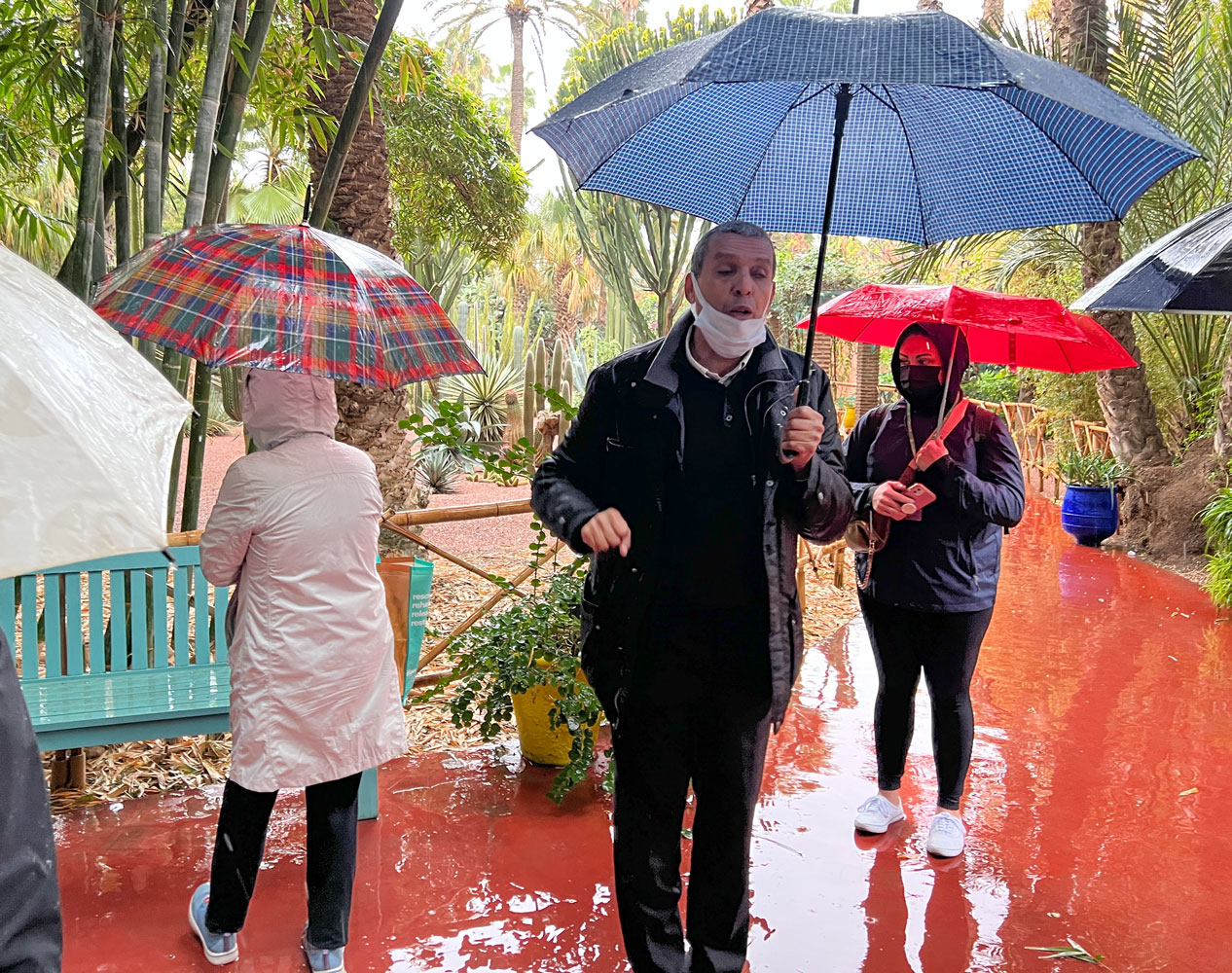
Yves Saint Laurent and Pierre Bergé are buried here.

A closer view of the gravesite.
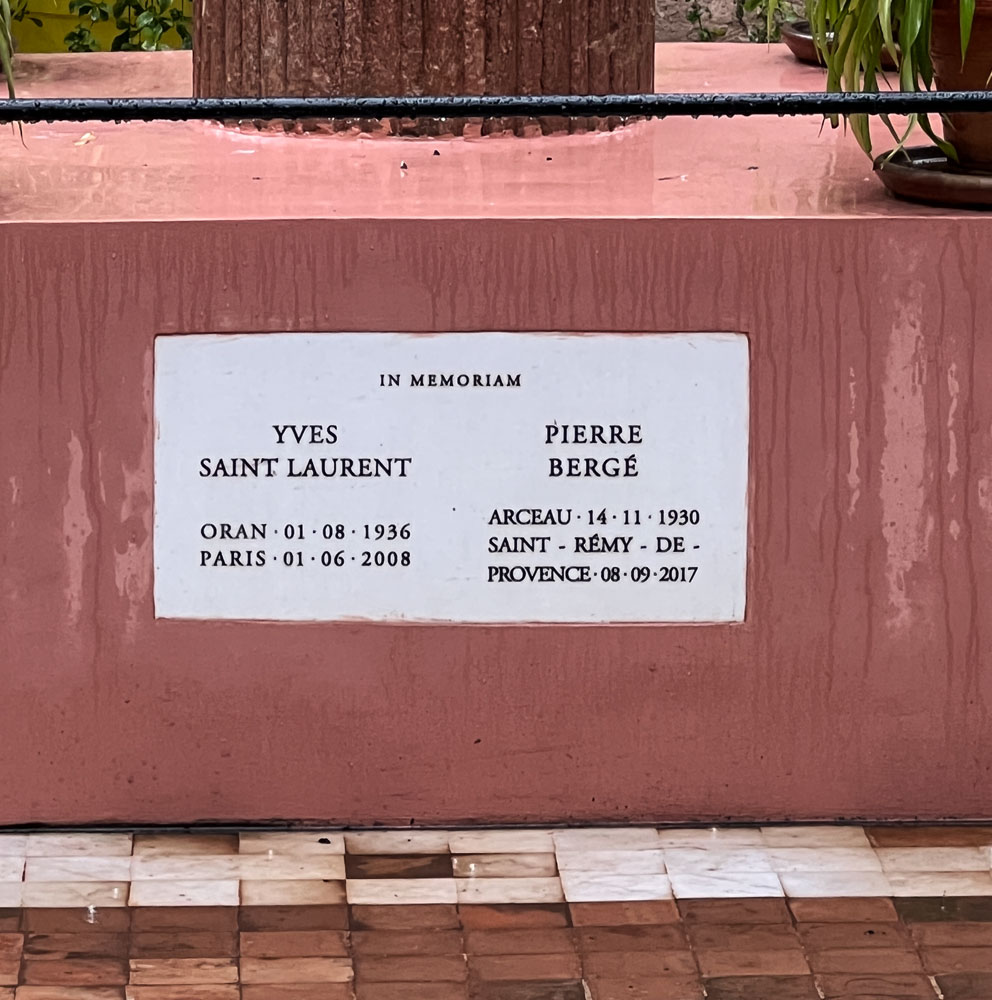
An arbor in the garden. There is a huge variety of foliage, and a marvelous cactus garden.
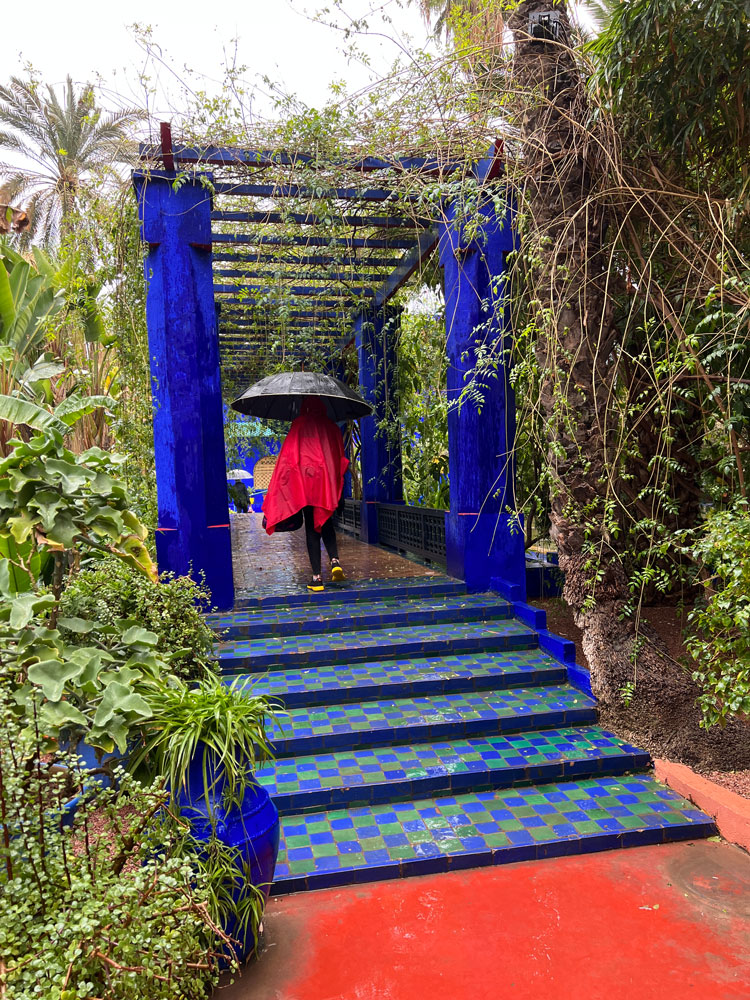
Then we went into the Berber museum. Pictures were not allowed in the museum.
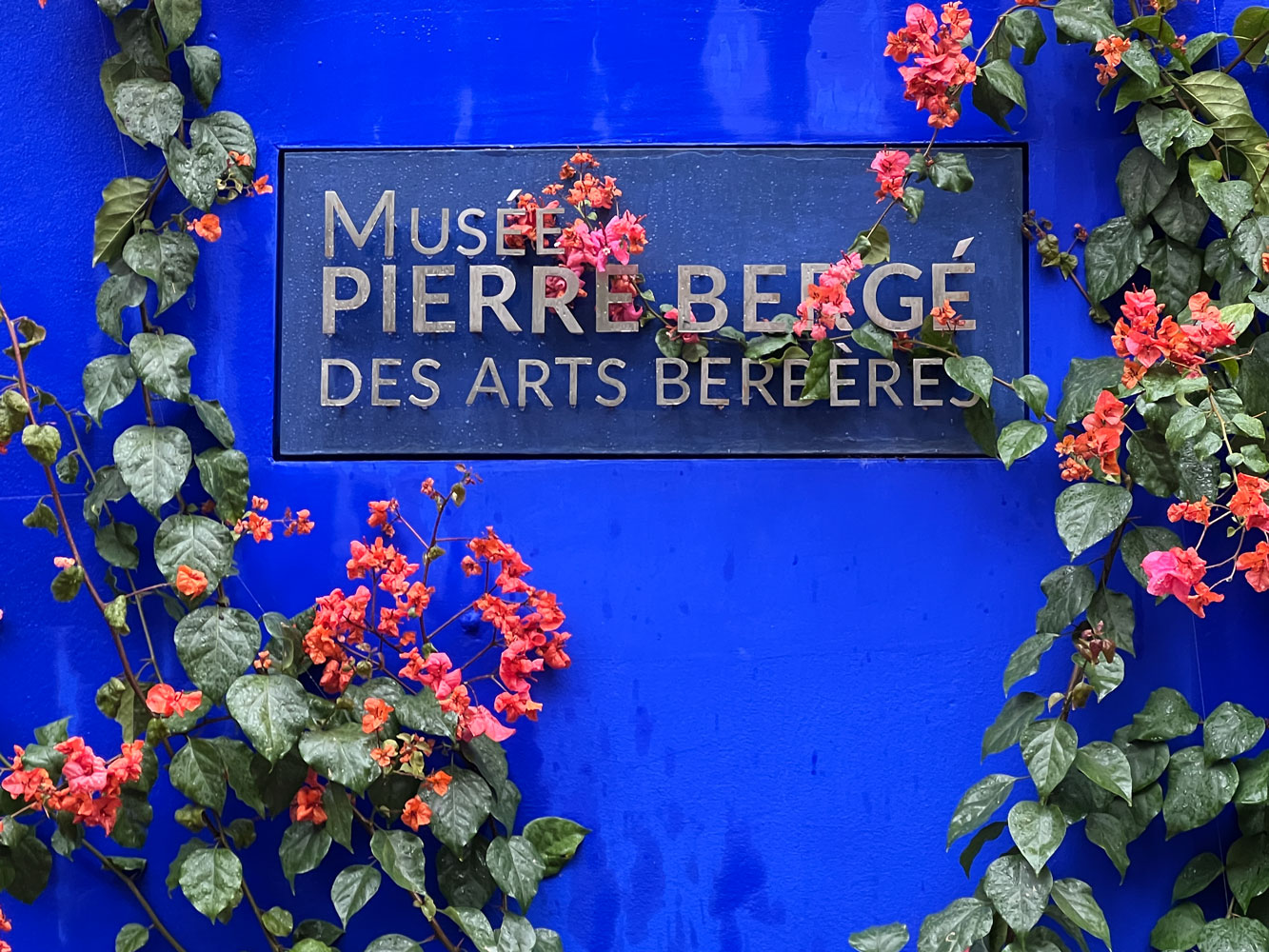
After going through the Berber museum, we went to Cafe Majorelle for a cup of coffee or Moroccan tea. Moroccan coffee is delicious. The tea is always mint, either with sugar or without.
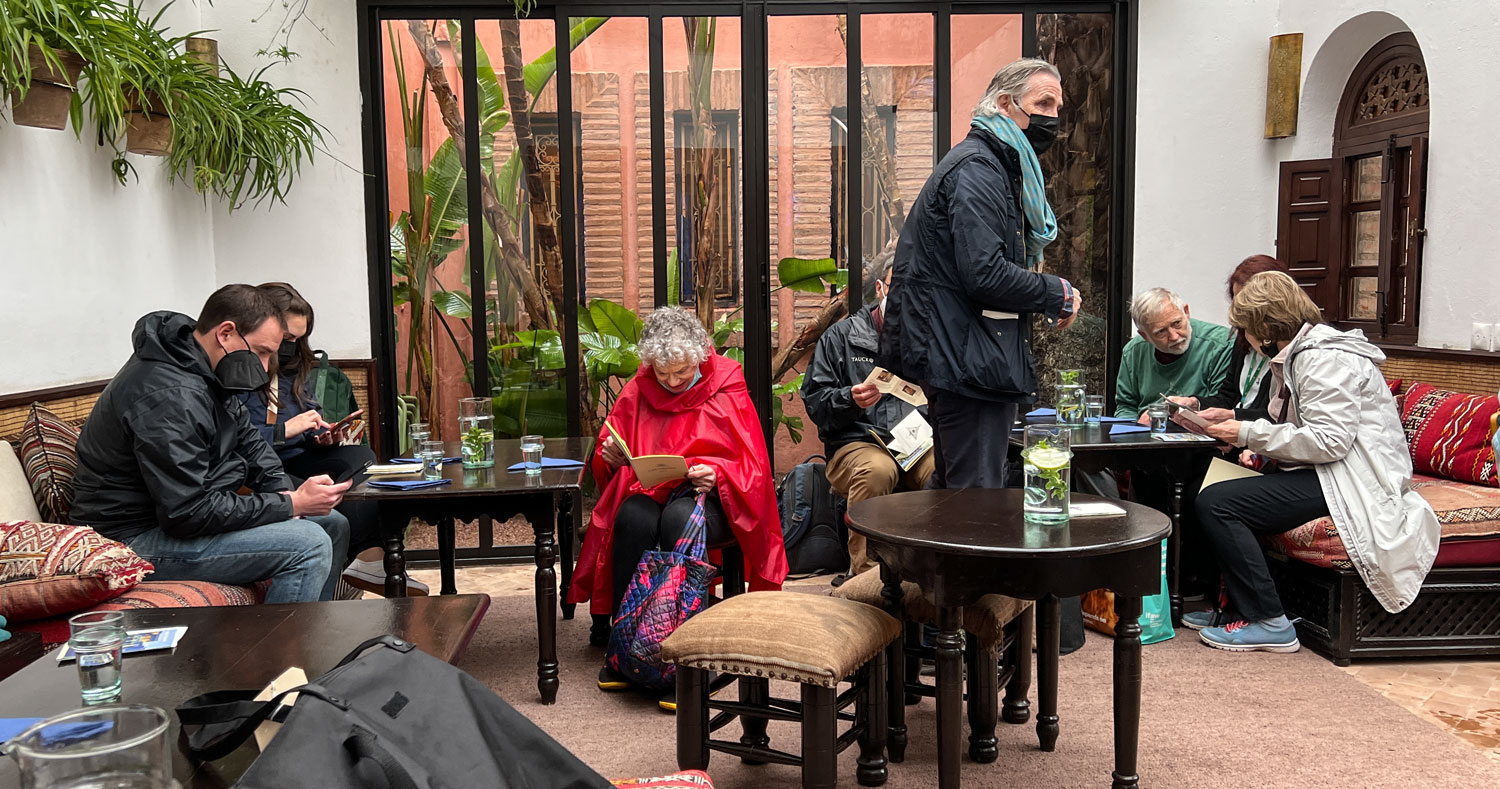
Here's the waiter pouring a cup of tea. They're very good at this - very little goes outside the glass. Its showy, but is actually supposed to aerate the tea. You can see the little bulge in the side of the glass, to make it easier to hold a hot glass.
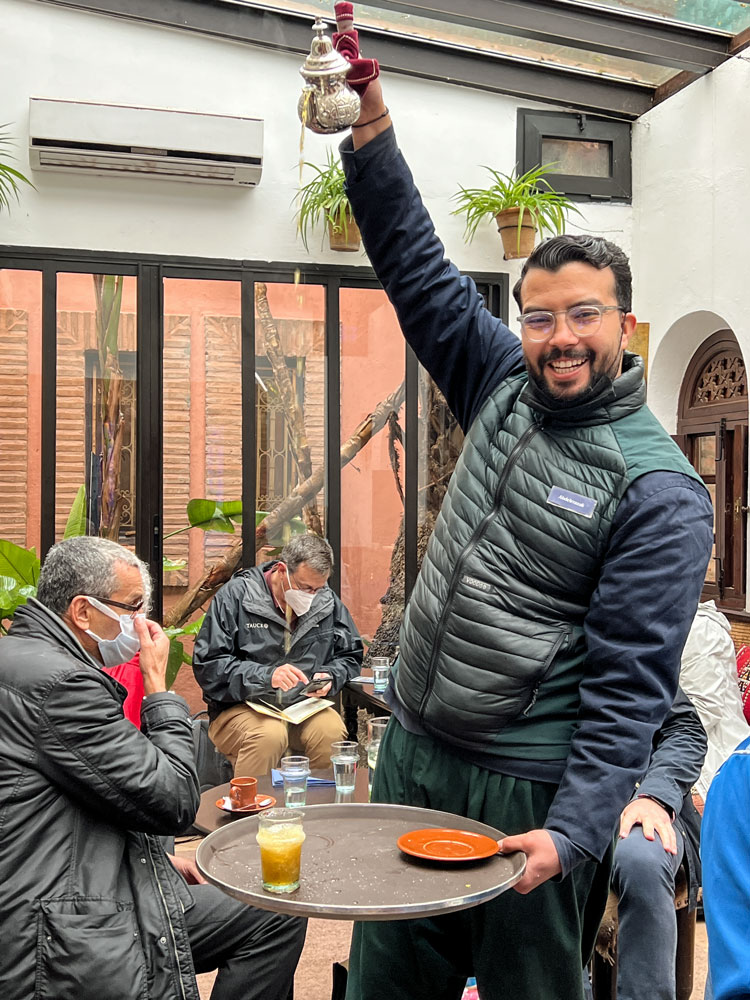
Then we went to the Yves Saint Laurent Museum.
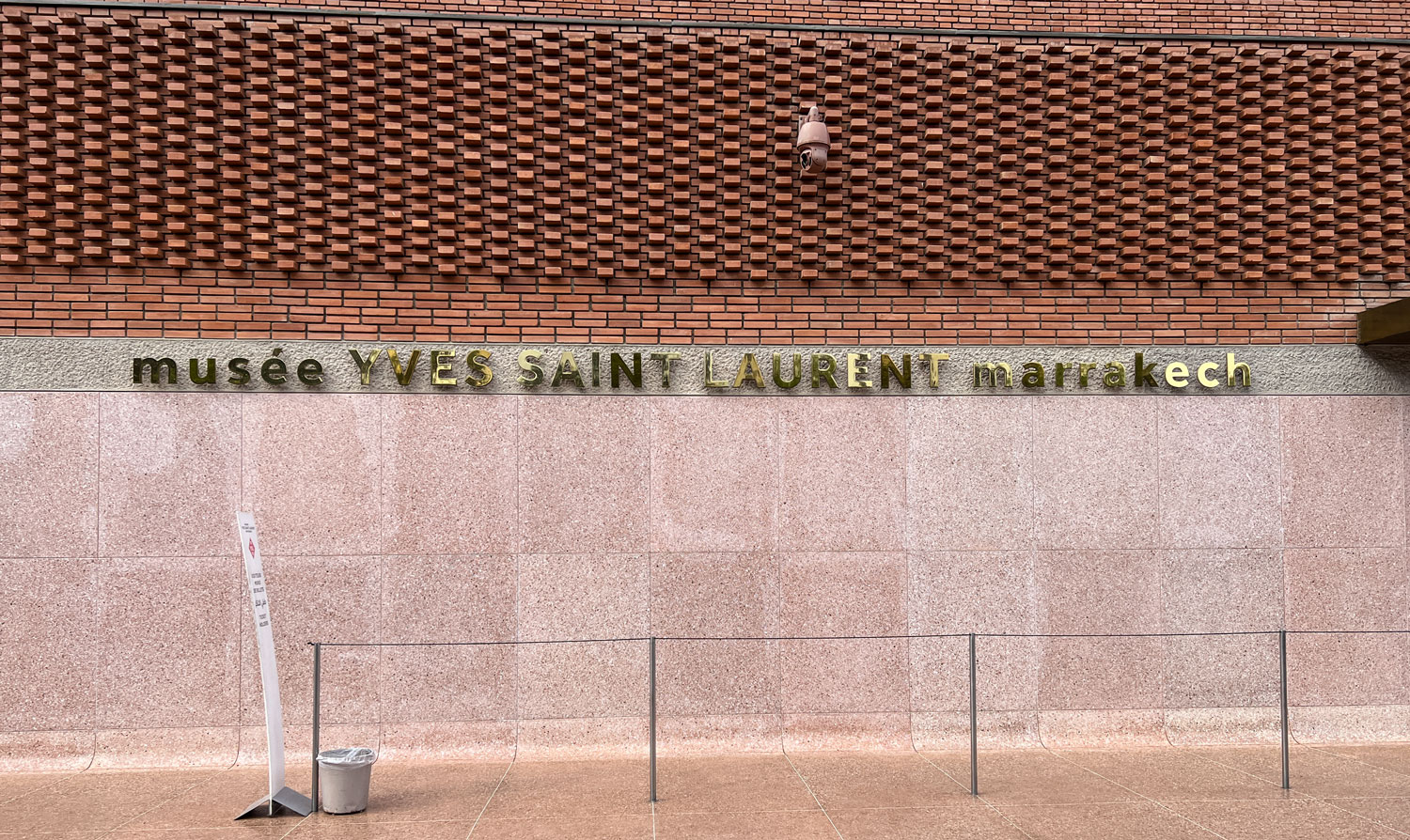
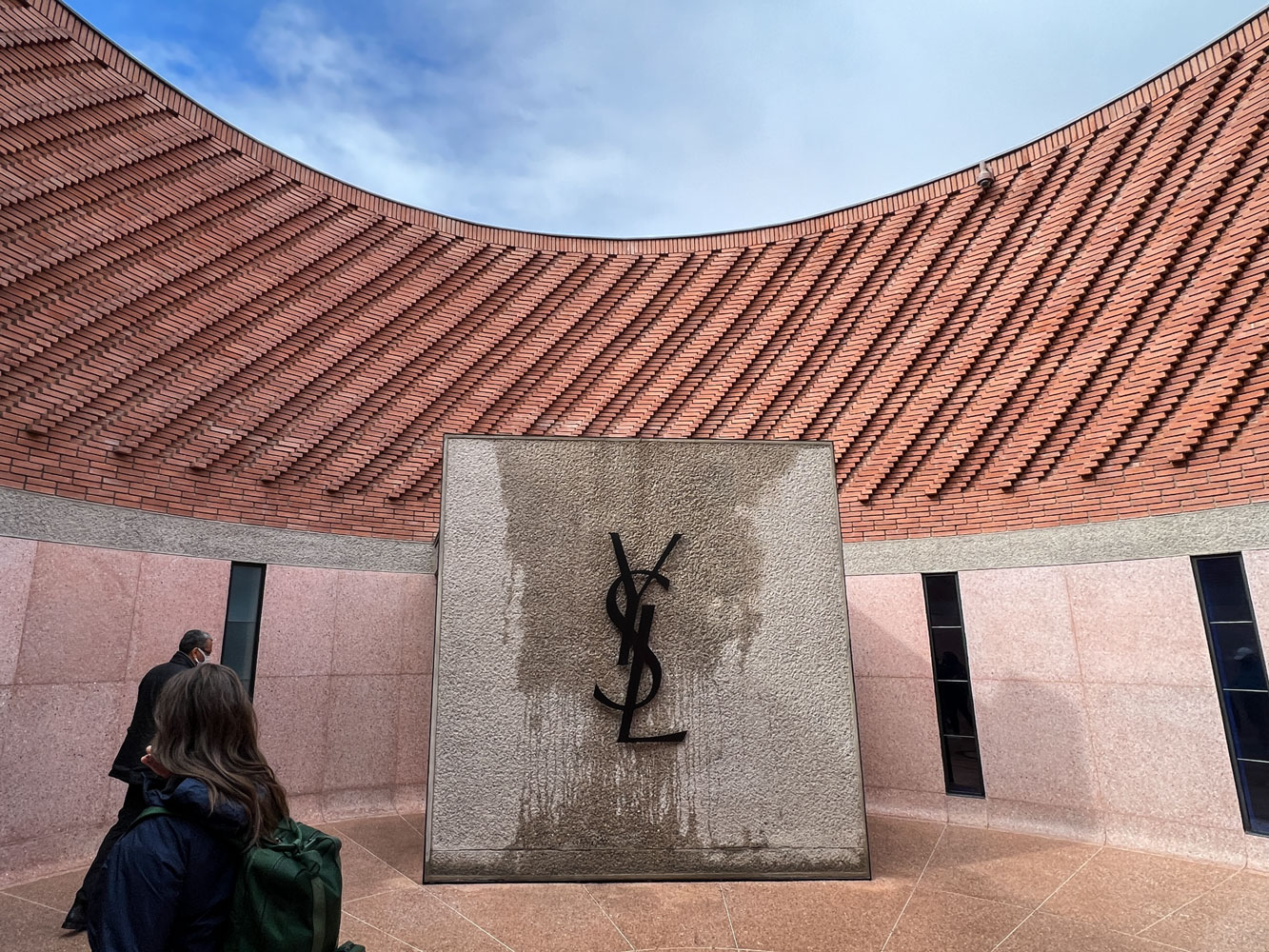
Pictures were not allowed in the museum, but the displays were of various garments that Saint Laurent had designed.
After the museum, we rode the bus back to the hotel and had lunch in the Quattro restaurant in the hotel. It's a good Italian restaurant.
That afternoon, Judy, Janet and I boarded a four-wheel vehicle for our trip to the desert. Here's our driver, Mohammed. You can see that his side window is wet. It was still raining off-and-on.
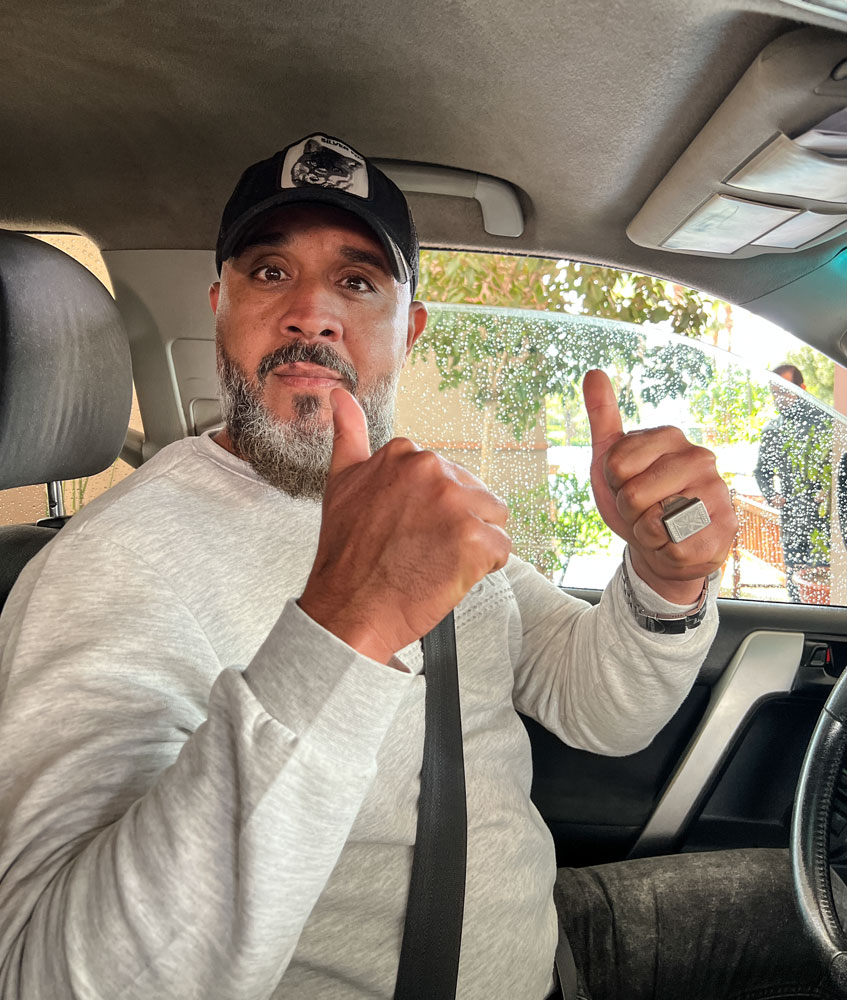
After driving for quite a while, we turned off on a dirt road, towards a small settlement.
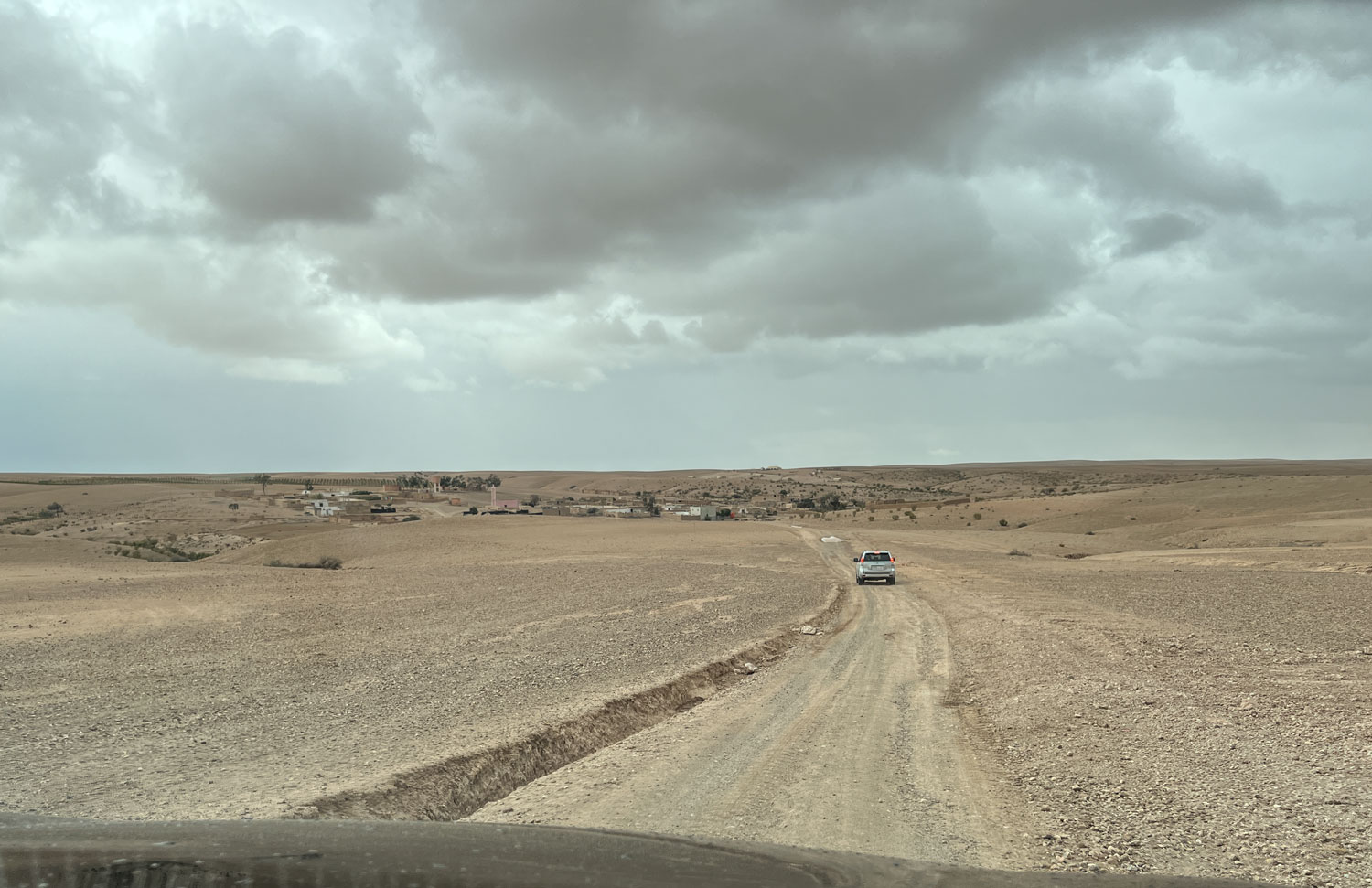
And stopped at a simple house.
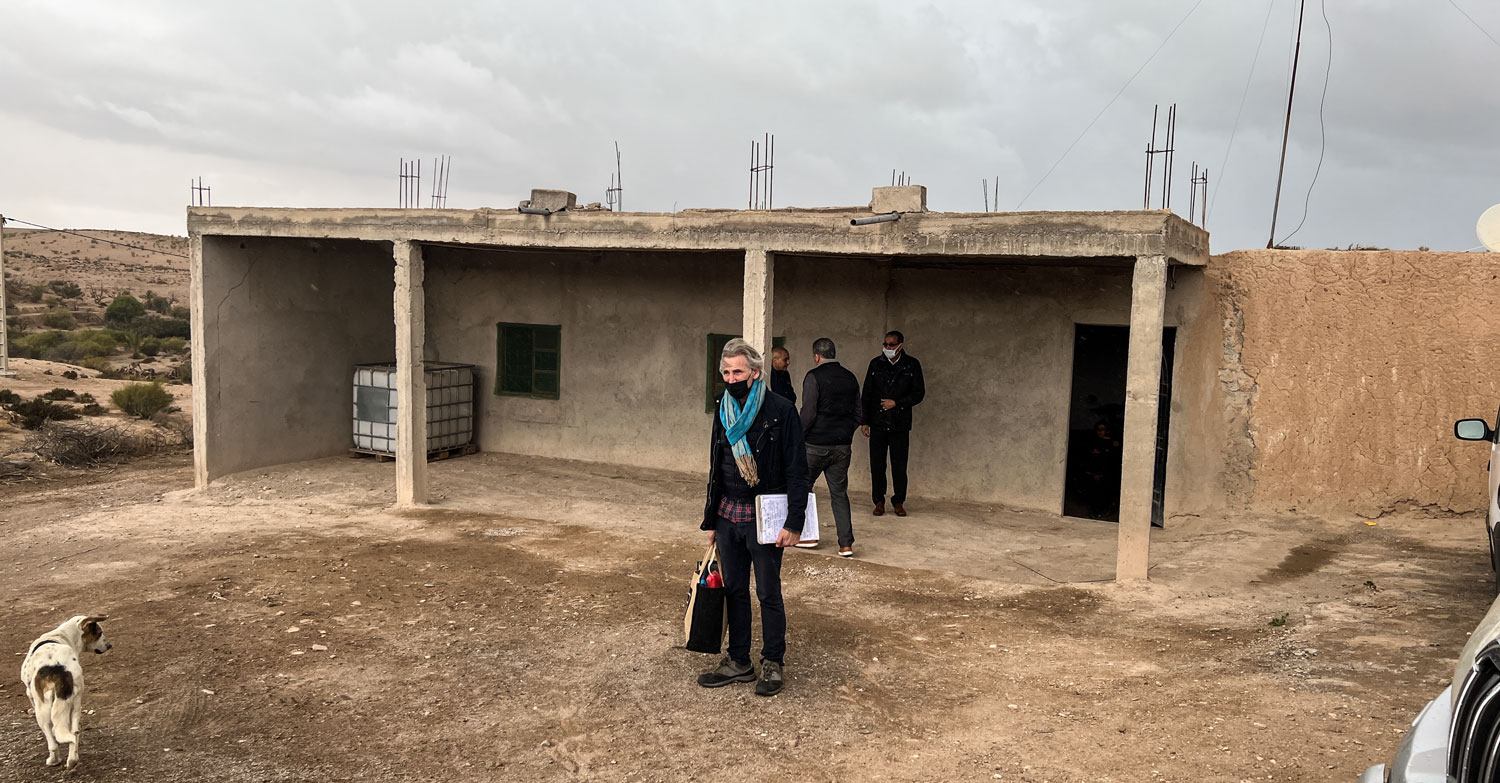
Three of the younger children who lived here.
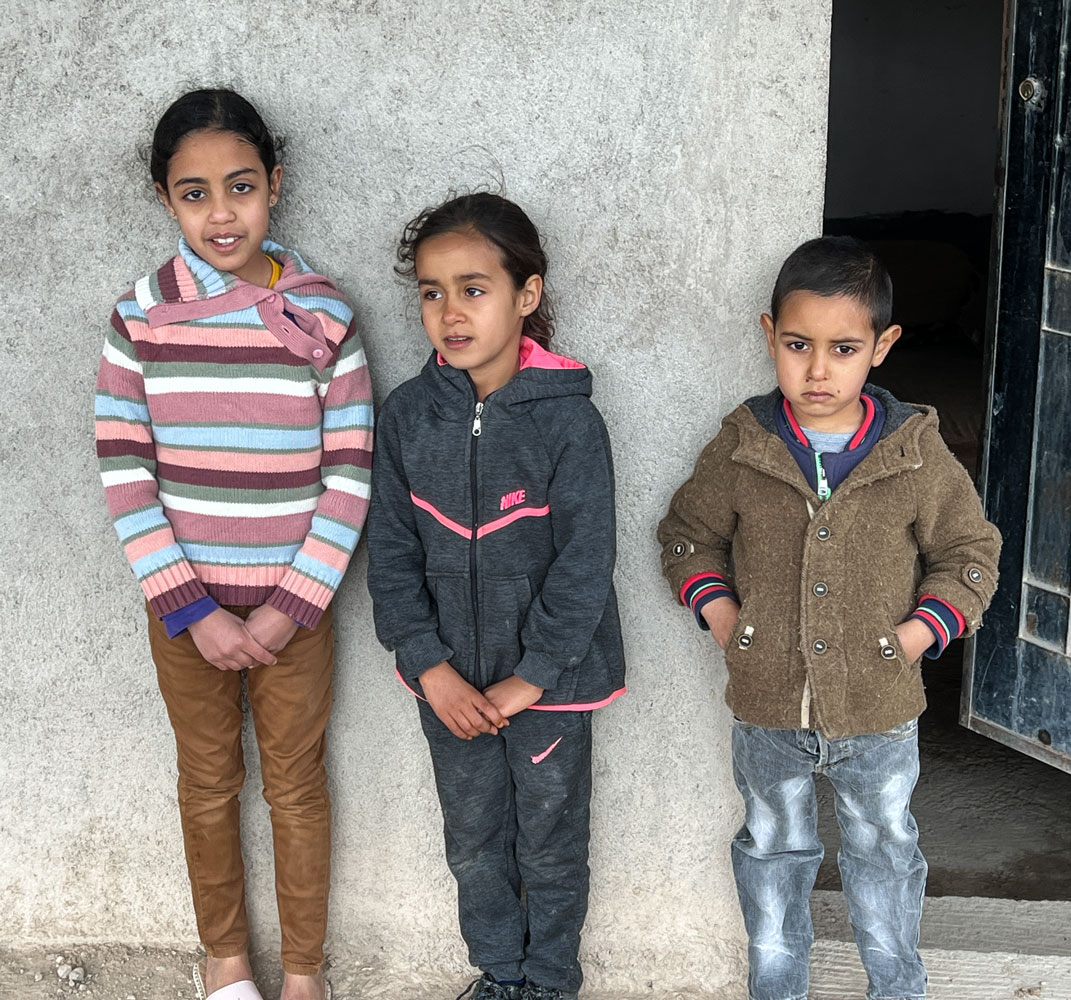
As we entered the house, this "formal" receiving room was on our left. Blue is definitely a popular color in this area of Morocco.
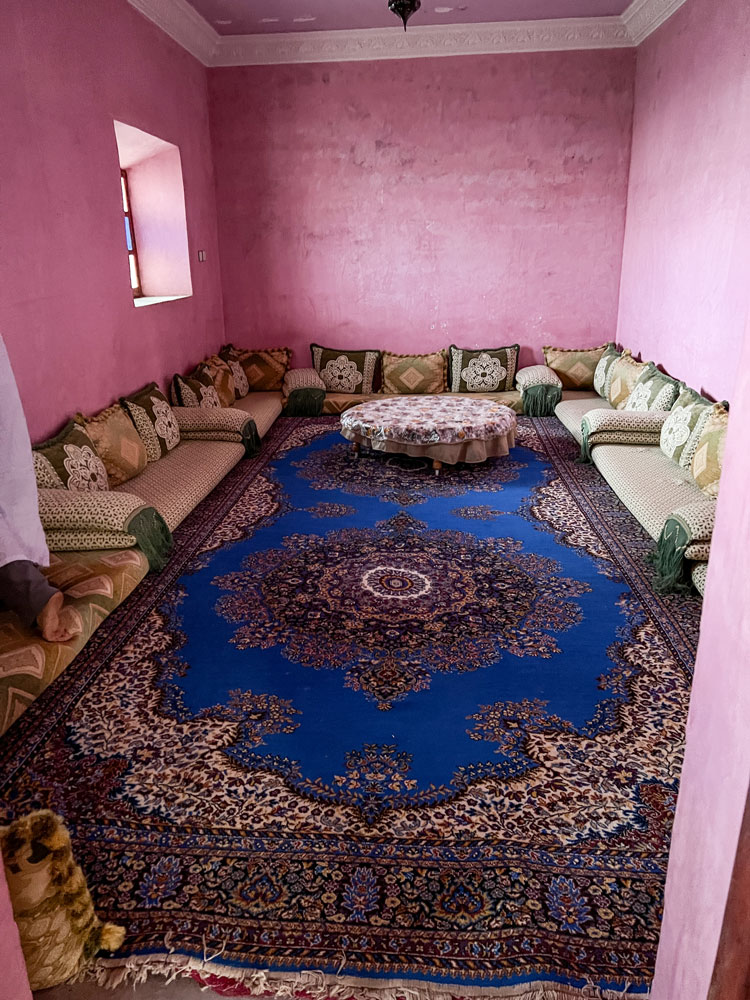
In the courtyard of the house, they had set up stools and low tables to serve us bread and tea.
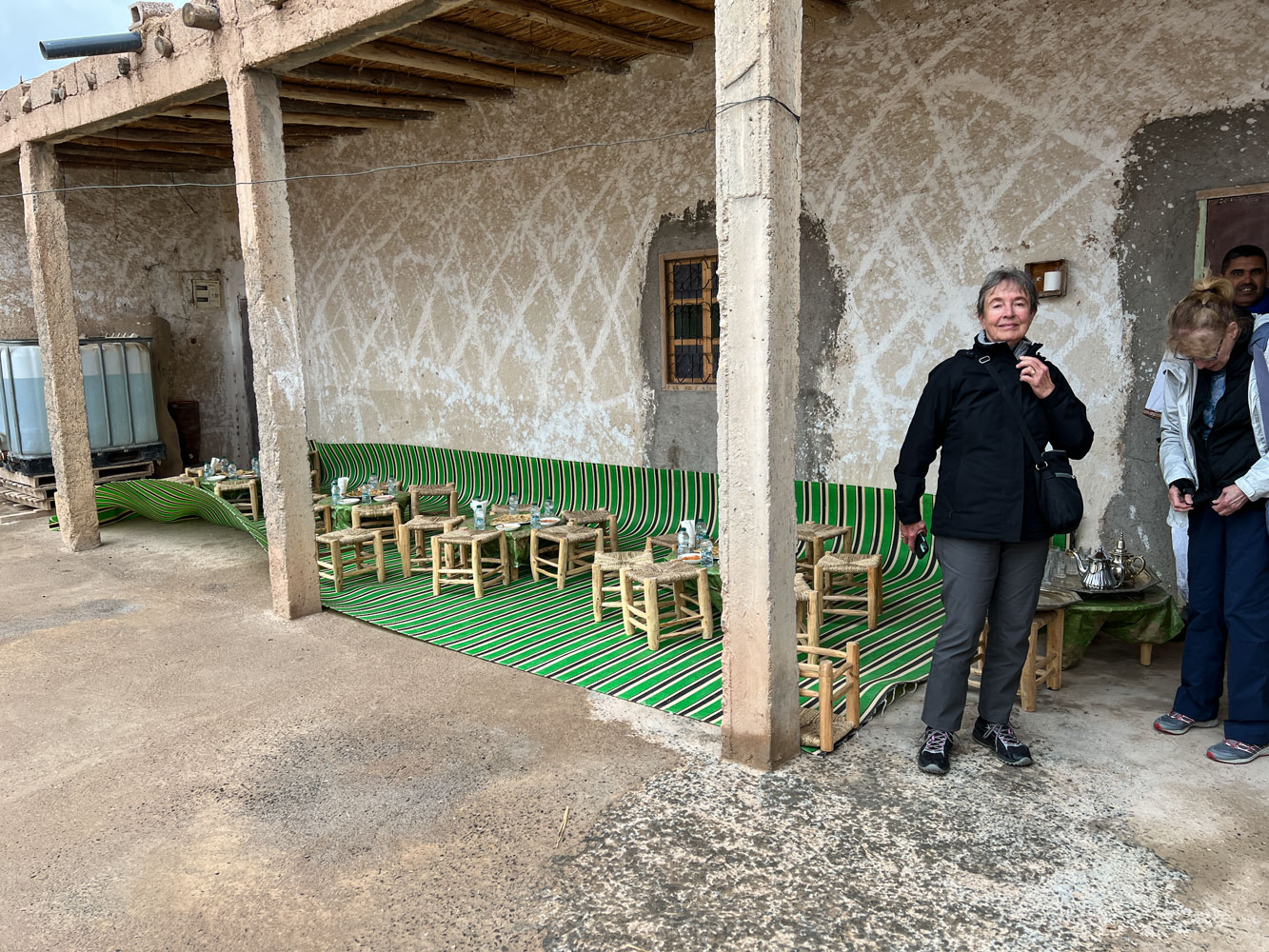
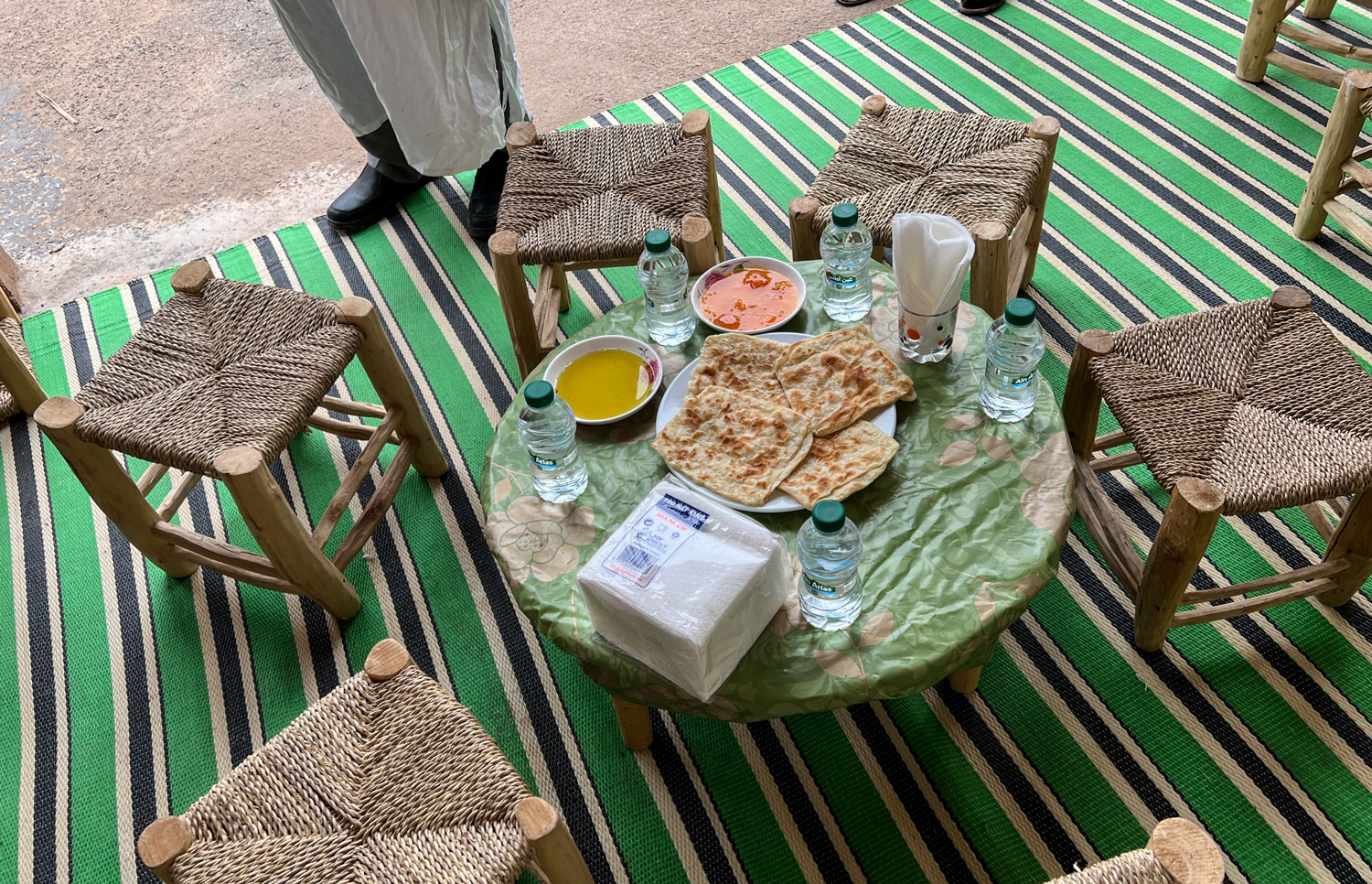
Here's our host, the owner of the house. Nourdine explained that he was the equivalent of the "mayor" of this settlement and that his house was better than most of the other houses in the area. Note his deep blue scarf.

It was decided that it was a bit too cold to sit outside so we moved into the "formal" room. Note that everyone has removed their shoes to keep from tracking dirt on the carpet.
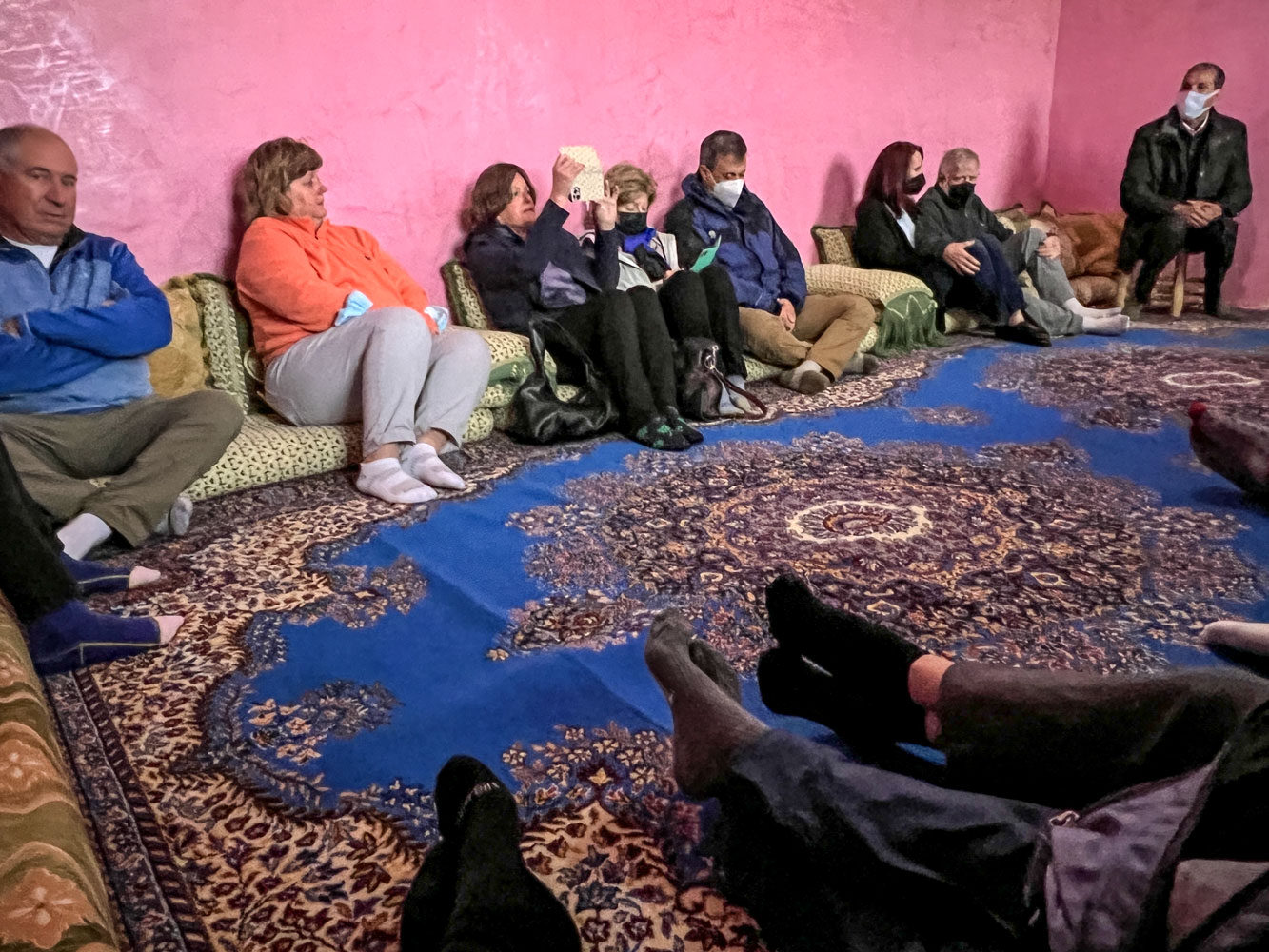
They moved the small tables into the formal room.
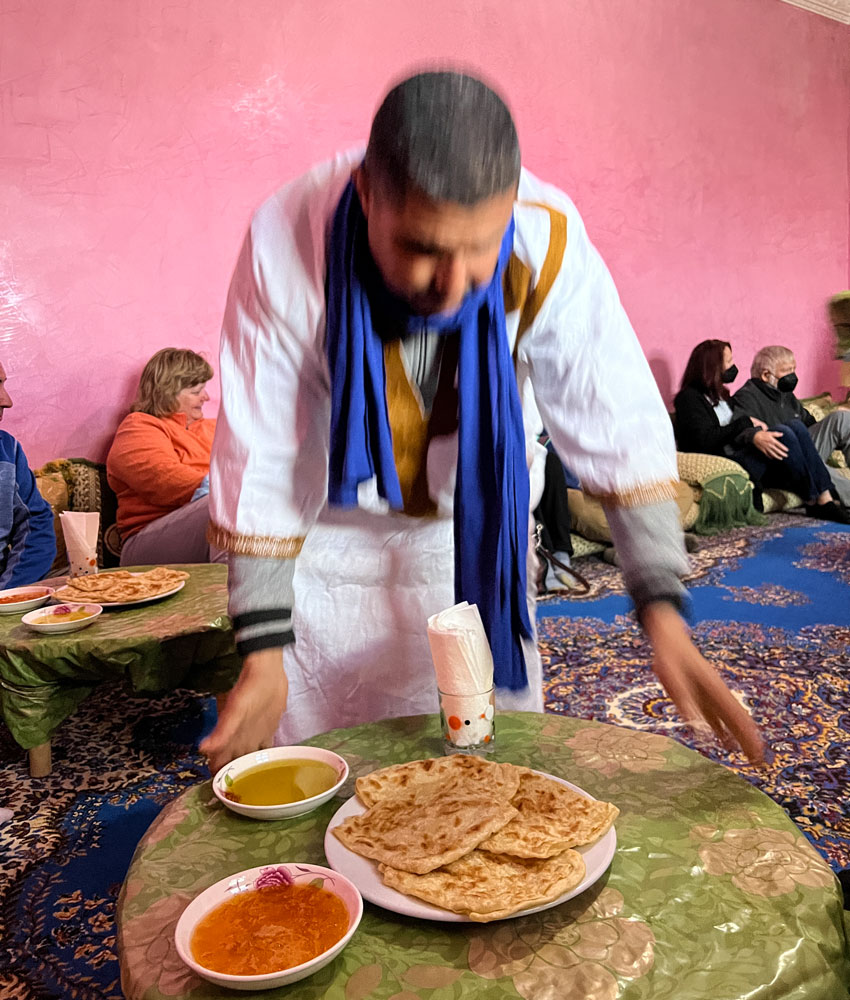
One of the daughters brought a gift for each of us. It was a pretty little box holding a bracelet with a "hand of Fatima" emblem.
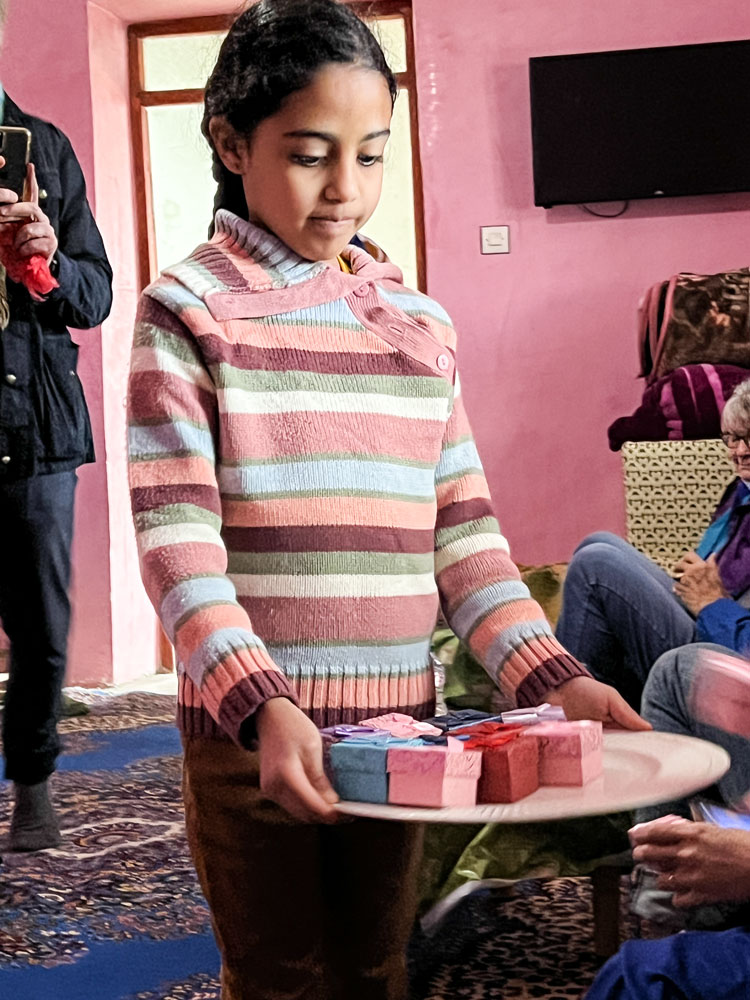
Nourdine explained about life in a small, rural settlement. In his hand he's holding a package of sugar. It's not loose sugar like we get, it's a "cylinder" of sugar, and is solid. The user has to break a piece off to use. He also said that sugar is a good gift in this area, often as a wedding gift. It's useful and it won't spoil. Most of the sugar is raised in Morocco, from sugar beets. We had seen examples of sugar hammers in a museum, and this explained what they were.
I was across the room when I took the next three pictures. You can see that the iPhone 13 does not take good telephoto pictures.
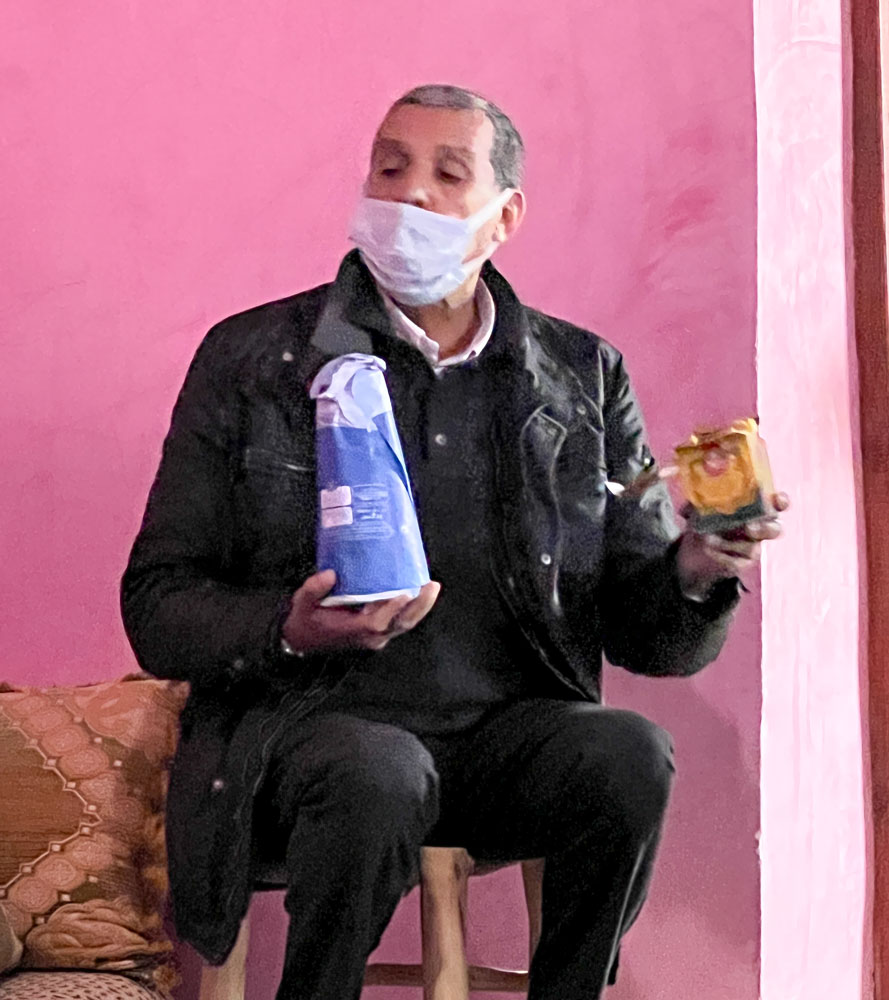
Here's our host with the block of sugar. He was a proud and gracious host.
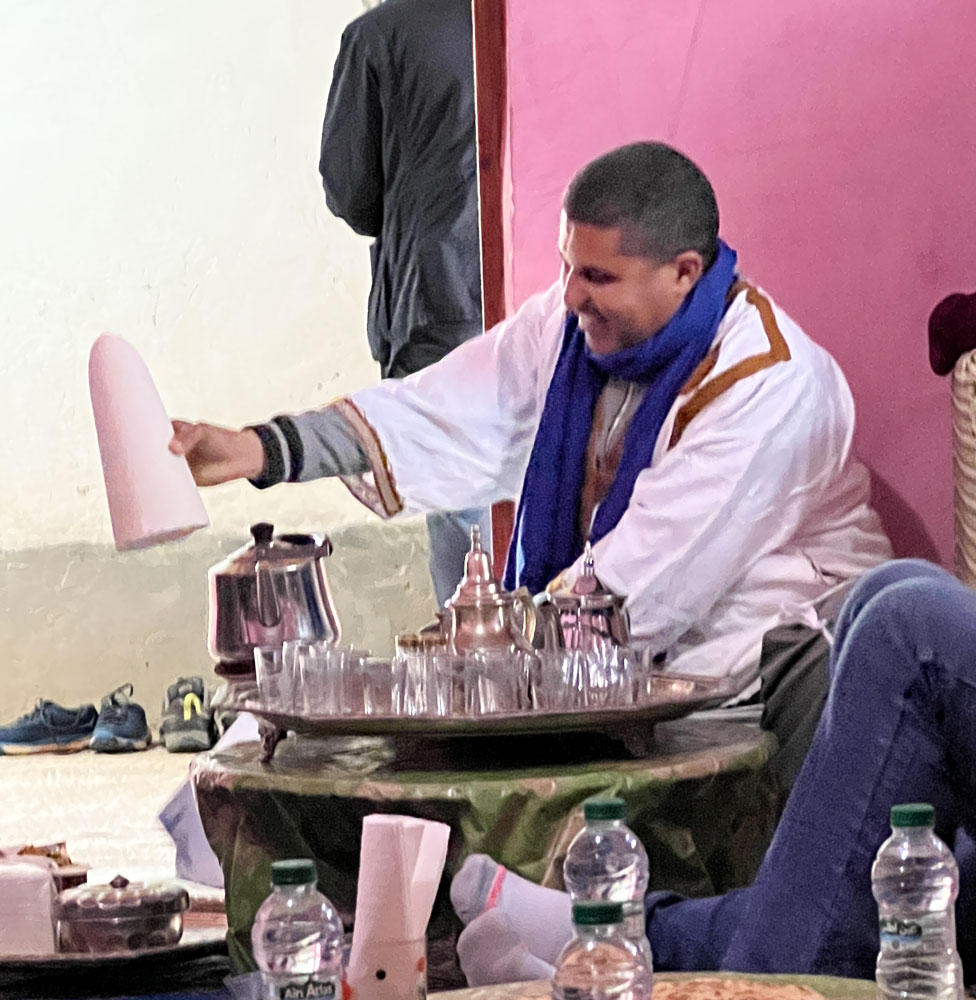
Pouring tea.
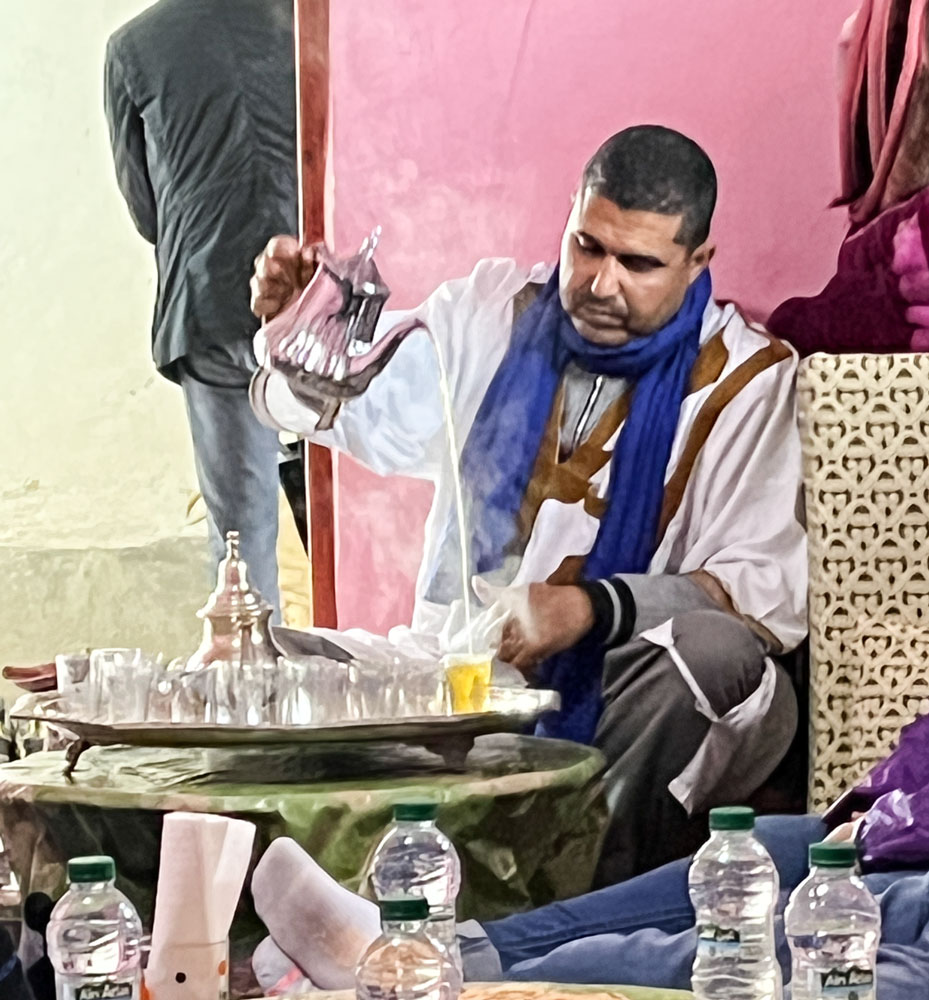
Serving a cup of tea to Judy.
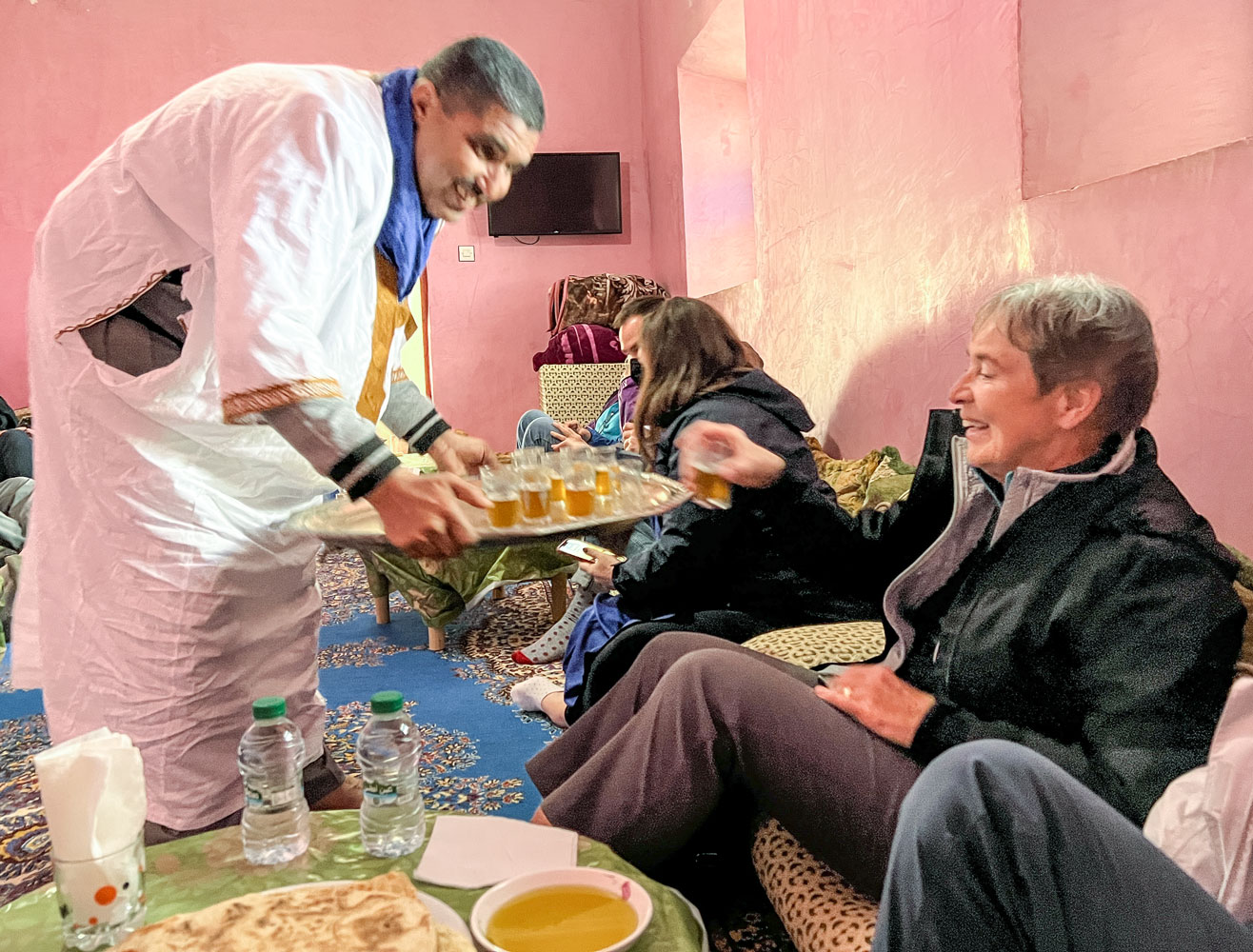
Judy and Janet with tea.
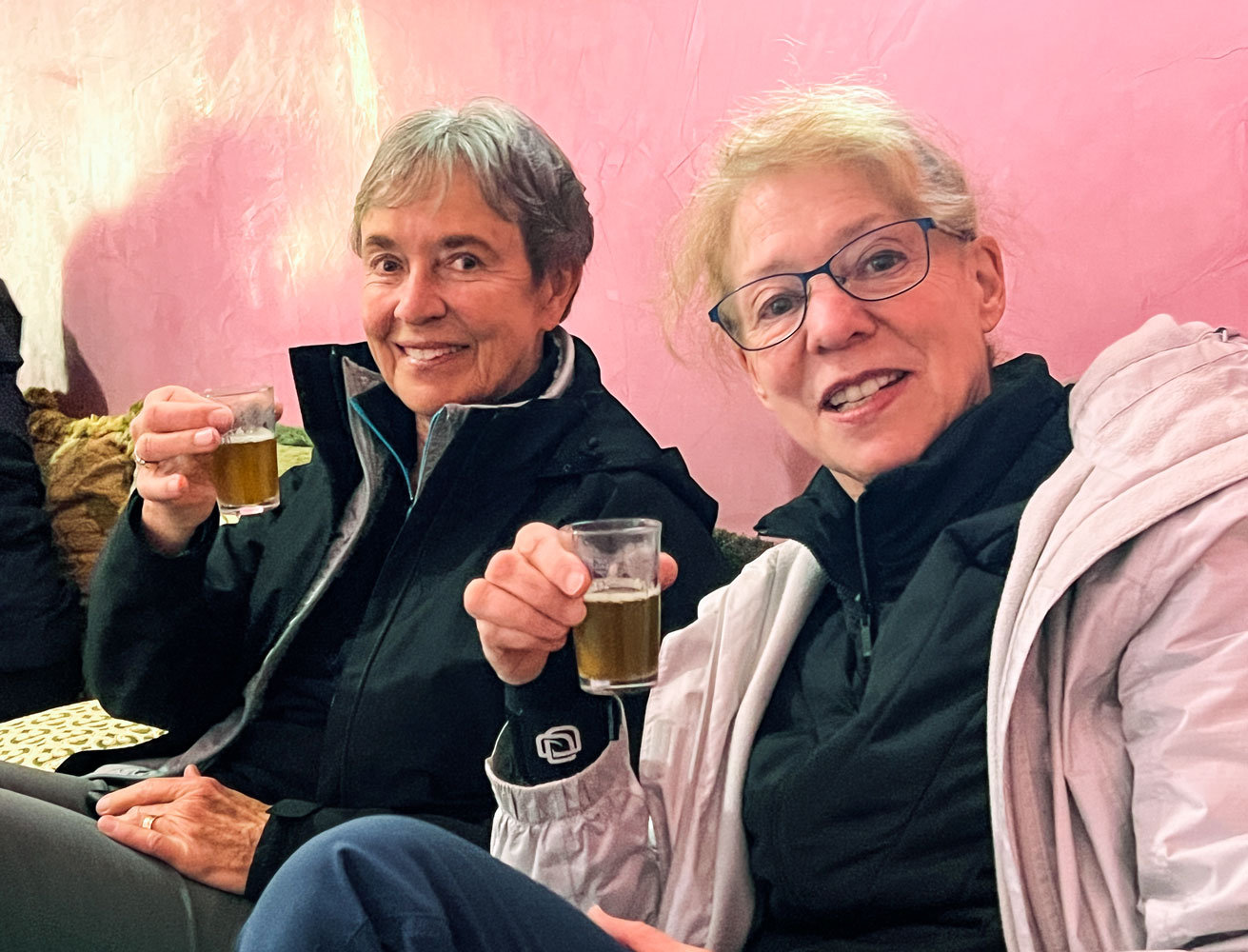
After sharing the tea and bread, we left with thanks and headed to our desert event. When we arrived, there were two musicians playing.
The man with the Fez twirled the tassel on the hat by moving his head in a circular motion. He kept that up almost all evening.
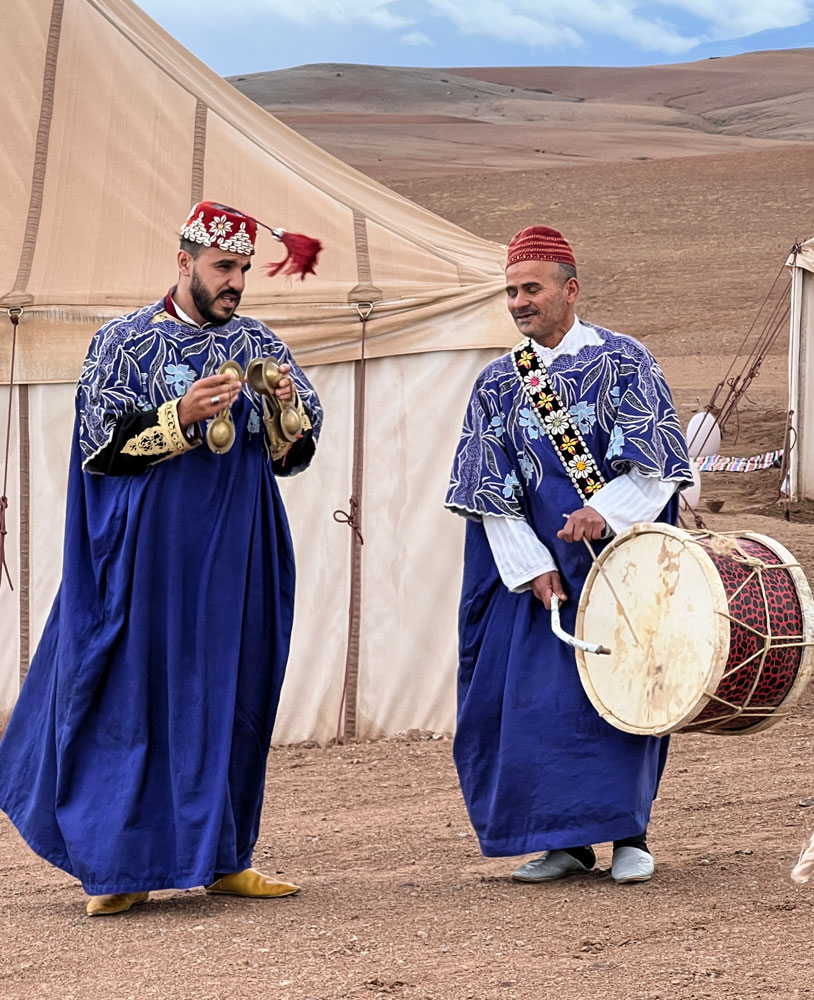
Here's one of the attendants. Look at his elaborate turban/scarf.
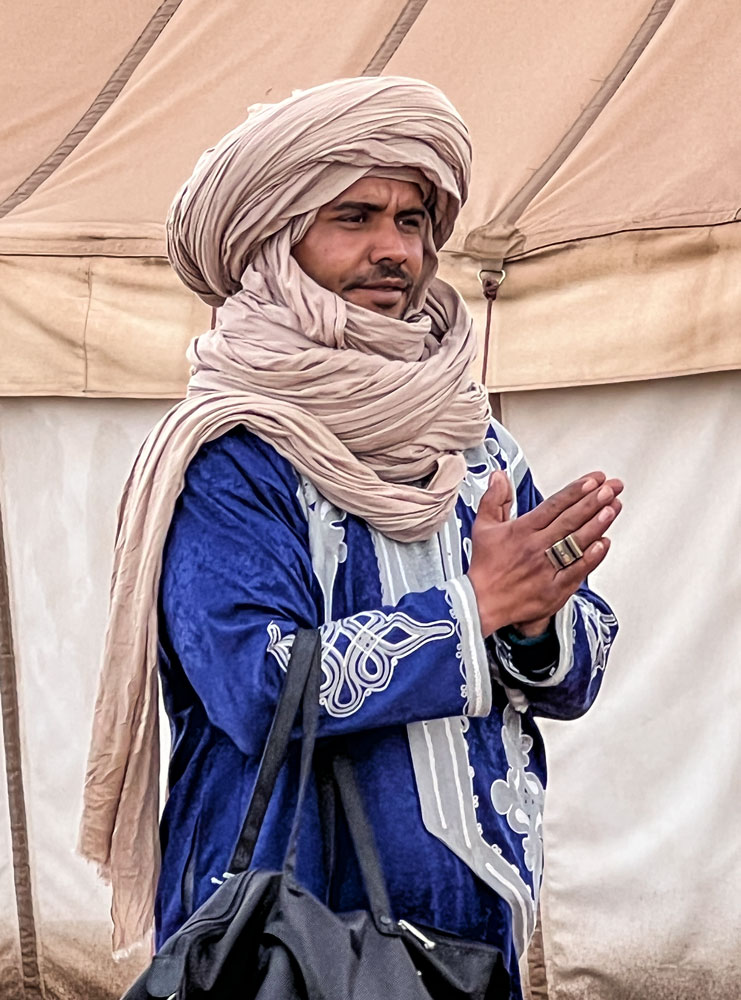
Tauck had given each of us a burnouse and a scarf. We put on the burnouse and the attendants helped us with the scarf. Here's Judy getting help with her scarf.
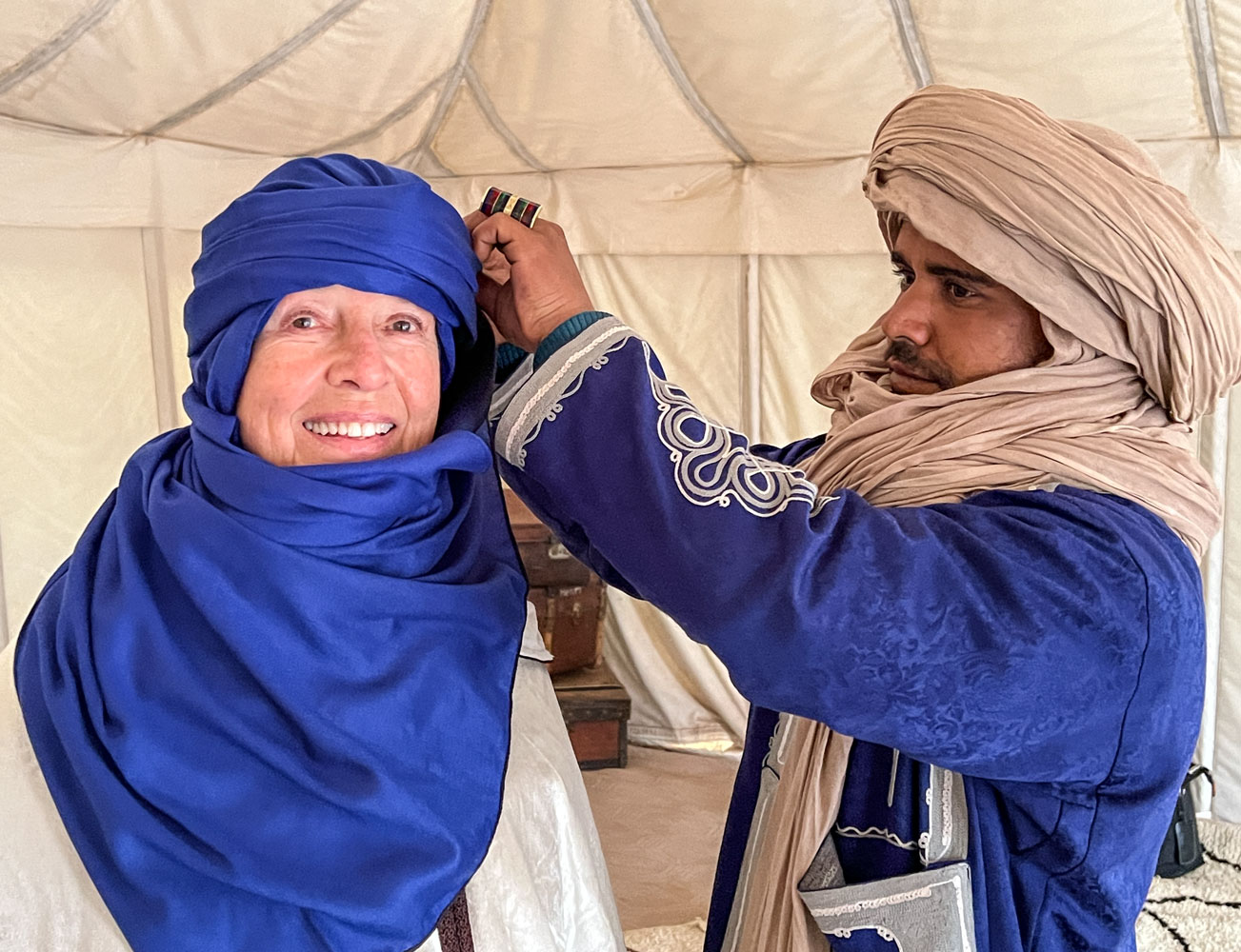
Janet got the same treatment. Again, more of the wonderful bright blue.
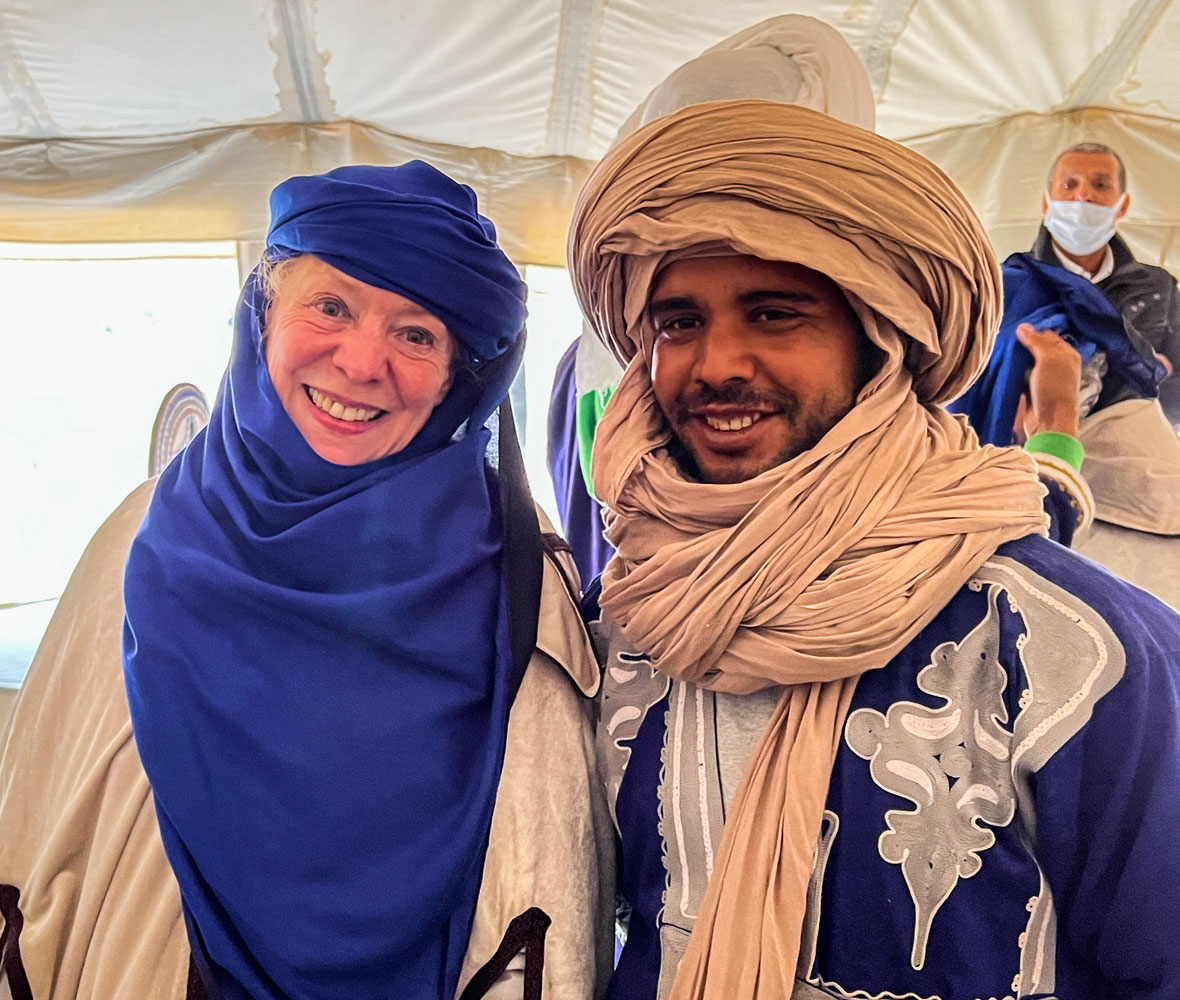
A picture of me in Arab dress. I think I look a bit like T. E. Lawrence:-)
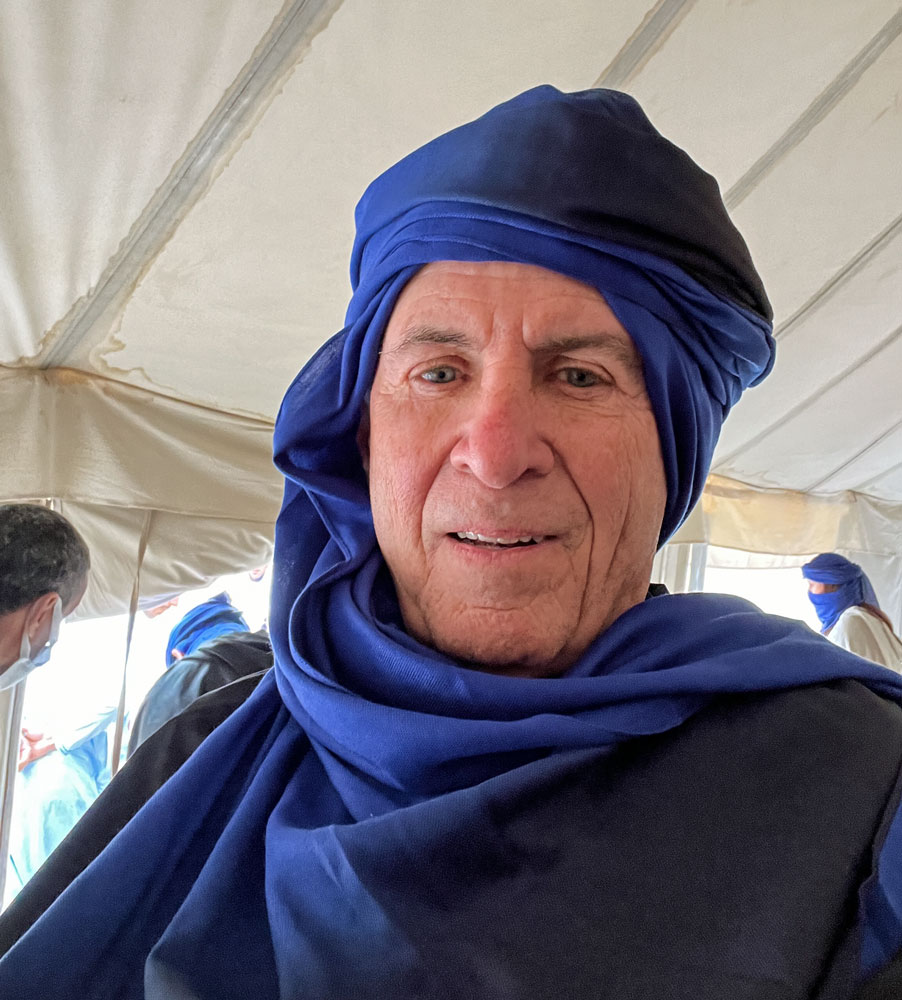
Here's the whole group in burnouse and scarves.
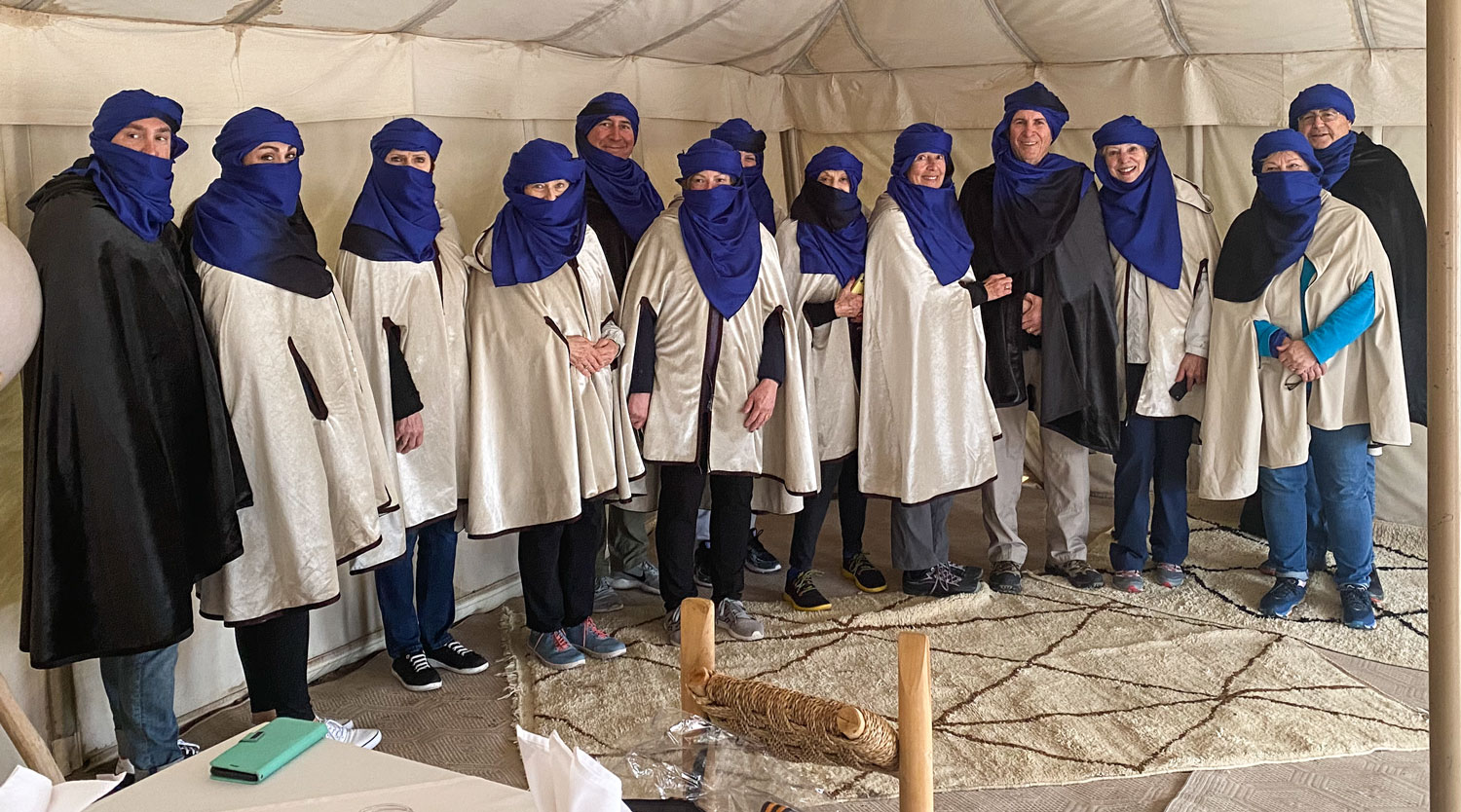
Then it was time for camel riding.
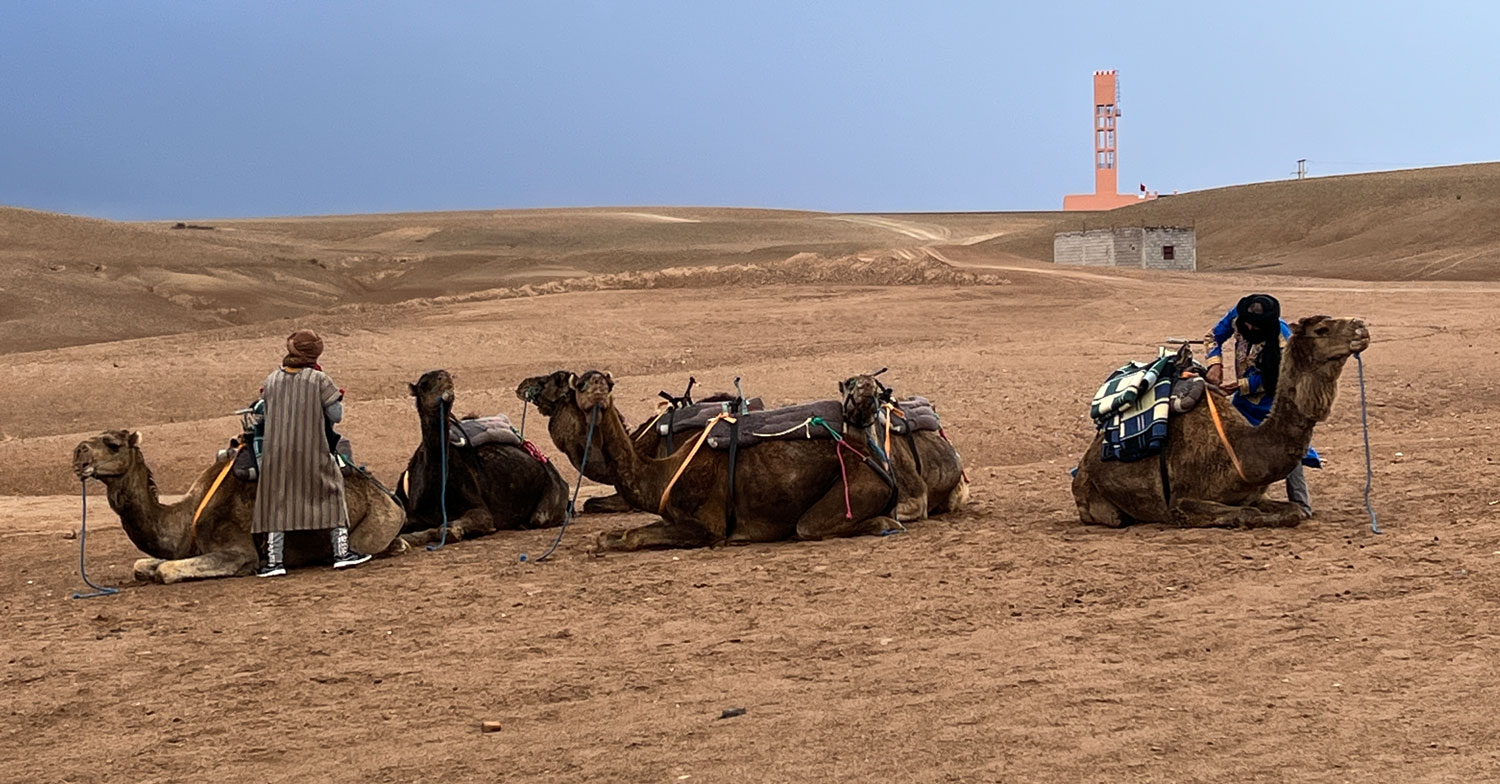
Judy getting ready to mount.
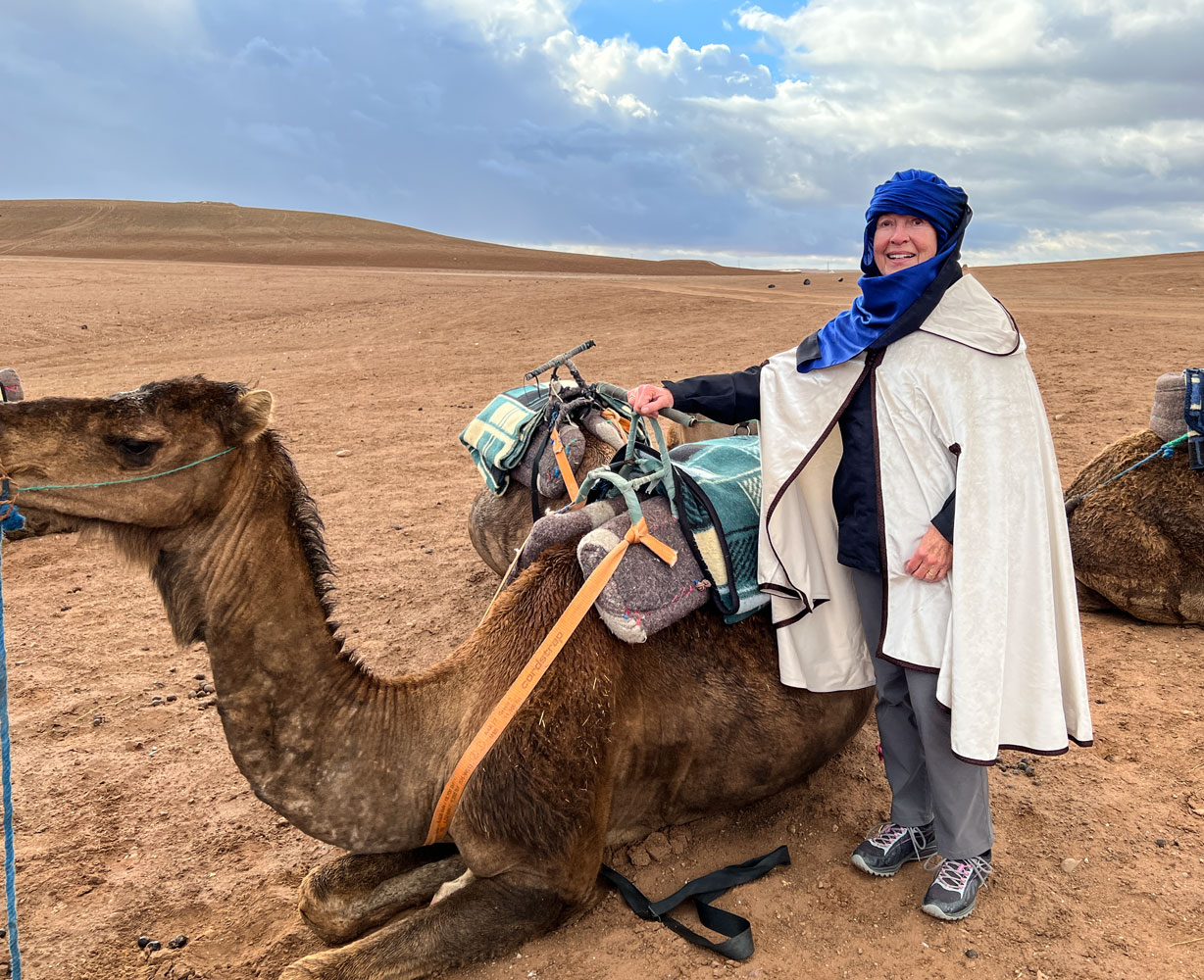
Here's Judy getting into the saddle.
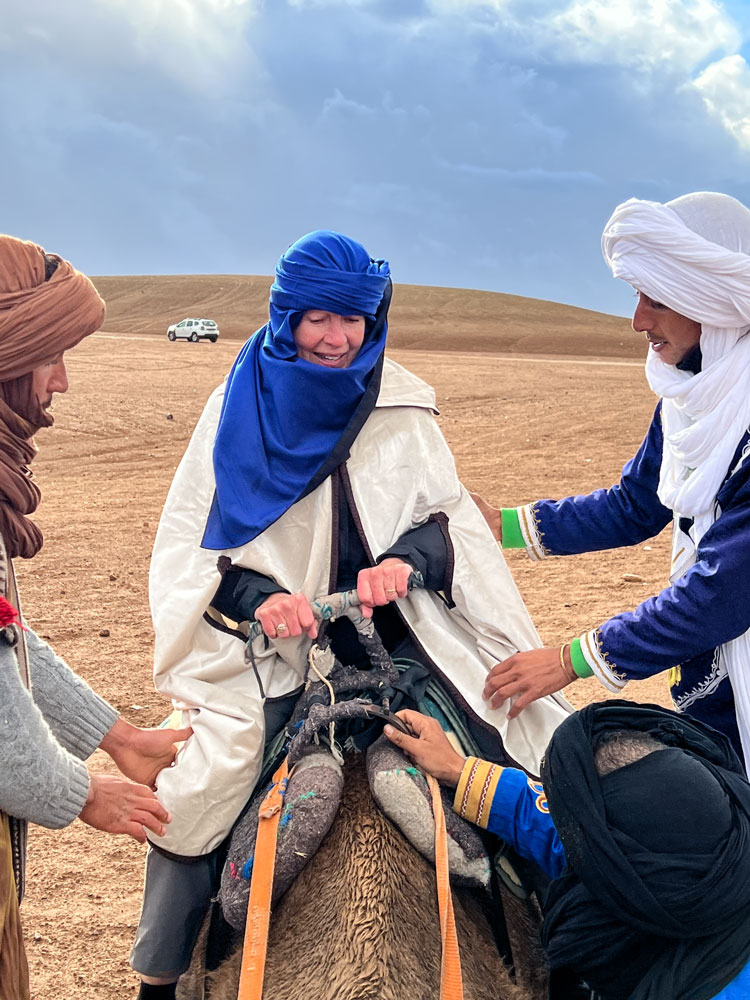
And she's up. You can see a rope net surrounding the camel's nose. They are known to spit, and this is a great way to prevent being on the receiving end of that event. We had a great sky background - very dramatic.
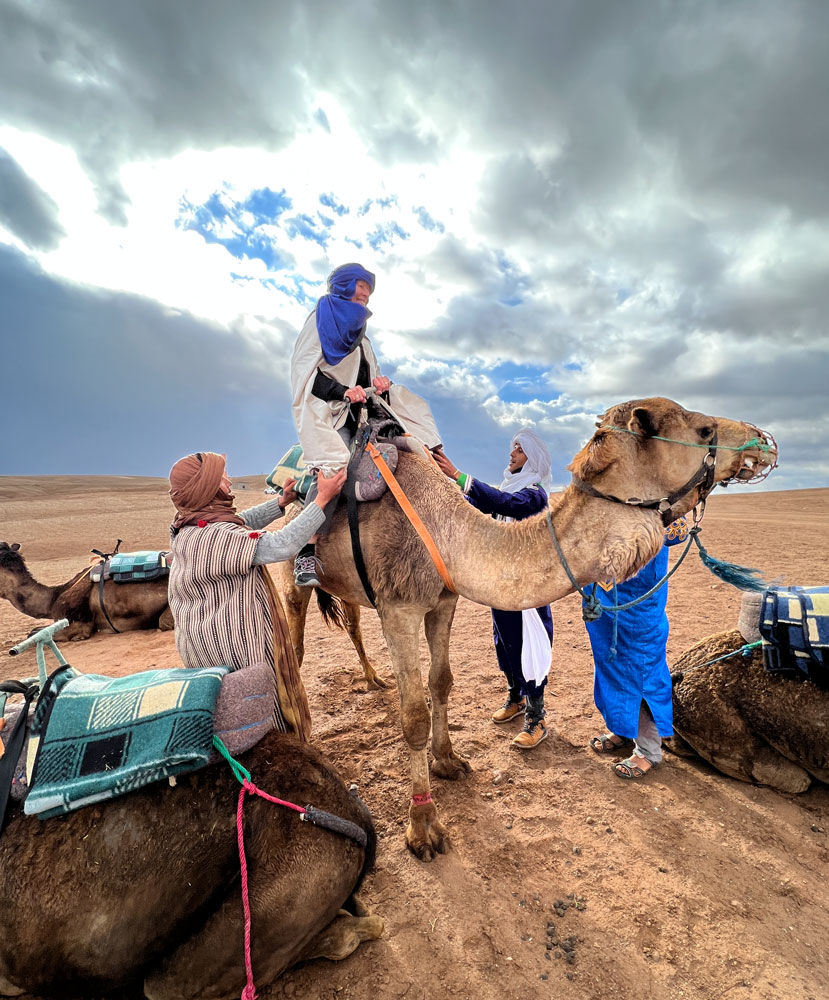
Here's Janet on a camel. I missed the picture of her when the camel got up.
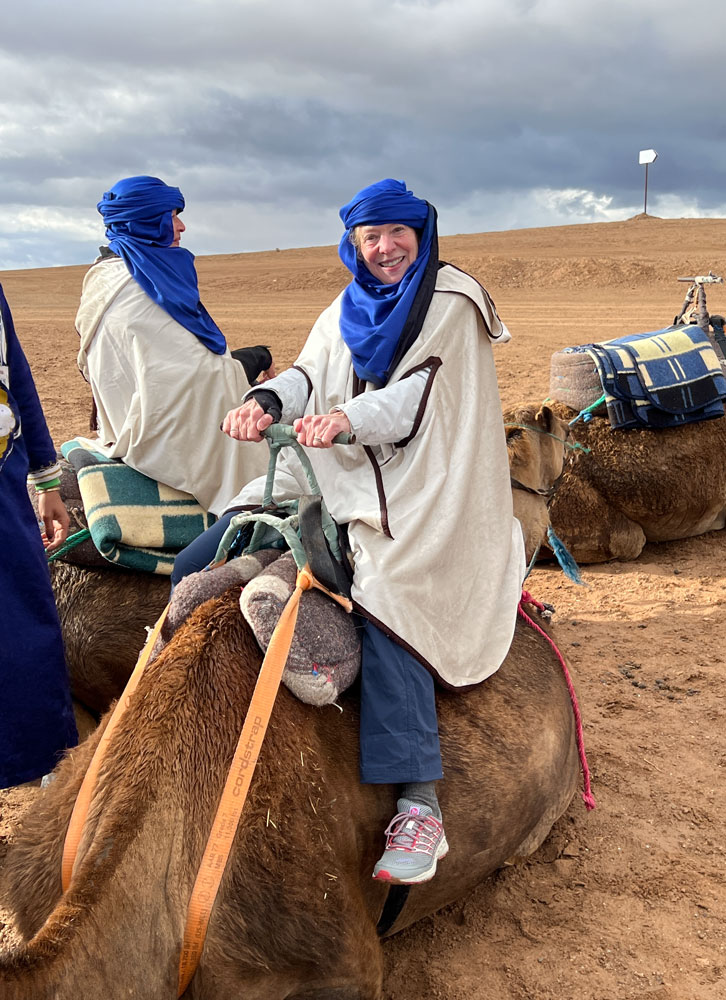
Janet gave her camel a hug when she finished the ride.
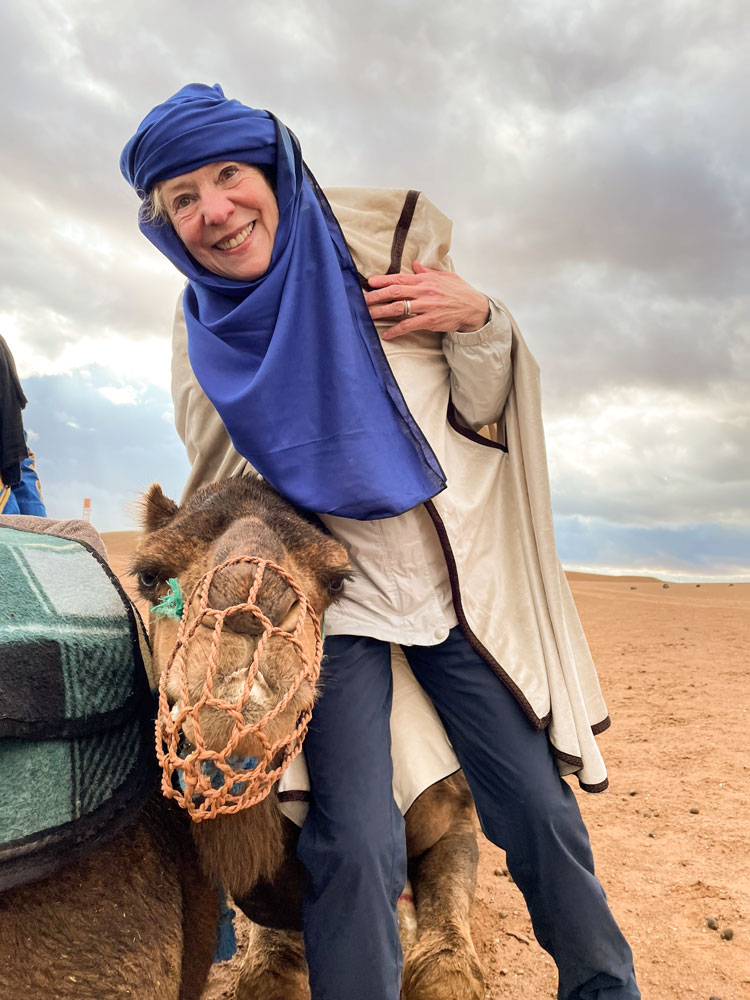
I got on a camel, also. A side note about iPhone cameras. I can definitely tell a difference in photo quality between photos taken with my phone (iPhone 13 pro) and photos that were air dropped to me. Apple improved the photo quality in the 13.
Most people have their iPhone set to take pictures in HEIC format and I have to convert them to JPEG to edit them. It's possible the conversion process affects the quality. I set my iPhone to take pictures in JPEG when we go on a trip. [Update: I figured out that if I to to Settings and set the "Photos" to Automatic on "Transfer to Mac or PC" I'll get the photos on my PC as JPG. That's much easier.]
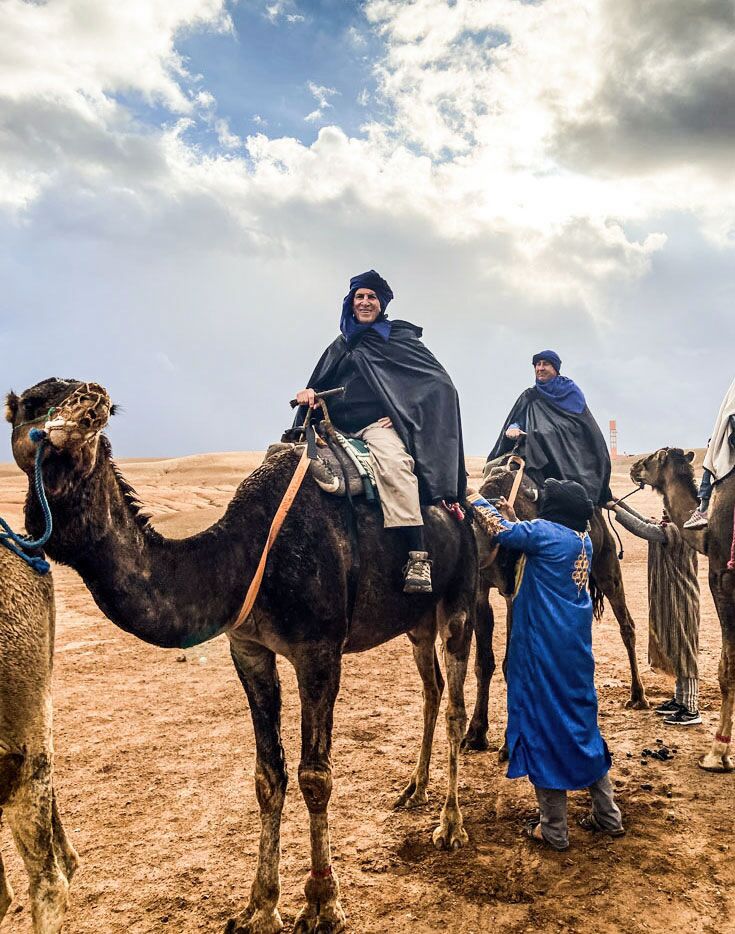
Judy is on the camel in the rear. Makes me think of Lawrence of Arabia. This was a stunning desert landscape, absolutely breathtaking.
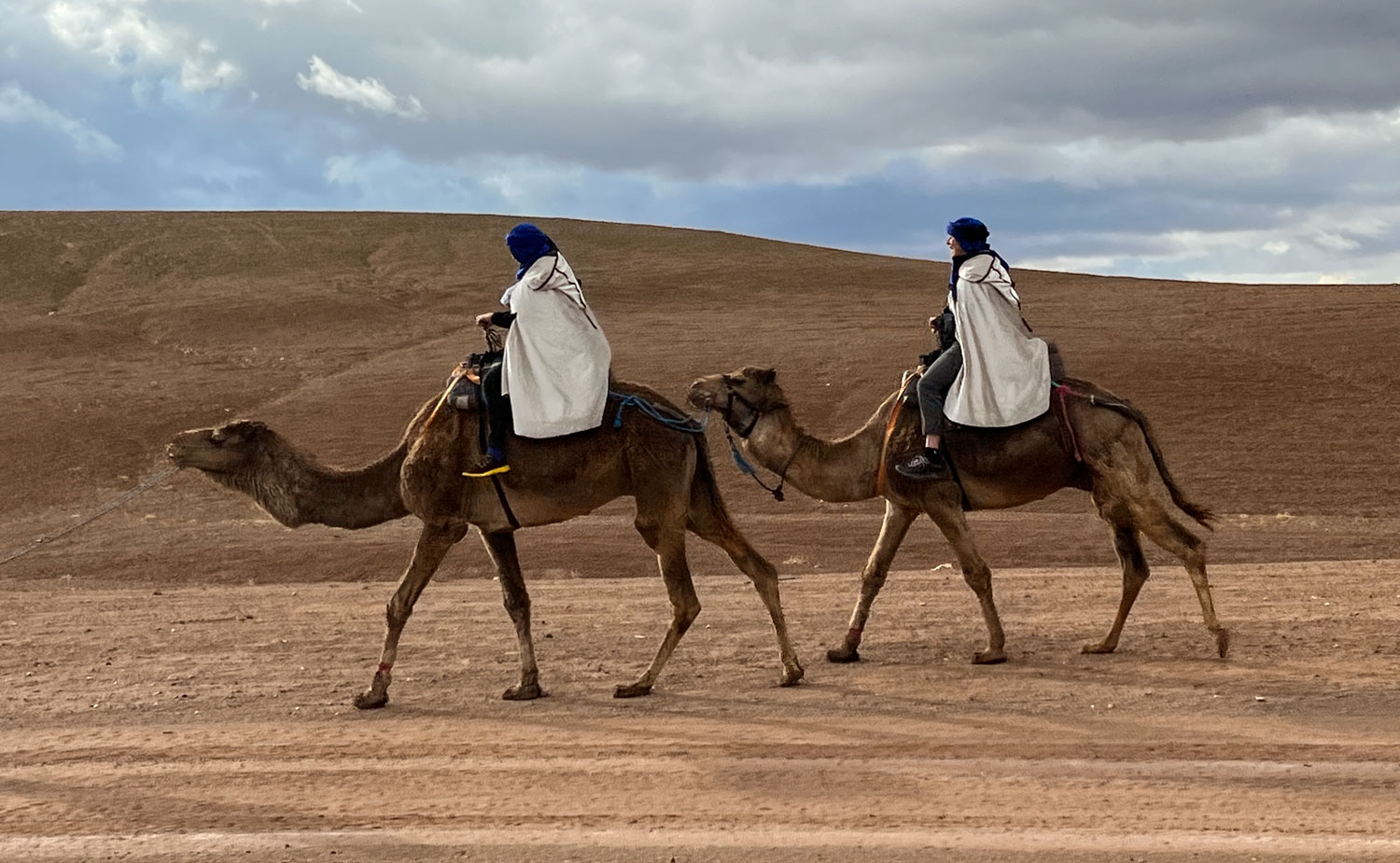
More of our group on a camel ride.
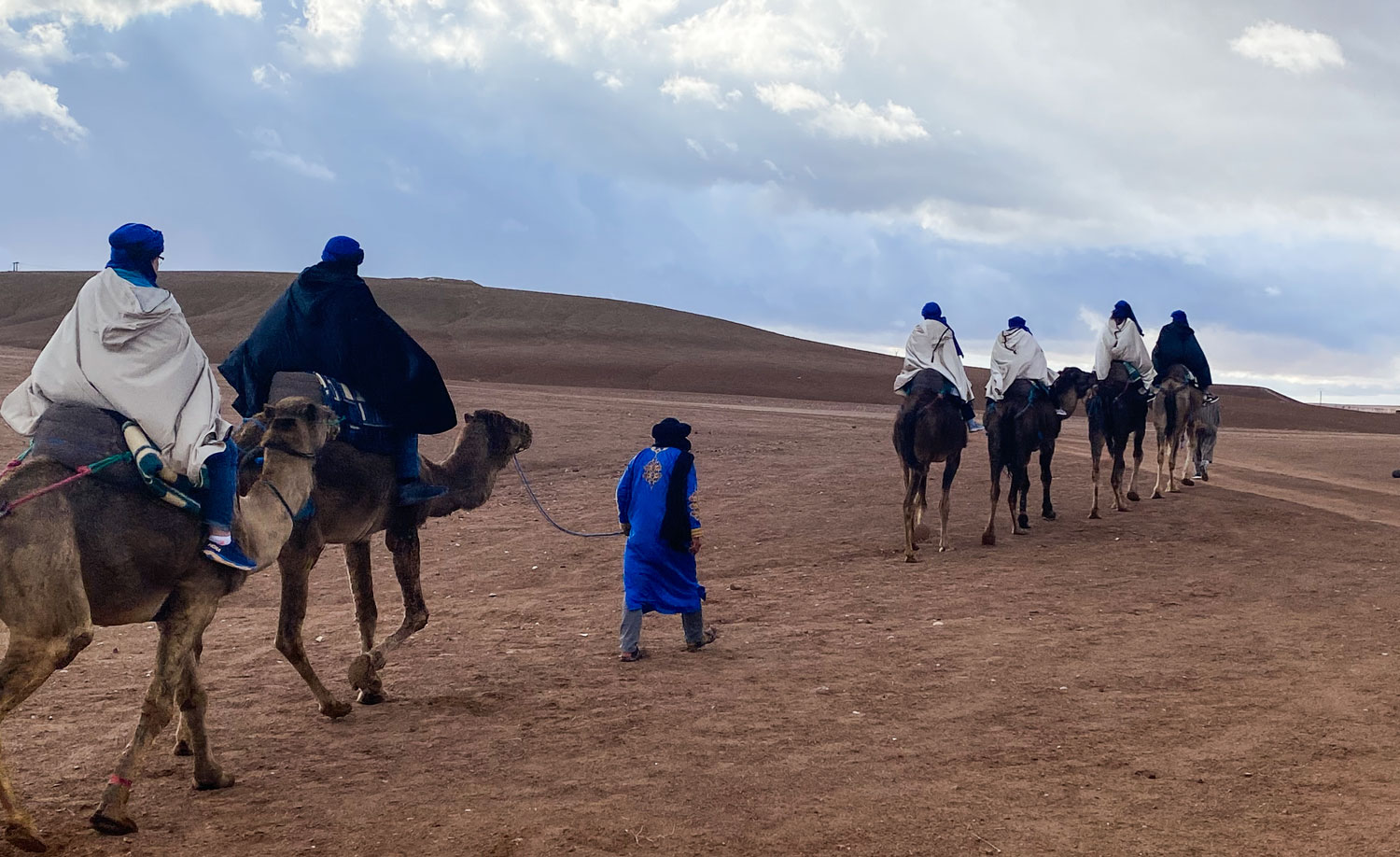
Here are Chris and Jeff Bennett in the desert. The men were in black burnouses and the women had white ones. Jeff is one of the two Tauck tour directors "shadowing" this tour.
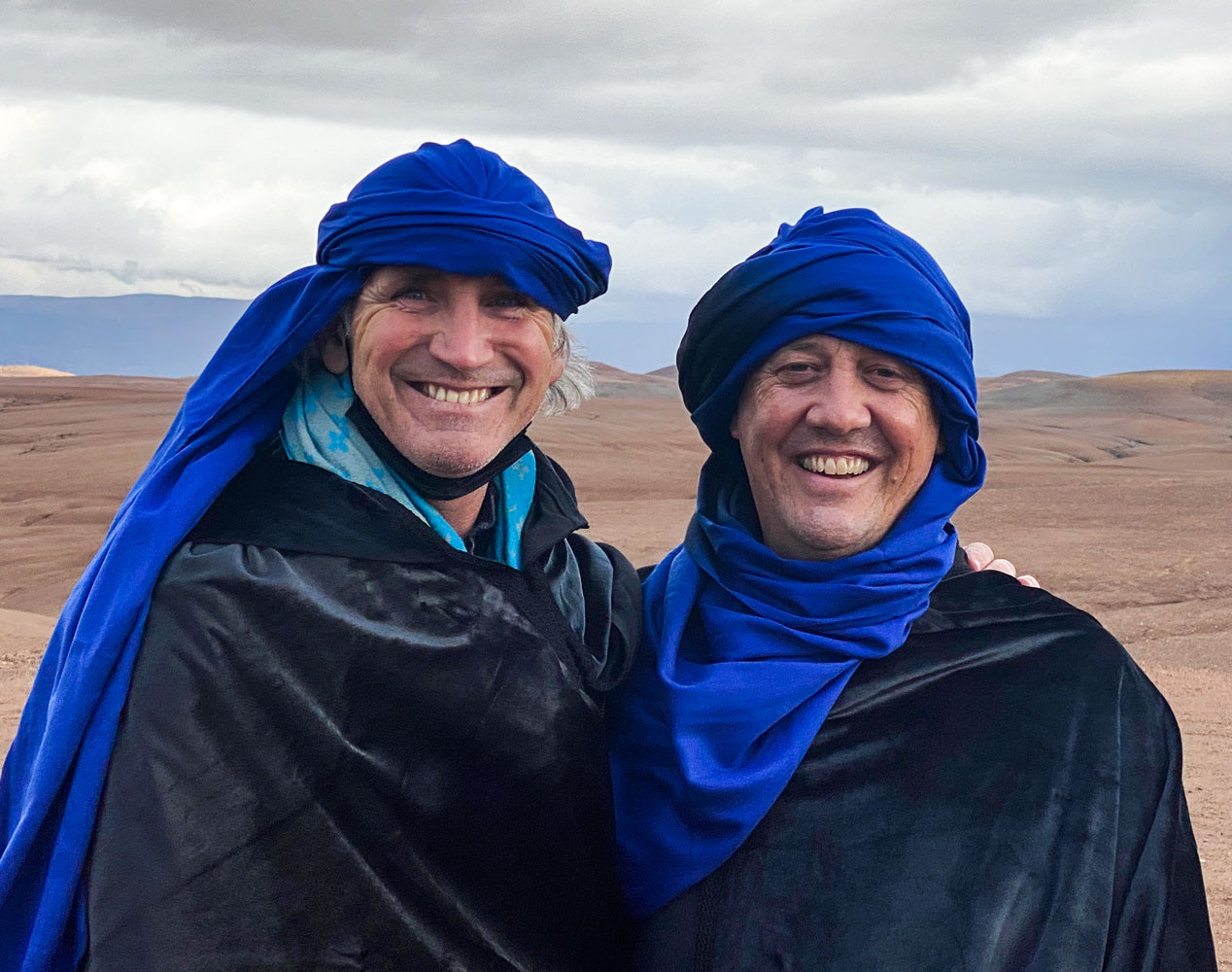
Then we went back to the welcome tent where they were serving drinks. There was a woman doing designs in henna on people's hands and Judy had a design done on her hand.
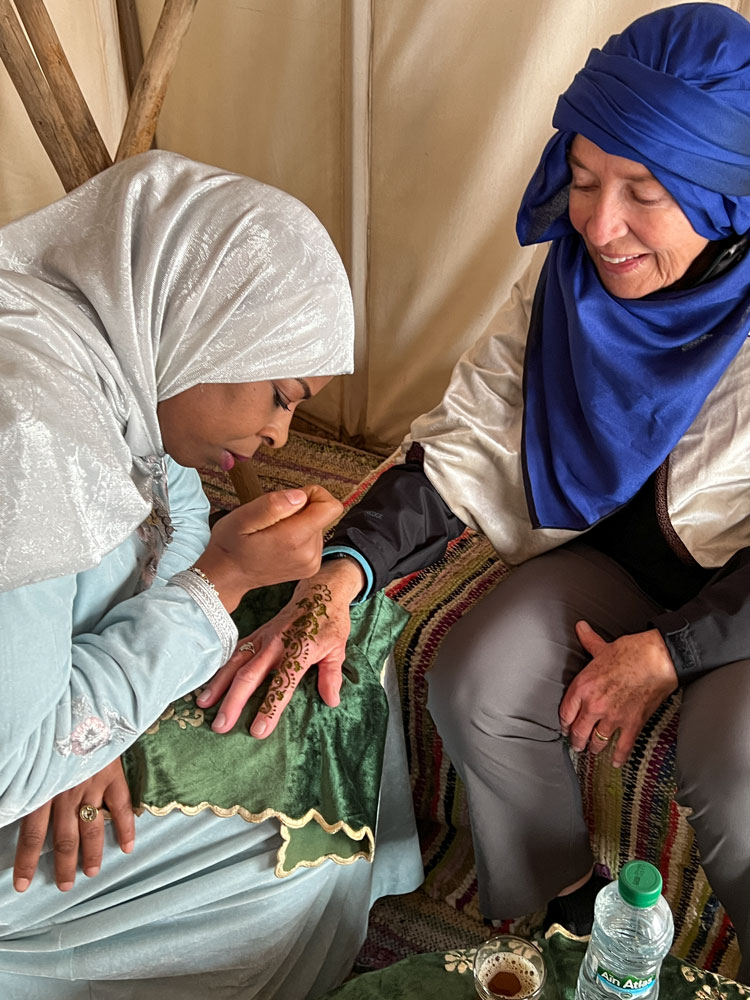
Here's the result.
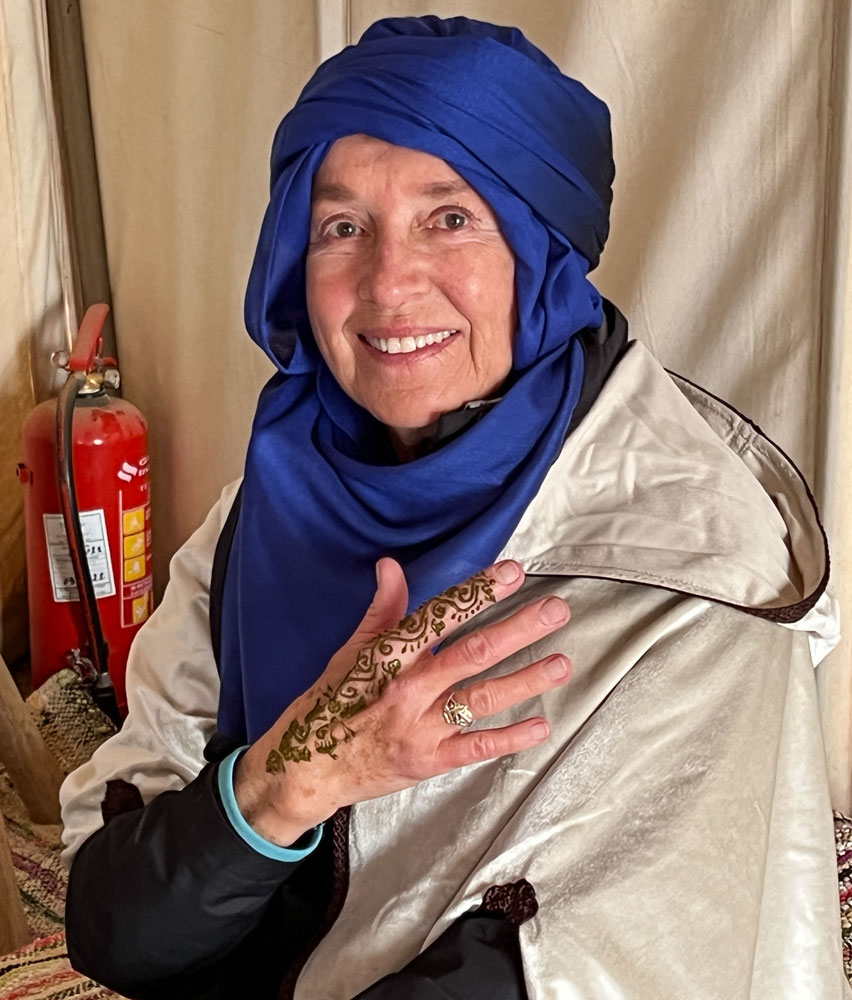
After she finished with Judy, I sat down to have some henna put on my hand. The woman looked at me in a strange way - perhaps men do not get henna in Morocco. But what I wanted was for her to put "JUDY" on my hand in henna. It took some communicating, but she did.
But henna is a problem. You have to let it dry on your hand, and we were active - we brushed our hand against something which smeared the design. Also, the henna did not mark the skin very well. After letting it sit on our hands until it dried, we washed it off and there was only a very light mark on our skin.
After the rain, there was a very distinct rainbow in the sky. We could see the complete arc, with both ends touching the ground. I took this picture of one side of the rainbow because it was a bit stronger on this side. This rainbow was a perfect gift for the landscape.
If you look closely you'll see a second arc to the right of the primary arc, and the colors in the secondary arc are reversed from the primary arc. This is called a "double rainbow" and is fairly common. Note, also, that the area between the primary and secondary arc is darker than the rest of the sky. This is called Alexander's Dark Band, named after Alexander of Aphrodisias who first described it in 200 AD.
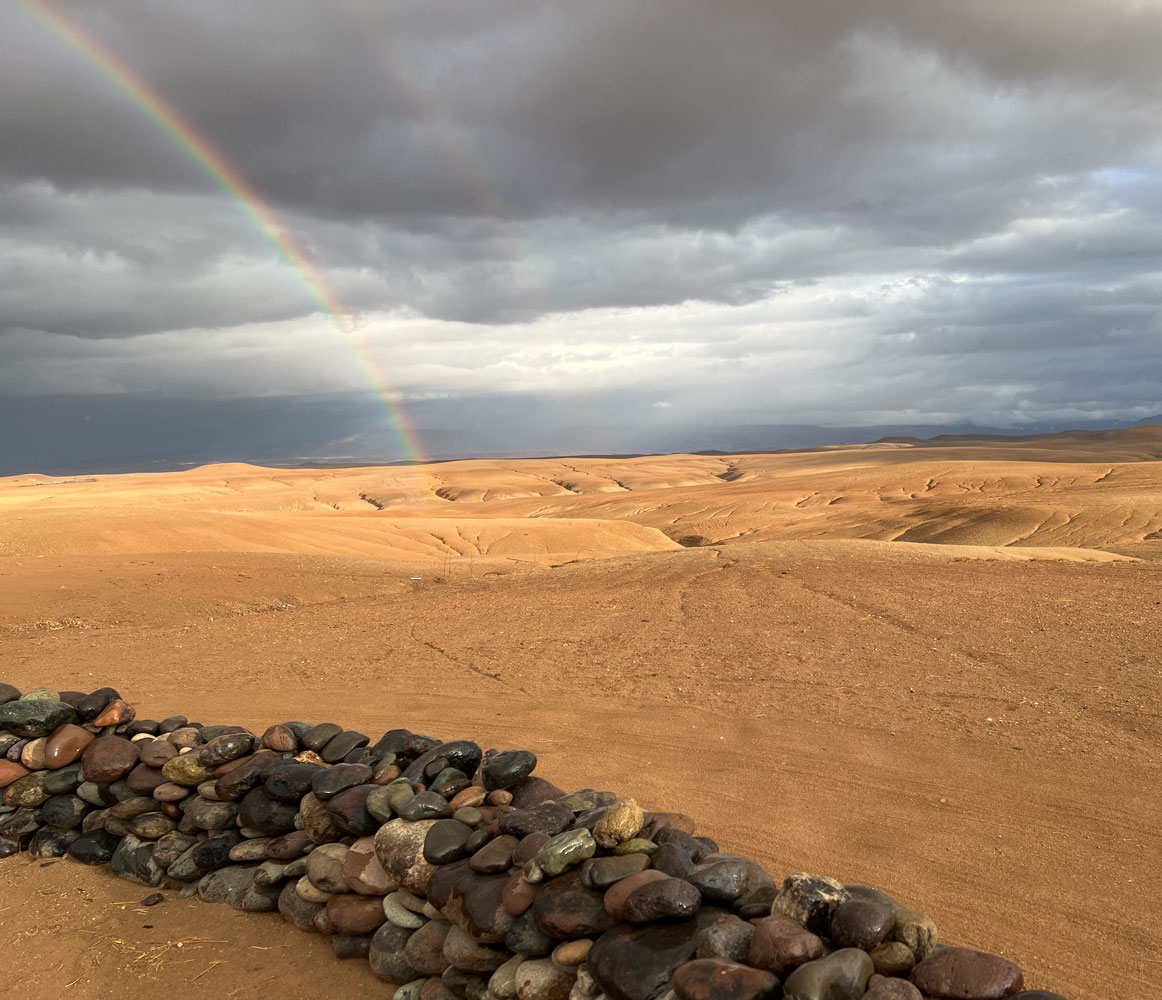
Then we had dinner by candlelight.
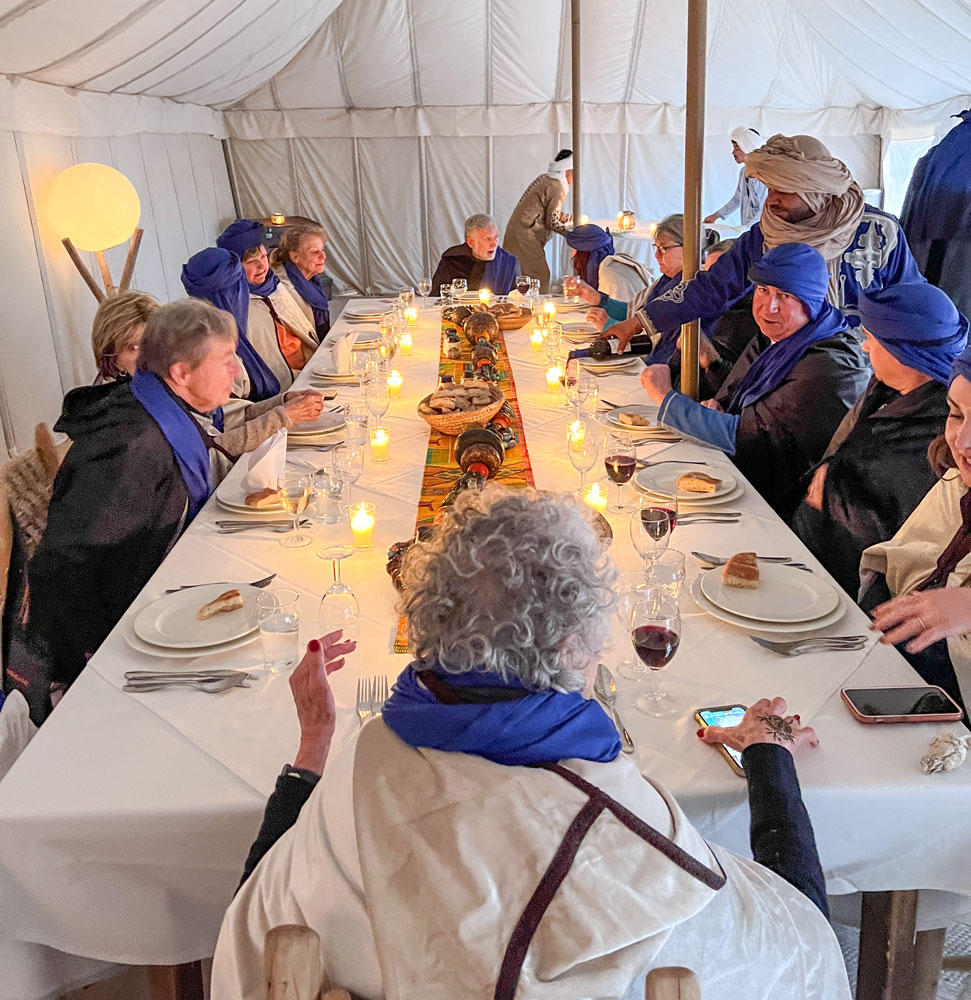
After dinner, Chris called us out of the tent to watch a "fire show". I missed recording some of his show because of a phone error on my part. What I do have is in the video which follows this picture.
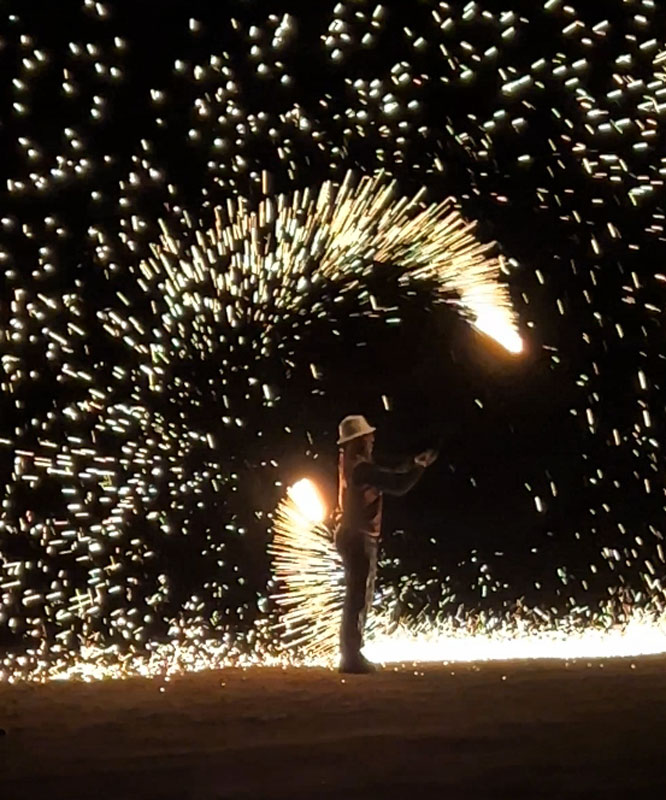
Here's a summary video of our desert excursion, made up, mostly, of short clips. The video starts with the two musicians who were playing when we arrived - to welcome us - but then moves to short clips. Check out the way the one musician twirls the tassel on his hat.
After this, we headed back to the hotel. That was the end of this day.